|
Monthly Special Sales!
10%
- 50%
off on select items or pages.

Select
Subject Pages Below:

This
Month's Catalogue
Page.
Items
Just Received








Books
by Tom Tag












SS
Portland
Portland
Gale
Pendleton
Fort Mercer 1952 Chatham





























































Lighthouse
Blog
Climate
Change

| |
U.
S. Life Saving Service
Antiques, Uniforms, Photos, Books and more.
We are continually acquiring wonderful and rare
original
antiques and implements relating to the U.S. Life Saving Service. Below are photos and information. Inquiries welcomed.
For
other items relating to the Life Saving Service, please look at our other
pages as well including: Engravings,
Books - Recent
Releases, Books - Antique, Uniforms,
Mass. Humane
Society, Rules
& Regulations, Souvenir
China, Books by James Claflin, Cape
Cod, Atlantic
City, Charts
& Documents, etc.
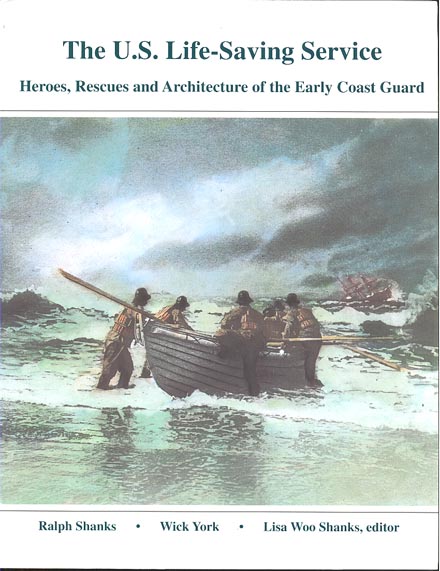
We have purchased
the publisher’s last remaining stock of this title. There will be no more
after these have sold.
6275s. Ralph Shanks, Wick York, Lisa Woo
Shanks, editor. THE
U. S.
LIFE-SAVING SERVICE - HEROES, RESCUES AND ARCHITECTURE OF THE EARLY COAST
GUARD. 1996.
Petaluma
, CA. 262p. Winner of the first Foundation for Coast Guard History Award
for Best Book on Coast Guard History, this long
heralded work by Ralph Shanks and Wick York is once again
available. Filling a longtime void in the chronicles of the Life-Saving
Service, this book is the result of two decades of research by these
highly respected maritime historians. In 272 large format pages, the
authors present unforgettable stories of the surfmen and their unsurpassed
bravery. Unique to this work is the authors coverage of the architecture
of each of the stations across the country. Using over 400 rare photos from the Library of Congress
and other historic sources, the authors provide a station by station look
at the architectural features that make them such a unique and
unforgettable piece of our history. Considered the best reference on
the U.S. Life Saving Service on the market. (M). Softcover
$34.95 while they last.
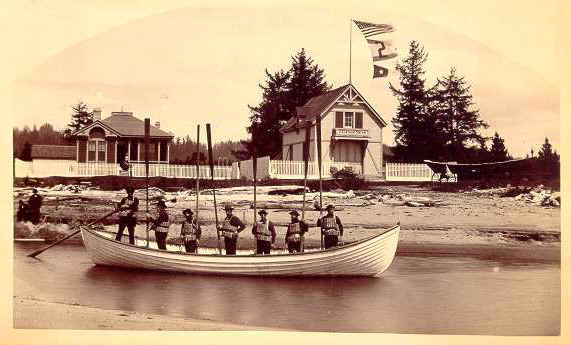

28348.
Wilkinson, William D. and CDR Timothy R. Dring, USNR (Retired). American
Coastal Rescue Craft - A Design History Of Coastal Rescue Craft Used By The
United States Life-Saving Service And The United States Coast Guard. University
Press. 2009. 185p. Unjacketed cloth. With CD-ROM with 323 b/w illustrations.
Long awaited, this exhaustive reference work describes detailed history and
technical design information on every type of rescue craft ever used by the U.S.
Life Saving Service (USLSS) and the U.S. Coast Guard (USCG) from the 1800s to
current day. By looking at these vessels, many of which featured innovative
designs, the authors shed light on the brave men and women who served in these
heroic services. The first of its kind ever to be published in the United States
on this topic, the book and accompanying CD provide detailed information,
drawings, and photographs (many of which have never before appeared in print)
for each type of surfboat, lifeboat, and utility craft, along with a complete
list of every boat ever built and assigned coastal rescue station(s). Included
are motorized, wind-powered and human-powered vessels. The book is organized
into two major sections: 1) a general, historical narrative, and 2) detailed
technical appendices. This college text-sized book is 185 pages in length, with
about 140 photos and diagrams. In addition, a reference/appendix section on a
co-packaged CD will include 323 additional photos and diagrams. The book is
co-authored by William D. Wilkinson, Director Emeritus of the
Mariners
Museum
in
Newport News
,
VA
, and CDR Timothy R. Dring, USNR (Retired). Mr. Wilkinson has been engaged since
the 1950s in the historical research of small craft used for rescue purposes,
and is a well-recognized expert in this field. He is currently an official
historical consultant to the USCG on this subject. CDR Dring, although not a
professional historian, has had previous experience in the Navy working closely
with the Coast Guard on harbor and coastal defense, and has a great interest in
and respect for the humanitarian rescue operations this Service conducts with
specialized small craft. The extensive research that went into this book,
including reference to original USLSS and USCG documents held by the National
Archives, has had the full support of the USCG’s Historian, Dr. Robert
Browning, and his staff. The most comprehensive work on Coastal Rescue Craft
used by the United States Life-Saving Service and the United States Coast Guard
ever published. (M). $125. Order
now as only a limited number have been printed.
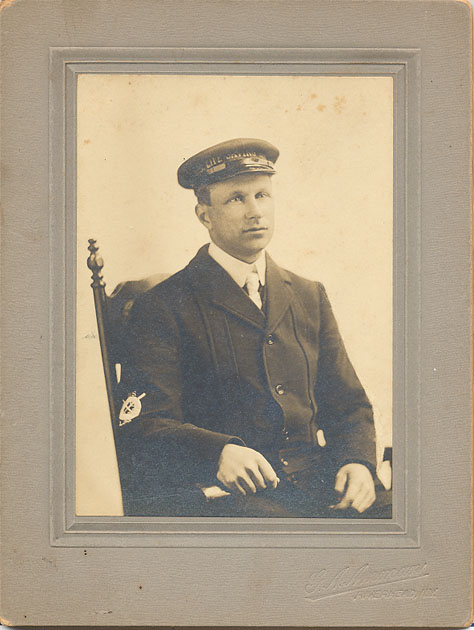
1269b. [cabinet photograph] Life-Saving
Service Surfman Frank Tuttle, Long Island, New York c.1890-1900. This
rare posed original portrait photograph shows the clean-cut surfman proudly
posing in his 4-button single-breasted uniform coat. Clearly visible on his
right sleeve is the life ring with crossed oar and pike and the letters “US”
“LSS”. On his cap is a tally lettered “U.S. Life-Saving Service”. The
image measures 4” x 5 ½” on a 6” x 8½” original mat. Mat stamped G.A.
Aneman, Riverhead, N.Y.” Photo is clear, and crisp, one of the better
images we have had in some time. On back is labeled in ink: My Great Uncle Frank
Tuttle, U.S. Life-Saving Service…. CWO4 Alvin E. Penny U.S.C.G.” It is
exceptionally rare to see such photos of surfmen in any format. (VG+). $225.
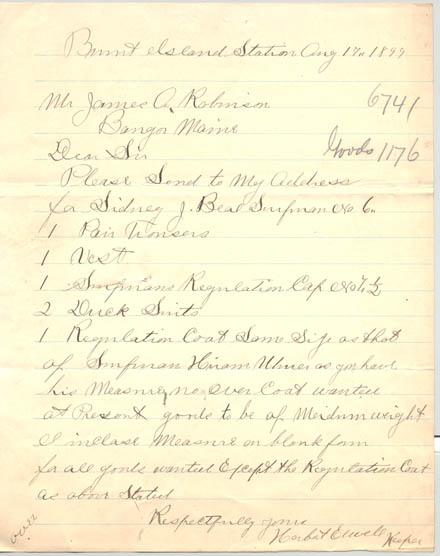 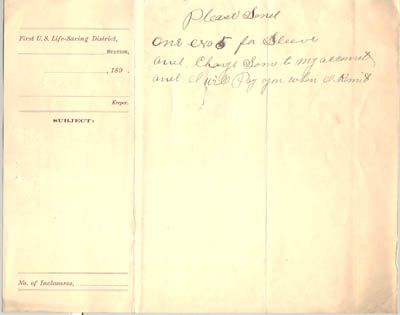
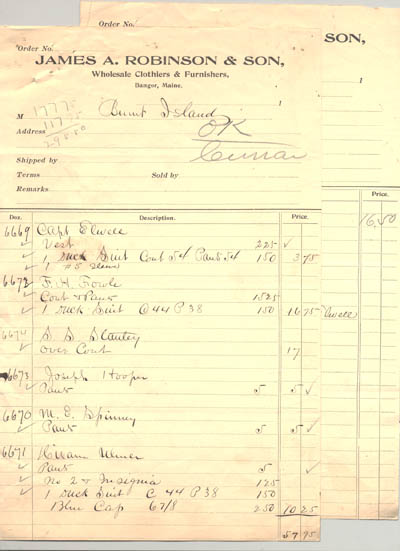 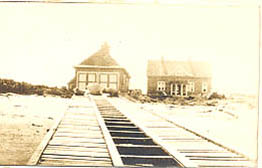 (photo not included)
(photo not included)
1234-10. (lot 2 documents) U.S.
Life-Saving Service, First District, Burnt Island Life-Saving Station, Maine
c.1899. Herbert Elwell, Keeper. Lot consists of two documents (3
sheets) relating to clothing orders for the crew at the station. The first is an
original hand-written letter by the keeper on Life Saving Service letter sheet,
8” x 10”, to James A. Robinson & Son (clothiers), of Bangor, Maine,
regarding an order for the uniforms for Sidney J. Beal Surfman No. 6 for
trousers, vest, regulation cap, duck suits, regulation coat. The second is 7”
x 11”(2 sheets) containing hand written notes on uniforms (suits, pants,
etc.) with prices and some sizes, specs., etc., on order for men at the station.
Men listed include Capt Elwell, F.H. Fowle, S.S. Stanley, Joseph Hooper, M.E.
Spinney, Hiram Ulmer, Sidney J. Beal #6. Both overall clean, light wear. Rare
Burnt Island LSS lot. (VG+). $78.
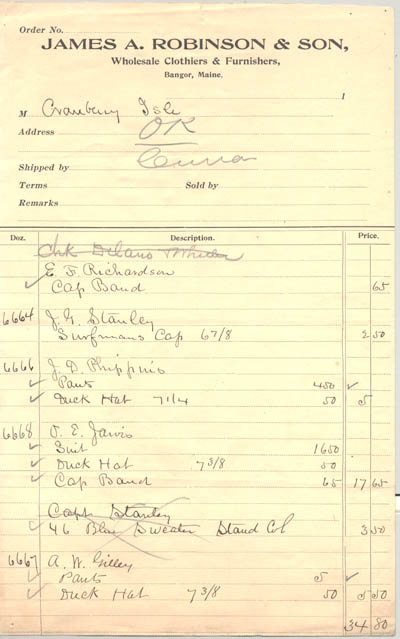 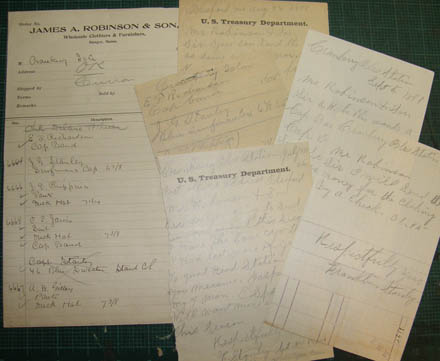
1234-37. (lot 6 documents) U.S.
Life-Saving Service, First District, Cranberry Islands Life-Saving Station,
Maine c.1899. Franklin Stanley, Keeper. Lot consists of six documents
relating to clothing orders for the crew at the station. The first are five (5)
original hand-written notes by the keeper, 5” x 8”, with sizes and notes on
uniform needs, prices, what and where to send, etc. The second is 7” x
11” containing hand written notes on uniforms (suits, pants, etc.) with prices
and some sizes, specs., etc., on order for men at the station. Men listed
include Capt Stanley, E.F. Richardson, J.G. Stanley, J.D. Phippino, E Jarvis,
A.W. Gilley. All clean, light wear. Rare Cranberry Islands LSS lot. (VG+). $48.
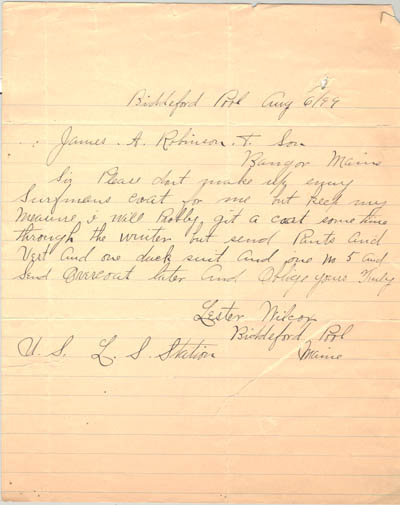 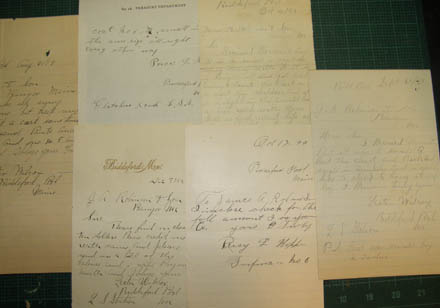
1234-15. (lot 6 documents) U.S.
Life-Saving Service, First District, Biddefford Pool [Fletchers Neck]
Life-Saving Station, Maine c.1899. Lester Wilcox, Keeper. Lot
consists of six documents relating to clothing orders for the crew at the
station. The first are five (5) original hand-written notes by the keeper, 5”
x 8”, with sizes and notes on uniform needs, prices, what and where to send,
etc. The second is 8” x 10” letter on lined paper regarding uniform order
for station crew. Signed in hand by Keeper Wilcox. Men listed include Capt
Wilcox, Percy L. Hoppe. All clean, light wear. Rare Biddeford Pool / Fletchers
Neck LSS lot. (VG+). $225.
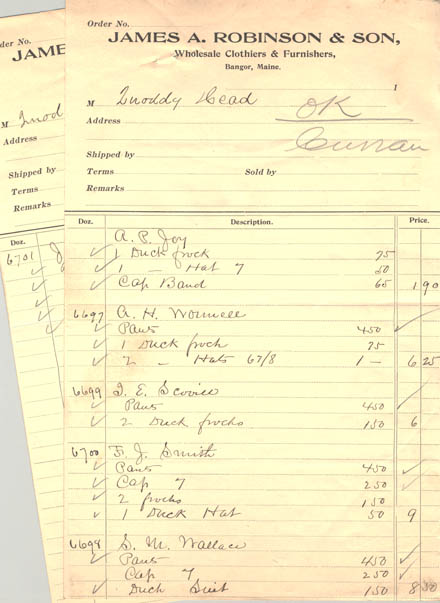
1234-36. (lot 1 documents - 2 sheets) U.S.
Life-Saving Service, First District, Quoddy Head Life-Saving Station, Maine
c.1899. Lot consists of two sheets relating to clothing orders for
the crew at the station to James A. Robinson & Son (clothiers), of Bangor,
Maine. The sheets are 7” x 11” containing hand written notes on uniforms
(suits, pants, etc.) with prices and some sizes, specs., etc., on order for men
at the station. Men listed include A.P. Joy, A.H. Wormwell, J.E. Scovill, F.J.
Smith, S.M. Wallace, John Shannon. Rare Quoddy Head LSS lot. (VG+). $34.
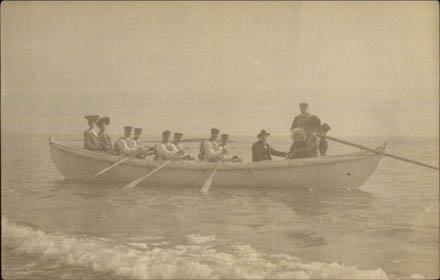
3039. (photo) U.S.
Life-Saving Service Surfboat Crew, Hampton Beach, NH., c.1900.
(photo) Close photo shows Hampton Beach Life-Saving Crew as they treat a group
of charming Victorian visitors to a short surfboat ride. Boat lettered
"Hampton Beach" on stern. Great photo on post card paper. Size 3 ½”
x 4 ½”Clean crisp, near fine. (F-). $38.
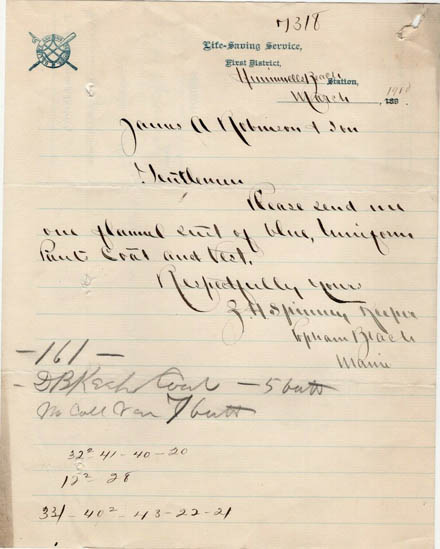
1234-53. U.S.
Life-Saving Service, First District, Hunniwells Beach Life-Saving Station,
Maine. March 1900. E. H. Spinney, Keeper. Original 1-page
hand-written letter from Keeper Spinney to James A. Robinson & Son
(clothiers), of Bangor, Maine, requesting a complete flannel suit [uniform] for
himself in blue including pants, 5-button coat and vest. 8” x 10” on
official Life-Saving Service stationery. Rare First District documents in
overall clean condition. (VG+). $74.
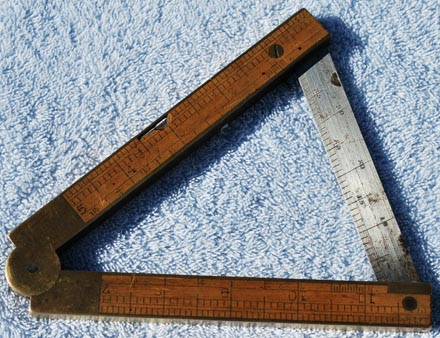
27361y.
U. S.
Life Saving Service Lyle Gun Folding Octant c.1878-1901. This type
of octant, or elevation level, was used by the Life Saving Service and later
Coast Guard for setting the elevation of the Lyle Gun. From 1878 until 1901 the
Life Saving Service use this octant, made by the Chapin Stephens & Co in
Riverton
,
Conn.
In 1901 when this company ceased operation, the government began to make their
own elevation levels. However these were entirely of metal, lighter and of a
lesser quality. Octant is made of boxwood, brass bound and includes a metal
fold-out scale for setting the angle, with a bubble level set into the upper
arm. The octant was carried by the keeper in his haversack. Marked very lightly
“No. 036 The Chapin -Stephens Co Conn. USA”, much of which has worn off over
the years. Clean, bright, light rust remains to scale, two chips to the
boxwood on each side of the bubble level. Scarce, early piece. (VG). $295. Sale
$265.
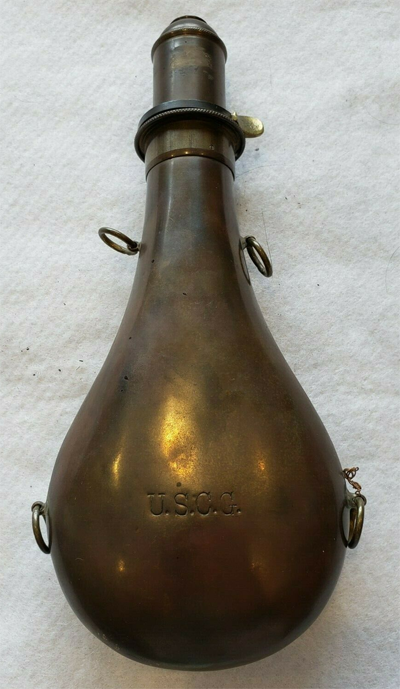
8152L. (powder flask) U.S.
Coast Guard Powder Flask for Lyle Gun c.1900. Early
Coast Guard powder flask used by the station crews for priming the Lyle Gun.
Flask is of brass and copper construction and measures 10 ½” in length, with
four brass loop hangers. On each side of the body of the flask are stamped the
initials “U.S.C.G.”. This original powder flask has no dents but a 2”
secrion of the seam is starting to open. The spring in the charger nozzle is
still intact and operable, with original screw-on spout. Surface has expected
tarnish but will polish up to a beautiful shine. Coast Guard flasks are even
more difficult to find than those of the Life Saving Service as there were far
less made and used. Overall a most presentable and rare example of this early
Coast Guard powder flask. (VG+). $1,450.
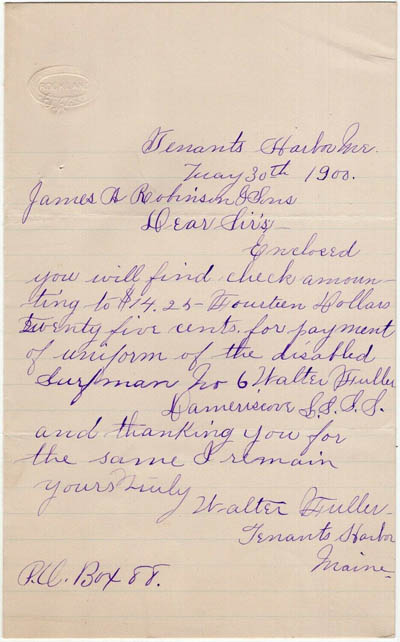
1234-54. (document) U.S.
Life-Saving Service, First District, Damiscove Life-Saving Station, near
Boothbay Harbor, Maine c.1900. Hand written letter to James A.
Robinson & Son (clothiers), of Bangor, Maine, offers payment for uniform for
“the disabled Surfman No. 6 Walter Fuller of the Damiscove Life-Saving
Station. Written and signed in hand by Surfman Fuller. One sheet, folded to 5”
x 8”and dated May 30, 1900. Overall quite clean. Rare Damiscove piece. (VG+).
$48.
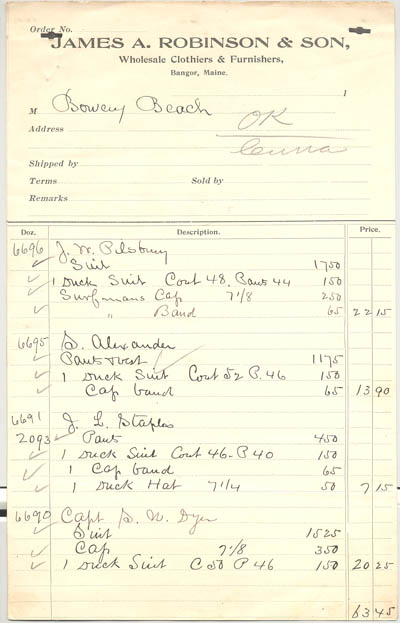
1234-40. (document) U.S.
Life-Saving Service, First District, Cape Elizabeth Life-Saving Station c.1899.
S.N. Dyer, Keeper. Original document on stationery of James A.
Robinson & Son (clothiers), of Bangor, Maine relating to clothing orders for
the crew at the station. Two sheets 7” x 11” contain hand written notes on
uniforms (duck suits, overcoat, Keeper’s cap, surfman’s cap bands (tally),
pants, vest, etc.) with prices and some sizes, specs., etc., on order for men at
the station. Men listed include Surfmen: JW Pilsbury, S Alexander, JL Staples,
Capt SN Dyer, WP Staples, GE Staples, JA Barber. Two sheets attached. Rare First
District documents in overall clean, crisp condition. (VG+). $34.
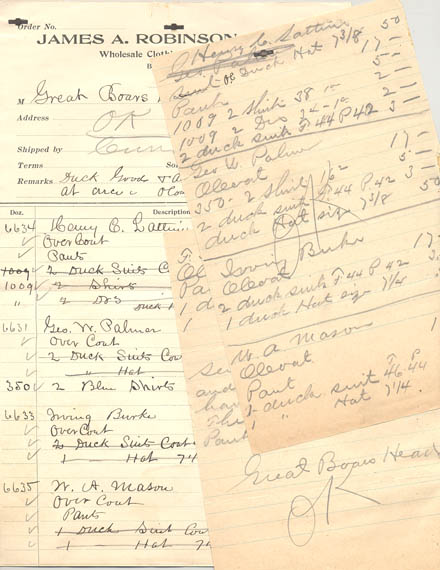
1234-38. (lot 2 documents) U.S.
Life-Saving Service, First District, Great Boars Head Life-Saving Station,
Hampton, NH. c.1900. B.F. Smart, Keeper. Original document on
stationery of James A. Robinson & Son (clothiers), of Bangor, Maine relating
to clothing orders for the crew at the station. Two sheets 7” x 11” contain
hand written notes on uniforms (duck suits, overcoat, cap, pants, vest, etc.)
with prices and some sizes, specs., etc., on order for men at the station. Men
listed include Surfmen: Henry C Lattimer, Geo W Palmer, Irving Burke, WA Mason,
FW Garland, Roderick McDonald. The second are two (2) original hand-written
notes by the keeper, 5” x 8”, with sizes and notes on uniform needs, prices,
what and where to send, etc. Rare First District documents in overall
clean condition. (VG+). $42.
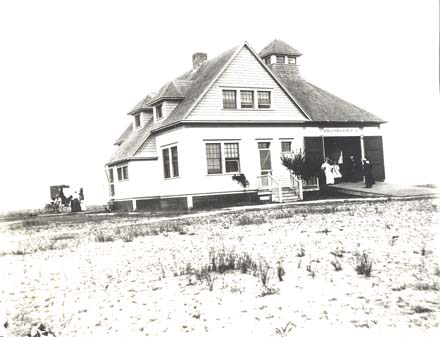
3050. (photo) U.S.
Life-Saving Station, Point Allerton, Hull, Mass. c.1890’s. Small
photo hand trimmed shows good detail of what we believe is the Point Allerton
Life-Saving Station in Hull, Mass from which noted life-saver Joshua James
launched numerous rescue missions. View is likely 1890’s but unsure age of
this print. Nice detail. Photo trimmed to about 3 ¾” x 4 ¾”. (VG+). $29.
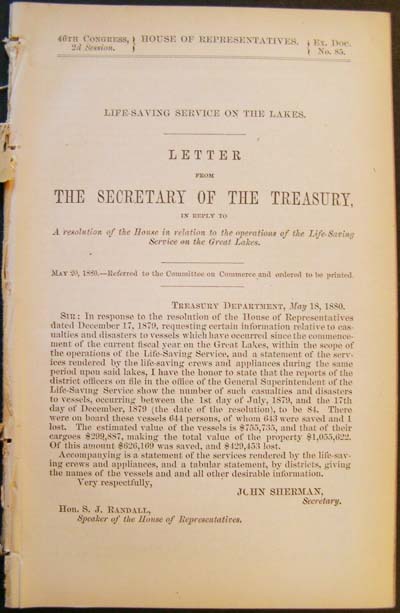 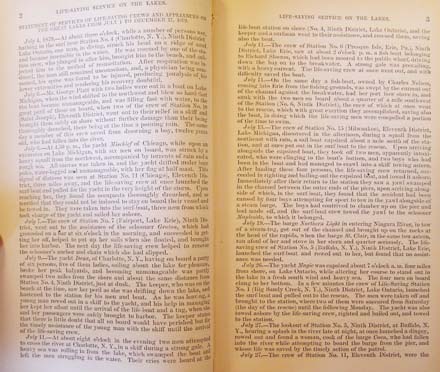
7354. H. R. Ex. Doc. No. 85. LIFE-SAVING
SERVICE ON THE
GREAT LAKES
. May 20, 1880. 33p. Disbound. Complete report of casualties and
disasters on the
Great Lakes
within the scope of the Life-Saving Service in the current fiscal year.
Includes detailed accounts of many wrecks, casualties and operations of the
Service on the Great Lakes from July 1, 1899 to December 31, 1879. During this
time there occurred 84 such wrecks, with 644 persons on board with the loss of
only one. Also includes detailed vessel name and location information, etc. Important
information and accounts. Clean, crisp. (VG+). $64.
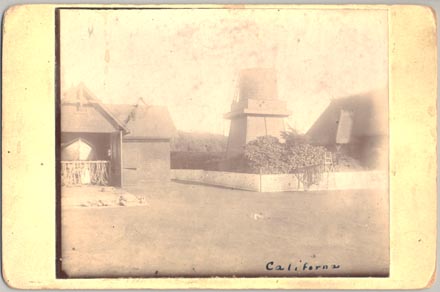
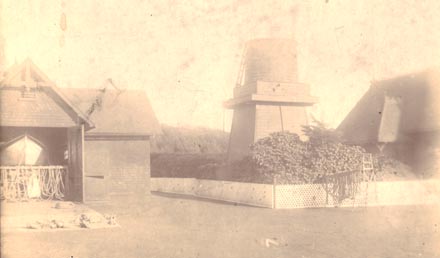
3068.
(mounted photo) U.S. Life Saving Station at San
Francisco's Golden Gate Park c.1890. The image is taken outside the
U.S. Life Saving Station located at the western end of San Francisco's Golden
Gate Park. The Golden Gate Park Life-Saving Station was a one-of-a-kind station
with buildings designed by architects J. Lake Parkinson and John G. Pelton. Note
the lifeboat-house/stable at the right. The three-story house/kitchen building
would be to the right, and the tower in the center is the water tower for the
station. Image measures 4” x 5” on 4” x 6 ½” mount. Image is clear,
just a bit light, on lightly soiled and marked mount. Very light crease does not
seriously affect image. (VG-). $44.
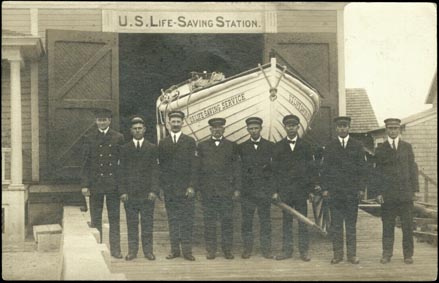
3066. (photo) U.S.
Life-Saving Station Crew Posing c.1910. Wonderful rare early image of
an early Bibb #2 Type life saving station, probably on the beach on Long
Island or New Jersey, as the crew poses with the surfboat in front. Photo is
clear, great detail, on AZO postcard paper (dates to 1904-1915) 3 ½” x 5 ½”.
Image is clear and close, providing great view of the 8-man crew, their uniforms
and the surfboat. Clear, crisp. (VG+). $88.
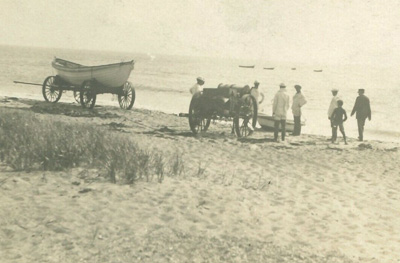
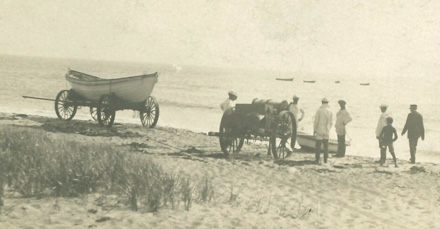
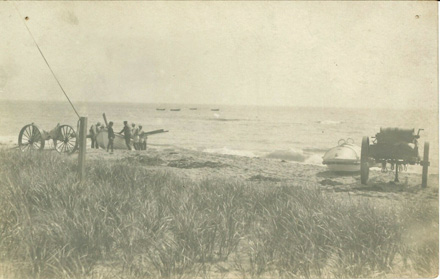
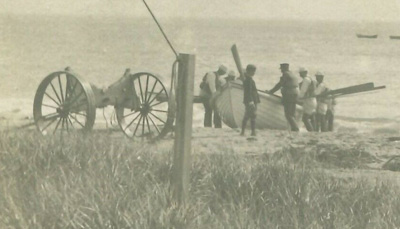
3093a,b.
(lot 2 photos) U.S. Life-Saving Crew Drilling on Beach.
Pair of superb clear, close photos show great detail of the surfboat, beach
apparatus cart and Francis Metallic Life Car on the beach as the Life-Saving
crew drills. Photos are clear, great detail, on postcard paper. 3 ½” x 5 ½”.
Only light soiling. (VG+). $145.
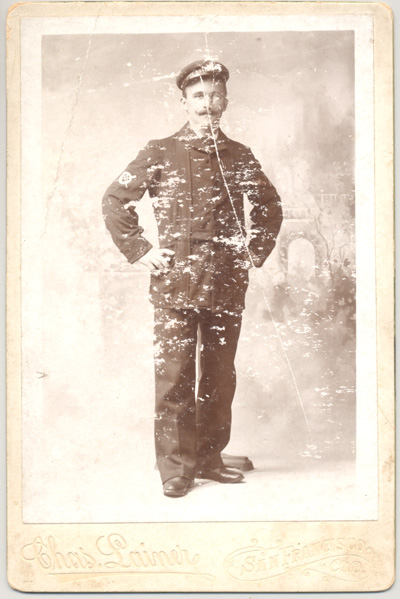
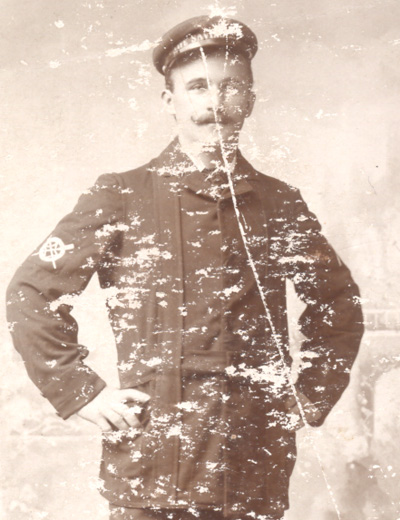
3096.
(cabinet photo) U.S. Life-Saving Service Surfman (San
Francisco area) c.1900. Clear close cabinet photo shows handsome
young surfman posing for the photographer in full uniform. Detailed view
includes regulation single-breasted uniform coat with Life-Saving insignia on
right arm, and hat with tally. View is by Chas. Lainere of San Francisco. Though
view is clear and close, there is heavy surface abrasion affecting the entire
image, as well as a fold in the upper left corner. (P+). $54.
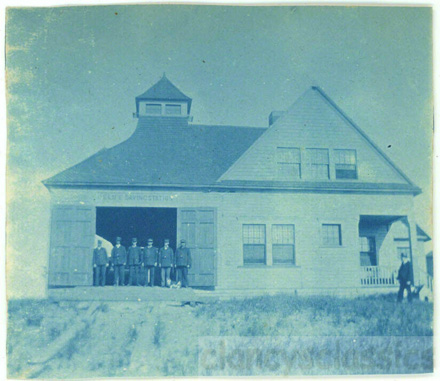
3115.
(photo) U.S. Life-Saving Station c.1900.
Rare early cyanotype photo measures 3” x 3 ½” shows an early Bibb #2-Type
station as the crew poses in front of the boatroom. The image was said to be Rye
Beach, NH but I have doubts because of lack of dormers. Photo is clear and close
with great early details. (VG+). $32.
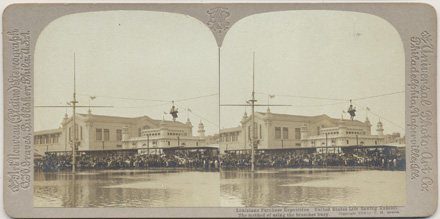
4126b.
[stereoview] Drill of the U. S. Life-Saving
Service,
Louisiana Purchase
Exposition c. 1904. by Universal Photo Art Co., C. H. Graves,
Philadelphia
. Clear image shows life-saving crew at exhibit performing breeches buoy drill
for the watching crowd. Visible is a surfman riding the breeches buoy from the
large drill pole, with throngs of visitors watching from the grandstand. Clean,
clear, crisp, very nice view. (VG+). $44.
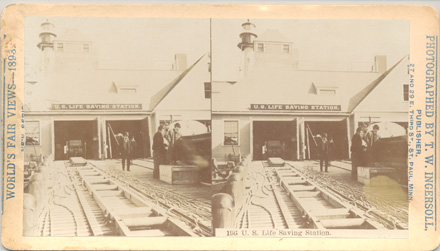
6283.
[stereoview] U. S. Life-Saving Service Station and
Lighthouse, World’s Columbian Exposition, Chicago 1893 by T.W.
Ingersoll. Quite clear image shows the modified Quonochontaug-Type life-saving
station built as a proud USLSS exhibit for the World’s Columbian Exposition in
1893. The station performed actual rescues during the fair and continued to
serve as an important life-saving station for many years after. Clearly visible
is the boat ramp with a lifeboat on display, as well as a beach apparatus cart
in the boat room. Behind the station in this view can be seen the tall 111-foot
iron lighthouse. The light, to be known as the Chicago Harbor Lighthouse, was
was constructed in 1893 for the Exposition and moved to its present site in 1919
at the south end of the northern breakwater protecting the Chicago Harbor to the
east of Navy Pier and the mouth of the Chicago River. Quite clear, crisp, some
soiling to edges of mount, nice view. (VG+). $68.
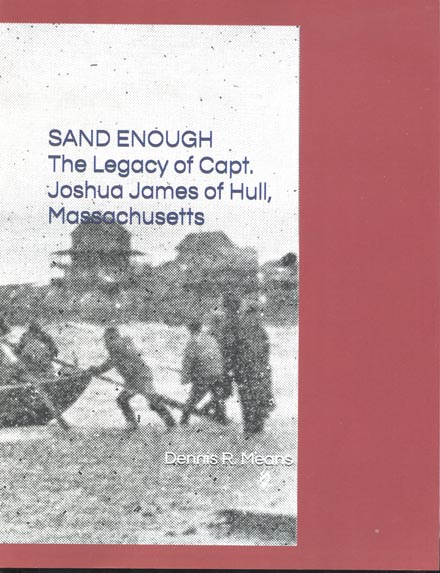 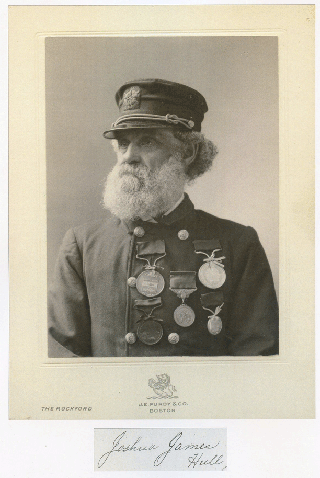
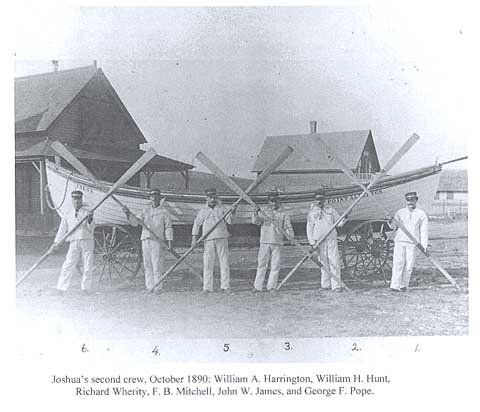
12448b. Means, Dennis R. SAND
ENOUGH – The Legacy of Captain Joshua James of Hull, Massachusetts.
2019. 3rd Enlarged Edition. 426p. Soft wraps. Map, filled with enhanced b/w
photos and illus., appendixes, select bibliography, index. Over 120 photos and
illustrations. The author, Great Grandson of Captain Joshua James, has after a
generation of research put together this comprehensive look at the life of this
famed life-saver. Thoroughly illustrated including several not seen outside the
family for a century, and many others forgotten or nearly lost in time.
Descriptions of virtually all, if not all, shipwrecks off Hull and Nantasket
Beach, 1836-1889, and including information regarding the rescue exploits of
local Massachusetts Humane Society Volunteers. Detailed accounts of all recorded
assistance rendered to persons and vessels by the Point Allerton L.S.S. Station
crews, 1889-1902, drawn primarily from Capt. James’s Wreck Reports and
Journal. Among numerous and authoritative contemporary sources, this book draws
upon newspaper interviews, some lengthy, with the Captain. Includes a great deal
on James’ early life including photos of he as a young man, and of his family,
his early efforts as a lighterman, his life-saving efforts with the
Massachusetts Humane Society, Life-Saving Service years, Keeper at Point
Allerton, and more. Also includes information on daily life at the station,
drills, station crews with photos, and more. Well researched, dispels a few
myths and answers scores of questions. Well worth it, interesting reading and a
great reference. (M). $74.
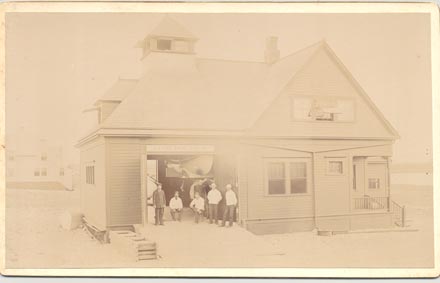

21498.
(lot 2 cabinet photos) North Scituate Life Saving
Station by C.H. Kelly c.1894. Wonderful set of two rare early images
of the early 1887 Bibb #2 Type life saving station on the beach at North
Scituate, Massachusetts. Original albumen photos measure 5” x 8” each.
Images include: Entire station with boatroom doors open as the keeper and crew
stand on the boatramp. Inside can be seen boats suspended from the rafters and
the early beach apparatus cart on the floor. Second view includes area residents
as they pose on the porch of nearby home with life-saving station behind. Images
are clear and close, with only light soiling and edge wear. (VG+). $158.
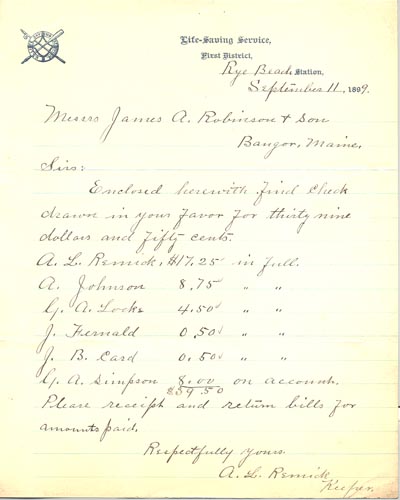 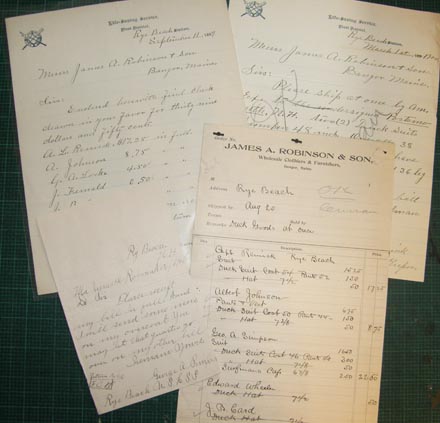
1234-5. (lot 4 documents) U.S.
Life-Saving Service, First District, Rye Beach Life-Saving Station c.1899-1900.
A.L. Remick, Keeper. Lot consists of four documents relating to clothing orders
for the crew at the station. The first is an original hand-written letter on
official Life-Saving Service stationery to James A. Robinson & Son
(clothiers), of Bangor, Maine, regarding payment for uniforms for Keeper Remick
and five named surfmen. One sheet 8” x 10” original stationery dated
September 11, 1899. Quite clean and crisp. The second is an original
hand-written letter on official Life-Saving Service stationery to James A.
Robinson & Son (clothiers), of Bangor, Maine, requesting white Duck Suits
jumpers with overalls. One sheet 8” x 10” original stationery dated March 1,
1900. Quite clean and crisp. Remaining sheets 7” x 11” (2) and 4 ½” x
7” (1) contain hand written notes on uniforms (duck suits, overcoat,
Keeper’s cap, blue surfman’s cap, pants, etc.) with prices and some sizes,
specs., etc., on order for men at the station. Men listed include Surfmen:
Albert Johnson, George A Simpson. Elward Wheeler, J B Card, Joseph Fernald, G A
Locke, Fred H Crowley. Overall quite clean. Rare Rye Beach LSS lot. (VG+). $145.
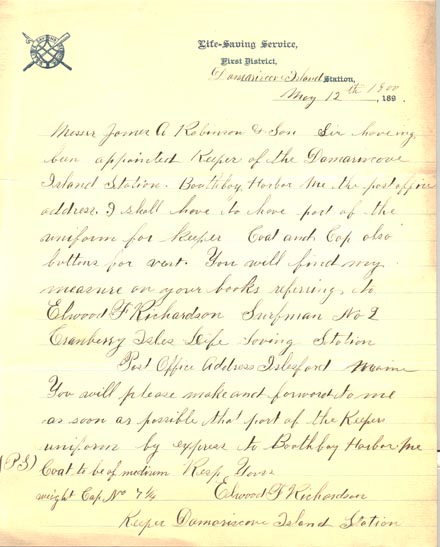 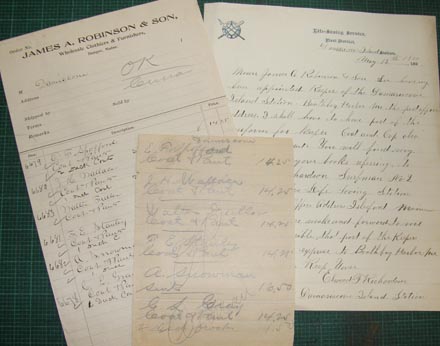
1234-35. (lot 3 documents) U.S.
Life-Saving Service, First District, Damiscove Life-Saving Station, near
Boothbay Harbor, Maine c.1900. Elwood F Richardson, Keeper. Lot
consists of three documents relating to clothing orders for the crew at the
station. The first is an original hand-written letter on official Life-Saving
Service stationery to James A. Robinson & Son (clothiers), of Bangor, Maine,
regarding an order for a new uniform due to his recent appointment as Keeper
(formerly #2 Surfman at Cranberry Island LSS). One sheet 8” x 10” original
stationery dated September 11, 1899. Quite clean and crisp. The second is
Remaining sheets 7” x 11” (1) and 4 ½” x 7” (1) contain hand written
notes on uniforms (duck suits, overcoat, Keeper’s cap, blue surfman’s cap,
pants, etc.) with prices and some sizes, specs., etc., on order for men at the
station. Men listed include Surfmen: EF Spofford, J… Wallace, Walter Fuller,
FE Stanley, A. Snowman, CL Gray. Overall quite clean. Rare Damiscove LSS lot.
(VG+). $135.
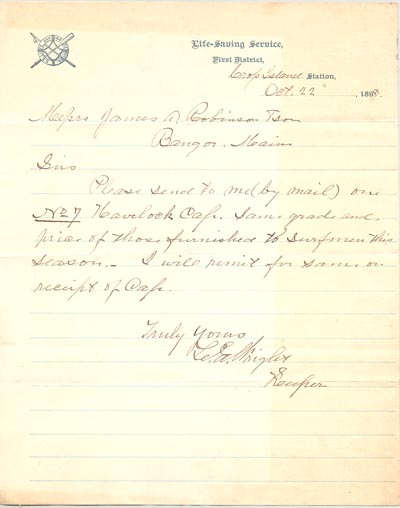 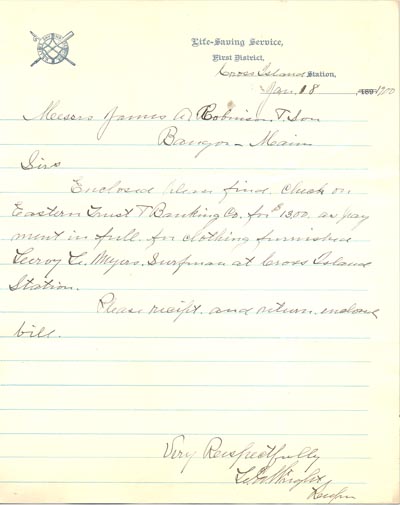
1234-8. (lot 2 documents) U.S.
Life-Saving Service, First District, Cross Island Life-Saving Station, Maine
c.1898-1900. Lyman E. Wright, Keeper. Lot consists of two
documents relating to clothing orders for the crew at the station. The first is
an original hand-written letter on official Life-Saving Service stationery to
James A. Robinson & Son (clothiers), of Bangor, Maine, regarding an order
for one No. 7 cap for himself. One sheet 8” x 10” original stationery dated
October 22, 1898. Quite clean and crisp. The second similar accompanied payment
for clothing order for Surfman Leroy L. Myers. Dated January 18, 1900. Quite
clean and crisp. Rare Cross Island LSS lot. (VG+). $125.
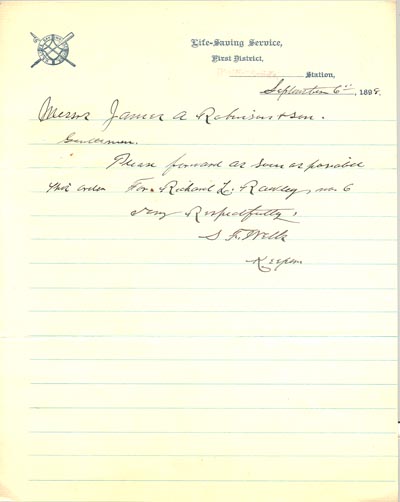 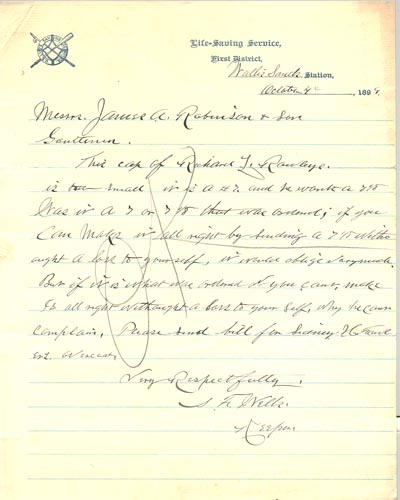
1234-1. (lot 2 documents) U.S.
Life-Saving Service, First District, Wallis Sands Life-Saving Station, New
Hampshire c.1899. S.F. Wells, Keeper. Lot consists of two documents
relating to clothing orders for the crew at the station. The first is an
original hand-written letter on official Life-Saving Service stationery to James
A. Robinson & Son (clothiers), of Bangor, Maine, regarding an order for one
cap for Surfman Richard L. Rawleye that was too small and requests a larger if
possible. One sheet 8” x 10” original stationery dated October 4, 1899.
Quite clean and crisp. The second similar is the original order requesting the
above cap. Dated September 6, 1899. Quite clean and crisp. Rare Cross Island LSS
lot. (VG+). $125.
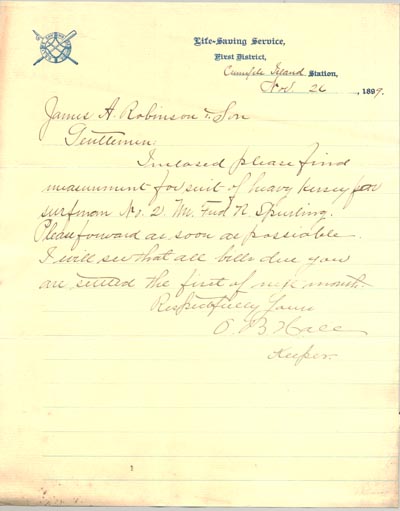 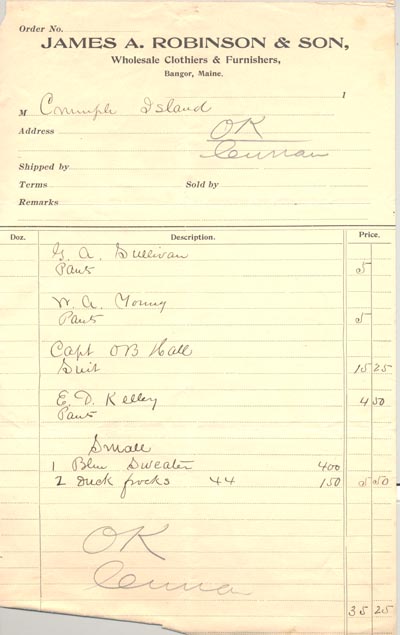
1234-9. (lot 2 documents) U.S.
Life-Saving Service, First District, Crumple Island Life-Saving Station, Maine
c.1899. O.B. Hall, Keeper. Lot consists of two documents relating to
clothing orders for the crew at the station. The first is an original
hand-written letter on official Life-Saving Service stationery to James A.
Robinson & Son (clothiers), of Bangor, Maine, regarding an order for a suit
of heavy Jersey for Surfman Fred R Spirling. One sheet 8” x 10” original
stationery dated November 26, 1899. Quite clean and crisp. The second is 7” x
11” containing hand written notes on uniforms (suits, pants, etc.) with prices
and some sizes, specs., etc., on order for men at the station. Men listed
include Surfmen: GA Sullivan, WA Young, ED Kelly, Capt OB Hall. Quite clean,
light wear. Rare Crumple Island LSS lot. (VG+). $85.
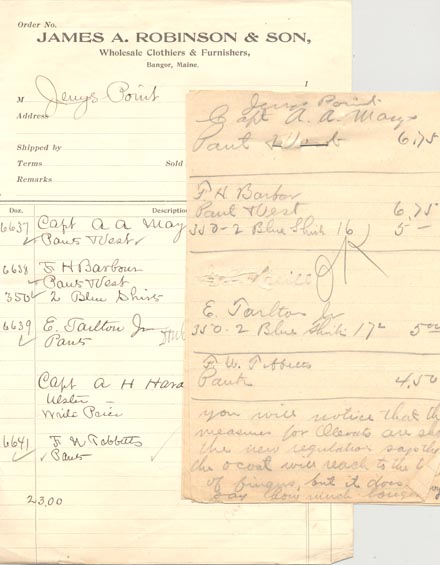
1234-39. (lot 2 documents) U.S.
Life-Saving Service, First District, Jerrys Point Life-Saving Station, NH c.1900.
A.H. Harding, Keeper. Lot consists of two documents relating to clothing orders
for the crew at the station. The first is an original hand-written notes by the
keeper, 5” x 8” 3 pages, with sizes and notes on uniform design including
comments on recent new uniform regulations. Members listed include Captain A A
Macy, Capt A.H. Harding, Surfman FH Barber, E Tarlton Jr., F.W. Tibbetts. The
second is 7” x 11” containing hand written notes on uniforms (suits, pants,
etc.) with prices and some sizes, specs., etc., on order for men at the station.
Men listed include Captain AA Mayo, Surfman JH Barbour, E Tarlton Jr, JW
Tibbetts, Capt AH Harding. Both quite clean, light wear. Rare Jerrys Point LSS
lot. (VG+). $45.
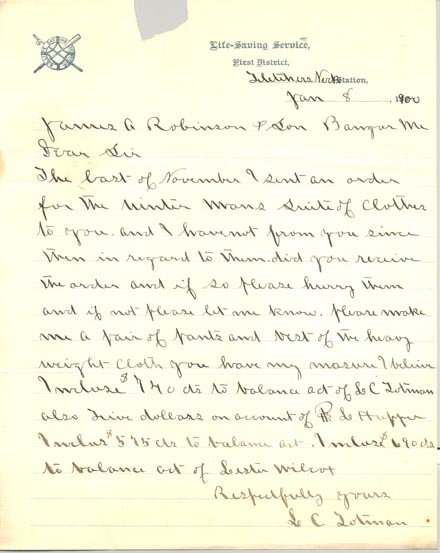
1234-52. (document) U.S.
Life-Saving Service, First District, Fletchers Neck Life-Saving Station, Maine
c.1900. L.C. Totman, Keeper. Document relating to clothing order for
the crew at the station. Consists of original hand-written letter on official
Life-Saving Service stationery to James A. Robinson & Son (clothiers), of
Bangor, Maine, regarding an order for the “Winter man’s” suit of clothes,
as well as a request for pants and a vest for himself. One sheet 8” x 10”
original stationery dated January 8, 1900. Quite clean and crisp, one chip at
top. Rare Fletchers Neck LSS lot. (VG+). $88.
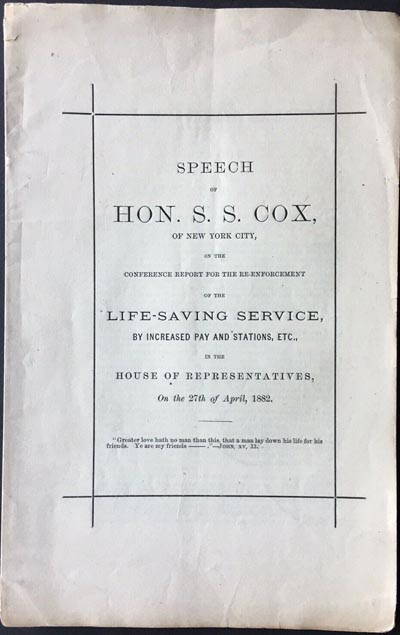
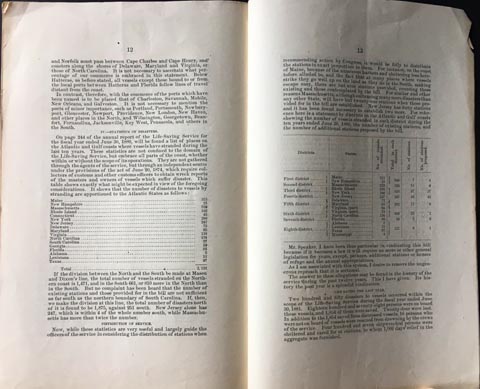
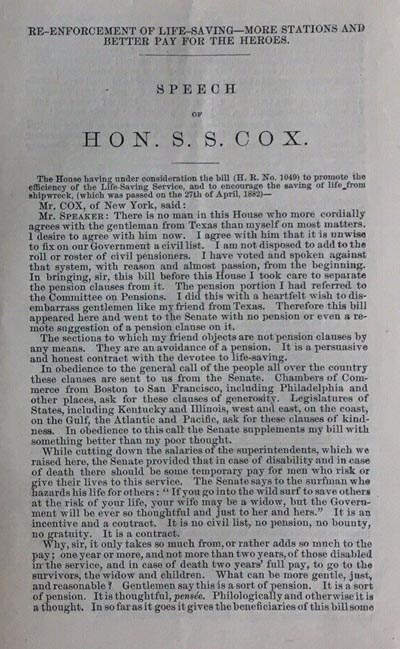
1974.
(pamphlet) Speech of Hon. S. S. Cox...on the CONFERENCE
REPORT FOR THE RE-ENFORCEMENT OF THE LIFE-SAVING SERVICE BY INCREASED PAY AND
STATIONS, ETC... April 27, 1882. 15pp. Given the title “Father of
the Life-Saving Service”, Mr. Cox spent his thirty year career in the United
States Congress attempting to upgrade the Life-Saving Service. Mr. Cox was most
proud of his work in creating the Federal statute that created the Life-Saving
Service and his untiring zeal in pressing for its eventual passage. This speech
prays for death and disability payments to the families of members of the
life-Saving Service who are lost or disabled. Includes chronicles of attempted
rescues including one involving the loss of 7 life-savers off
Carrituck Beach
,
N.C.
, and the loss of 3 off Peaked Hill Bar,
Cape Cod
. As issued without wraps. Clean, tight, light wear to edges. (VG). $74.
 
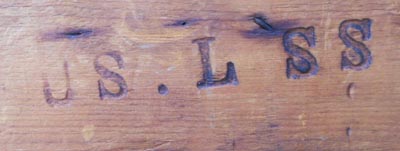
14251. ("tramp
art") Life-Saving Service Surfman’s Hanging Necessities Holder Branded "U.S.L.S.S."
c.1900. Rare hand carved holder was probably for a surfman’s razor
and other hygiene necessities. This type of art is referred to as Tramp art, a
true American folk art. Whittling was for men what quilting was for women during
long winter evenings in the country back at the turn of the century. While the
women painstakingly pieced together little fabric remnants to make comfy quilts,
men might take apart and carve cigar boxes and fruit crates with penknives,
creating one-of-a-kind, chipped or carved wood novelties. You name it, the men
created it--picture frames, clock cases, birdhouses, furniture, etc. This craft
became known as "tramp art" because early collectors mistakenly
thought vagabonds or tramps had made the quirky wood objects during their
travels. But nothing could be further from the truth, according to author
Clifford Wallach, co-author of "Tramp Art: One Notch at a Time," which
profiles individual whittlers. Tramp or hobo culture evolved over the decades
between the Civil War and the Second World War. These men traveled across the
country, usually by rail, looking for work, but they were not without skills,
and they were not bums. Wallach noted that “Tramp art became an important art
movement in regard to the artistic legacy of the common man who produced art not
in the schools or workshops that taught or produced art, but in their homes.
Tramp art defines folk art in its purest sense. It was a way for individuals
without any formal art training to express themselves in the simplest way, by
chip carving a piece of wood. Tramp art is the art of textured simplicity as
men, women and children took their pocketknives to wood and carved a legacy from
the heart for all of us to enjoy and celebrate.” Surfmen too had much free
time and such endeavors likely flourished in many stations, although few remain
and fewer still were marked as this piece is. Piece measures 15” high by 9”
wide and includes a box to hold the owners supplies and a small mirror in which
to see while shaving, etc. The back is branded “US. L SS” in 5/8” letters.
The side molding is grooved and likely the surfman’s favorite family photo was
mounted below the mirror. This is a rare piece and valuable both to collectors
of Life-Saving Service artifacts as well as collectors of American folk art.
Well done, rare item. (VG). $425. Reduced $325.
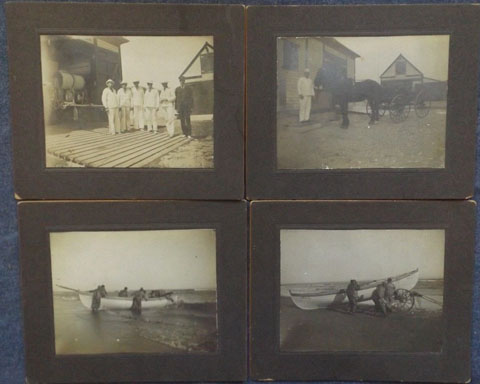 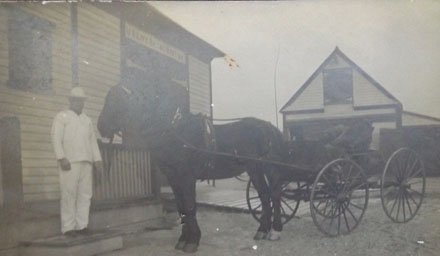
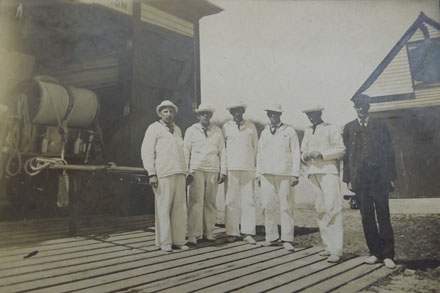 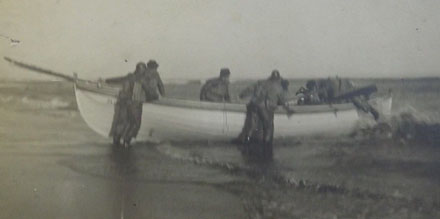
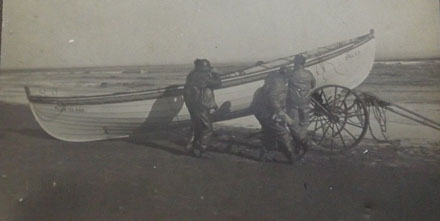
17167. (lot 4 mounted photos) U.S.
Life Saving Station, Newburyport / Merrimack River Station on Plum Island c.1905.
Rare set of 4 mounted photos provides a good view of station life and work at
the Merrimack River Life-Saving Station on Plum Island. There were two
life-saving stations on Plum Island, Newburyport (Merrimack River) on the north
end and Knobbs Beach (Plum Island) on the Ipswich end. Photos are clear and
close with great early details. Images measure 3 ¼” x 4 ¼” on 5” x 6”
mounts. Lot 4 mounted photos. (VG+). $295.
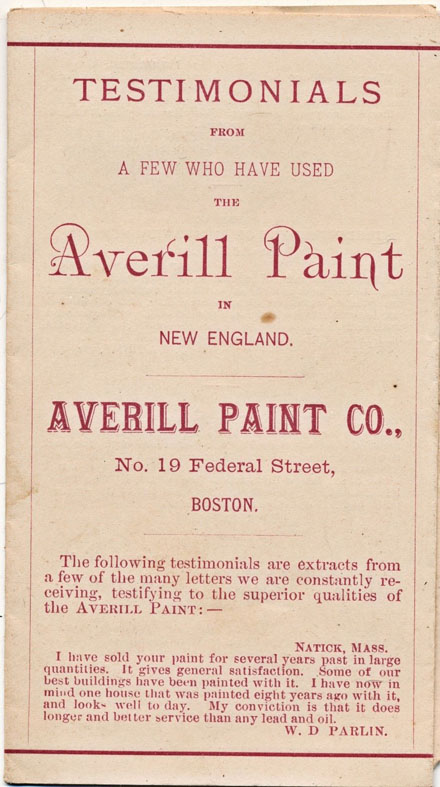
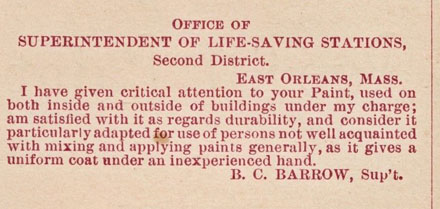
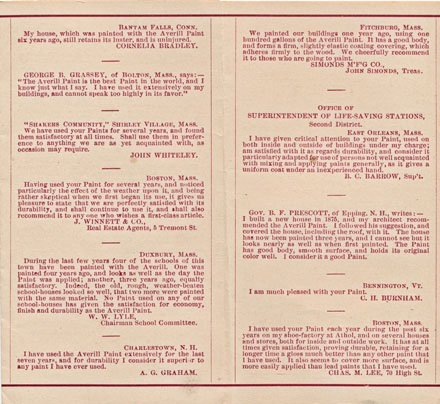
1839.
(brochure) Averill Paint Co., Boston, Mass. / U.S. Life
Saving Service c.1900. This is an 8 panel folder advertising Averill
Paint. It consists of 6 panels of testimonials, primarily from Massachusetts, as
to the suitability and reliability of Averill paint. Included is a testimonial
by Superintendent Benjamin C. Sparrow [listed here as B.C. Barrow], of the
Second Life-Saving District, East Orleans, Massachusetts. Supt. Sparrow states
that they have used Averill paint on the inside and outside of buildings in the
District and he is satisfied with the durability and ease of use. Folded
pamphlet measures 5 ½” by 3" and is in nice clean conditoin. I was
surprised to see such a testimonial by a supervisor in the Life-Saving Service.
(VG+). $36.
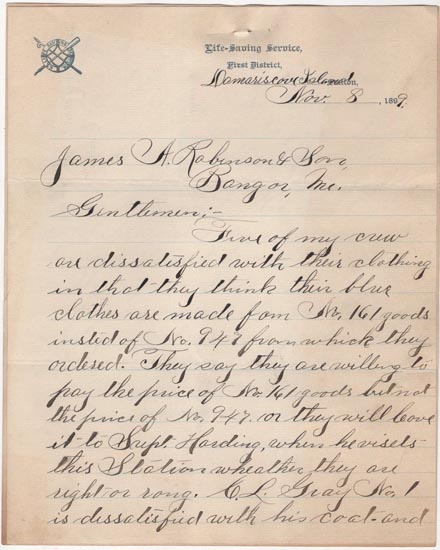
1234-49.
U.S. Life-Saving Service, First District, Damariscove
Life-Saving Station. November 1899. E. H. Spinney, Keeper. Original
2-page hand-written letter from Keeper Spinney to James A. Robinson & Son
(clothiers), of Bangor, Maine, regarding orders for uniform items for surfman
Staples. 8” x 10” on official Life-Saving Service stationery. Two
sheets. In the short, terse text, Keeper Spinney advises that blue uniform items
that five of his men received are believed to be made from the wrong (No. 161
goods) material rather than the correct No. 949 goods. Also, the Keeper
indicates that his No. 1 Surfman C.L. Gray was dissatisfied with his coat as it
was returned for being too small and after being returned to be enlarged, came
back and to all appearances was un-touched. Rare First District documents in
overall clean, crisp condition. Most interesting reading. (VG+). $124.
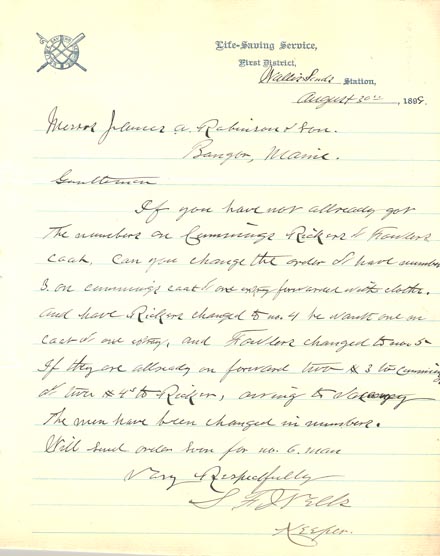
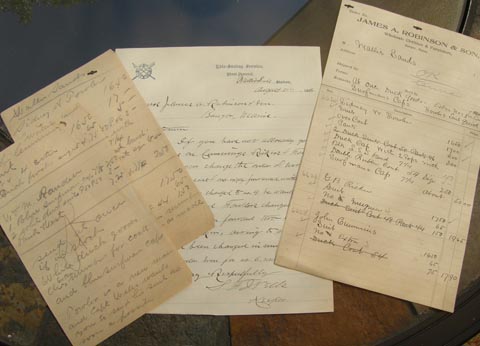
1234y.
(lot 4 documents) U.S. Life-Saving Service, First
District, Wallis Sands Life-Saving Station c.1899. S.F. Wells,
Keeper. Lot consists of four documents relating to clothing orders for the crew
at the station. The first is an original hand-written letter on official
Life-Saving Service stationery to James A. Robinson & Son (clothiers), of
Bangor, Maine, regarding a change to the seniority numbers for surfman coats on
order. One sheet 8” x 10” original stationery dated August 30, 1899. Quite
clean and crisp. Remaining sheets 7” x 11” (2) and 5” x 8” (2) contain
hand written notes on uniforms (duck suits, overcoat, Keeper’s cap, blue
surfman’s cap, pants, etc.) with prices and some sizes, specs., etc., on order
for men at the station. Men listed include Surfmen: Sidney W. Fowler, G.B.
Ricker, John Cumming, Wm. M Randell, G.B. Ricker, etc. Overall quite clean. Rare
Wallis Sands LSS lot. (VG+). $88.
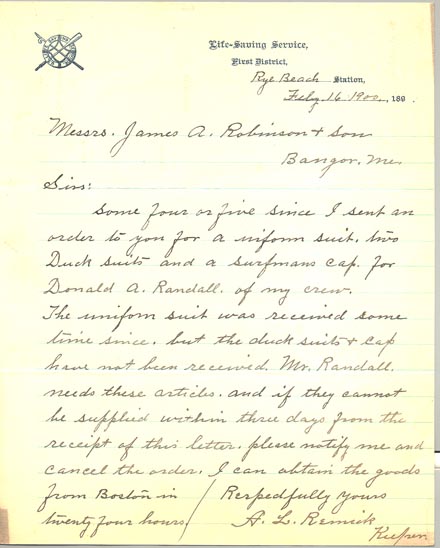
1234-48.
U.S. Life-Saving Service, First District, Rye Beach
Life-Saving Station. February 1900. A. L. Remick, Keeper. Original
1-page hand-written letter from Keeper Remick to James A. Robinson & Son
(clothiers), of Bangor, Maine, regarding orders for uniform items for Surfman
Donald A. Randall. Keeper Remick indicates that the uniform suit has been
received, but the two (white) duck suits and surfman cap have not been received,
and if they cannot be sent within three days then cancel the order and the
Keeper will obtain them from Boston. Rare First District document in overall
clean, crisp condition. Most interesting reading. (VG+). $124.
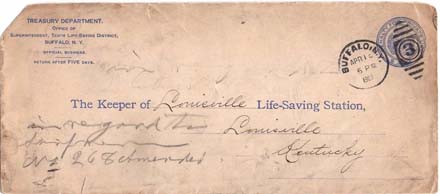 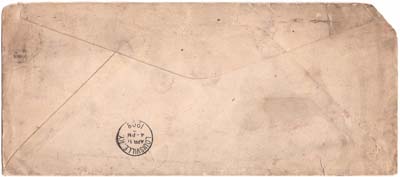
17154. (cover / envelope) Superintendent
Tenth Life-Saving District to Keeper, U.S. Life-Saving Station, Louisville, KY
c. 1908. Large original official envelope from the Superintendent
Tenth Life-Saving District, Buffalo, NY., with address filled in to Keeper of
Louisville Life-Saving Station, Kentucky. Envelope has light age toning and
normal postmarks, and some wear, chipped corner, moderately soiling, etc. A
great memento and a rare Life-Saving Service cover. 4” x 9”. (VG-). $54.
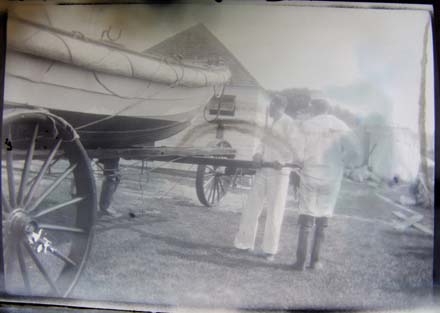 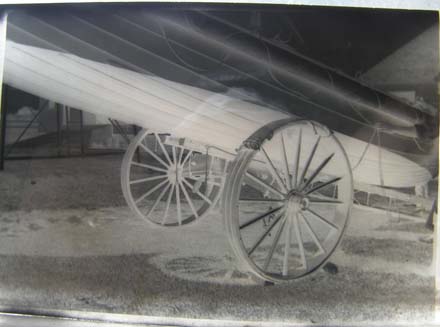
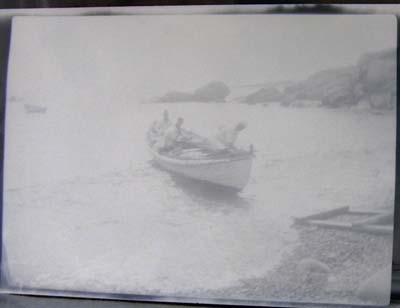
1768.
(3 negatives) U.S. Life-Saving Service, Straitsmouth,
(Rockport) Mass. c.1900. Extremely rare negatives show the
Straitsmouth life-saving crew with the station surfboat including two close
views detailing the boat and carriage nicely. Negatives measure about 2 ½” x
3 ½” and should produce good prints. Some clarity issues. (VG). $32.
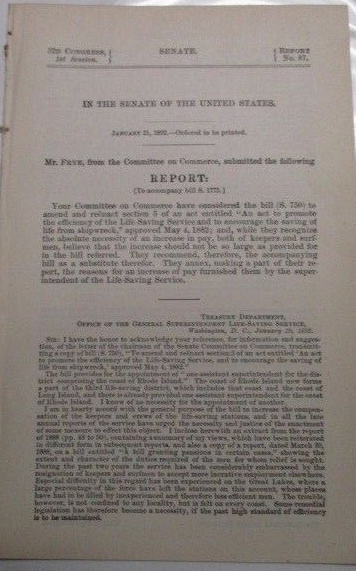
17140. Senate No. 87. Re.
An Act to Promote the Efficiency of the Life-Saving Service.... January 21, 1892.
10p. Disbound. Report accompanies Senate Bill S.750 regarding increases in pay
to surfmen and Keepers in the Life-Saving Service. In this rare report, General
Superintendent Kimball discussed the pay situation as well as the need for
pensions for surfmen disabled in the line of duty, etc. Quite interesting,
excellent information. (VG+). $45.
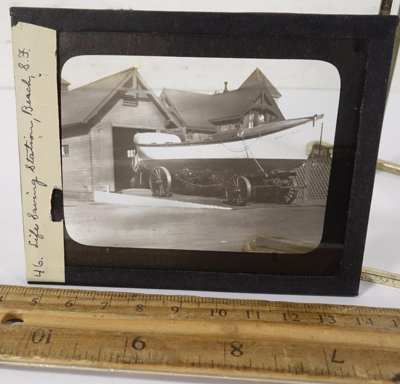
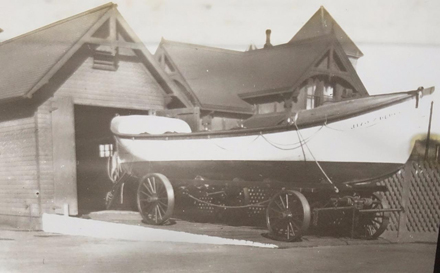
15255b.
(glass projection slide) U.S. Life-Saving Station with
Dobbins Lifeboat, San Francisco c.1911. Original 3 ¼” x 4”
antique glass plate projection slide shows marvelous detail of the U.S. Life
Saving Service lifeboat on the ramp outside the U.S. Life Saving Station located
at the western end of San Francisco's Golden Gate Park. The Golden Gate Park
Life-Saving Station in this image was a one-of-a-kind station with buildings
designed by architects J. Lake Parkinson and John G. Pelton. This slide may
derive from the Wyland Stanley Collection of San Francisco historical
memorabilia which included thousands of original photographs and antique
negatives. The entire collection was purchased by Marilyn Blaisdell in the late
1970s. Image is clear and close and will make wonderful prints. (VG+).
$64.
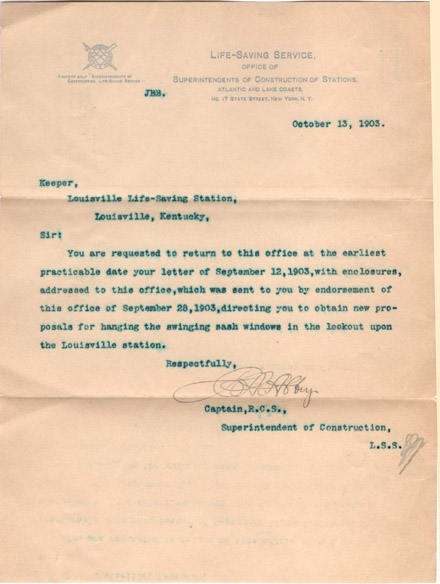
1799.
(document) U.S. Life Saving Service Superintendent of
Construction of Stations to Keeper, Louisville Life-Saving Station c.1903.
8” x 10 ½”. Original document to the Keeper of the Louisville Life-Saving
Station from Superintendent of Construction of Stations, Atlantic and Lake
Coasts, USLSS, requests the Keeper return various documents relating to the
hanging of new sash windows in the lookout tower upon the Louisville station.
Signed in hand by Captain …Abbuy, R.C.S. Clean, crisp, two original folds.
(VG+). $68.
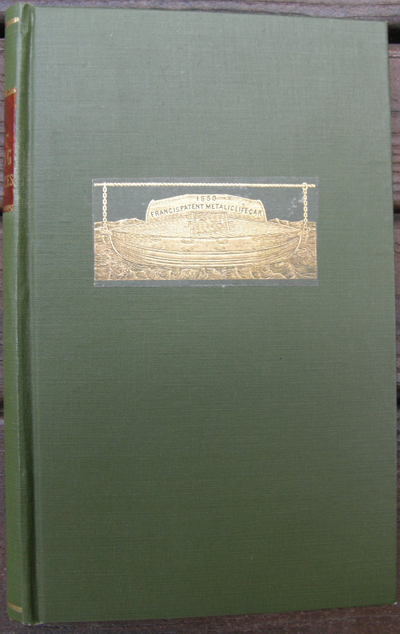
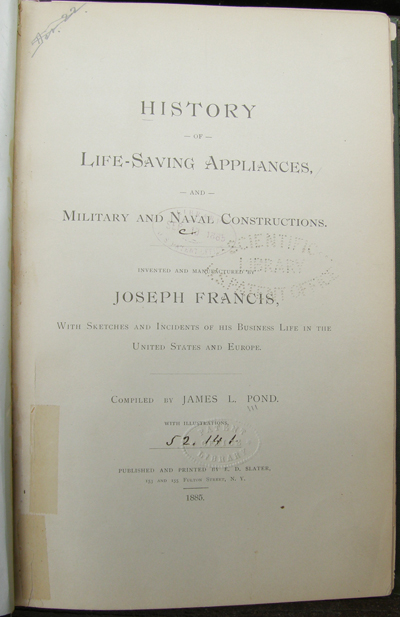
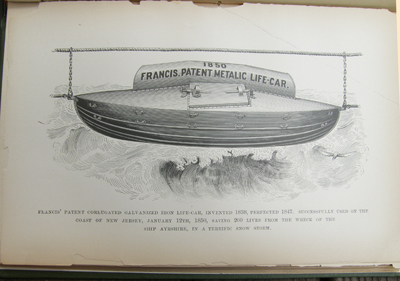
6376L.
Pond, James L., HISTORY OF LIFE-SAVING APPLIANCES, AND
MILITARY AND NAVAL CONSTRUCTIONS. INVENTED AND MANUFACTURED BY JOSEPH FRANCIS
WITH SKETCHES AND INCIDENTS OF HIS BUSINESS LIFE IN THE UNITED STATES AND
EUROPE
....
New York
. Published and Printed by E. D. Slater 1885. 127p. Tall octavo, rebound in
olive green cloth titled in gilt on spine with gilt embossed vignette of the
"1850 Francis Patent Metallic Life-Car". on front cover. Indexed;
illustrated in black and white throughout with 17 wonderful engraved
illustrations, with several full-page drawings and a folding plate of equipment
related to life-saving and life boat construction. First edition withdrawn from
Smithsonian Library. The book is wonderfully illustrated with plates depicting
shipwrecks and other maritime accidents, and boats and equipment built by
Francis. Chronicles the design and use of Francis’ life-saving appliances
including his Patent Metal Life-Car, which saw use on the coast of
New Jersey
in January, 1850 and was credited with saving 200 lives from the wreck of the
Ayrshire. Later the metallic life-car was adopted for use by the United States
Life-Saving Service. Excellent descriptions of many terrible wrecks and rescues,
with many fine engravings. Also includes a great deal of information regarding
many other designs of life-saving appliances, some of which were adopted for use
by the Life-Saving services throughout the world. The original binding was
removed and has been professionally rebound in similar with original vignette on
front wrap. Pages are a bit brittle with some archivelly repaired. A few are
loose from the binding, some edges worn. Still a most important work by this
early life-saving inventor, a sought after collector’s piece. (G). $124.
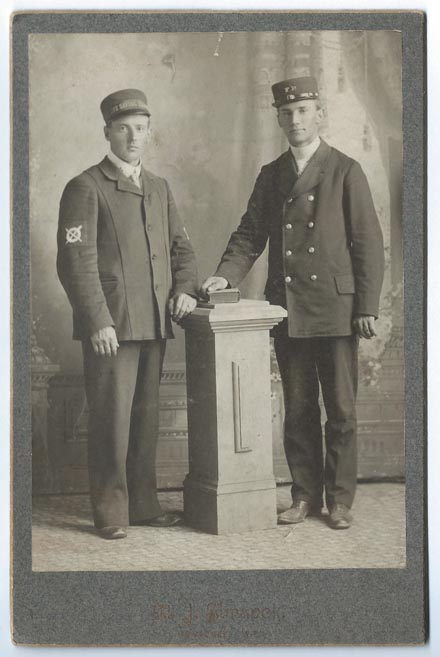 
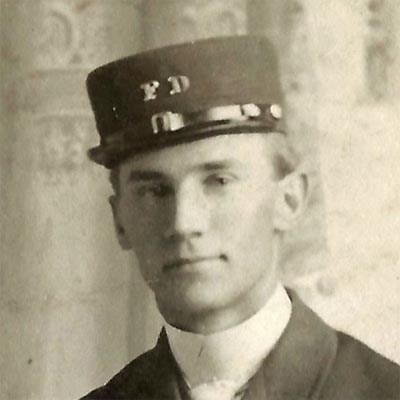
15188b. (cabinet photo) Surfman,
U.S. Life-Saving Service with Firefighter (brother ?) c.1890.
Photographer M.J. Simanek, Kewaunee, Wisconsin. Rare original portrait
photograph includes a Life-Saving Service Surfman posing with a firefighter,
possibly his brother (?). This rare posed portrait photograph shows the handsom
men proudly posing in their uniform coats. Clearly visible is the insignia of
the Life-Saving Service on the surfman’s right arm, and his uniform cap with
“U. S. Life Saving Service” visible on the band. The firefighter’s hat
with “FD” on the front. The cabinet card measures 4 ¼” x 6 ½” on
original mat. Photo is clear, and crisp, near fine. It is exceptionally rare to
see such photos of surfmen in any format. (F-). $265.
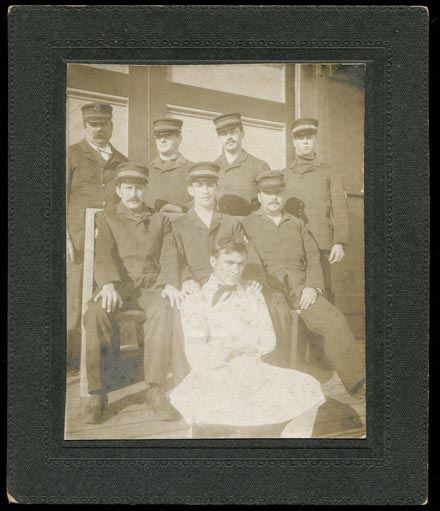 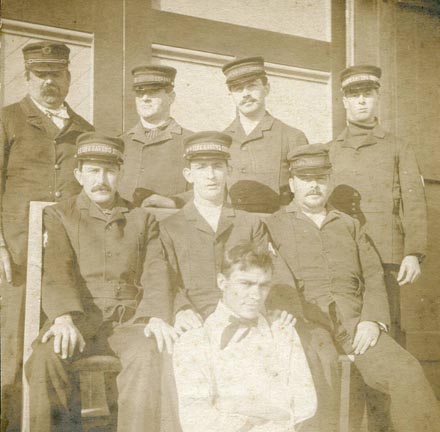
1706. (mounted photo) Life-Saving
Service Keeper and Crew c.1900. Superb clear, close image includes
the station Keeper with his 7-man crew. Note that the man in front has a white
apron indicating that he had the cooking duty that day. Nice view, unknown
location. Image measures 3 ¾” x 4 ¾” on 5 ¼” x 6 ¼” mount. Clean,
crisp, very good condition. (VG+). $165.
 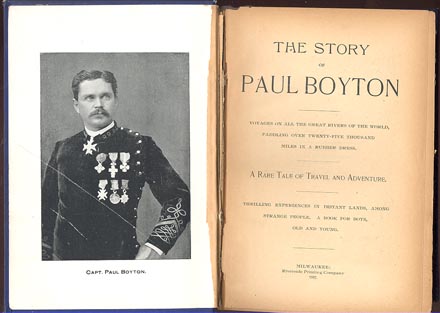
1787. Boyton, Paul. The
Story of Paul Boyton. 1892. Riverside Printing. 359p. Gilt embossed
wraps. “A rare tale of travel and adventure, voyages on all of the great
rivers of the world, paddling over twenty-thousand miles in a rubber dress.”
Boyton, eager for adventure at a young age, began toying with the rubber suit
invented by C.S. Merriman as a life-saving device for steamship passengers. The
suit, which would become Boyton's trademark, was essentially a pair of rubber
pants and shirt cinched tight at the waist. Within the suit were air pockets the
wearer could inflate at will using tubes. Similar to modern-day wetsuits, the
suit also kept its wearer dry. This essentially allowed the wearer to float on
his back, using a double-sided paddle to propel himself, feet-forward. Boyton
made numerous expeditions in this suit, swimming up and down rivers across
America
and Europe to publicize its uses. Boyton would tow a small boat behind him in
which he carried his supplies and personal possessions, and sometimes invited
newspaper reporters to accompany him. Although the US Life-Saving Service would
consider and test the Merriman suit, Superintendent Sumner I Kimball questioned
the general application of the expensive Merriman life-saving dress, which
nonetheless performed commendable service on occasion. A few such suits were
tested including at the Surfside Life-Saving Station on Nantucket, but they were
not put into general use as Kimball anticipated that the cork life-belt then in
use in
Europe
would provide adequate buoyancy for the crew while proving less cumbersome than
the rubber suit. Contents darkened from age, somewhat brittle, a few chips,
hinges becoming loose. Wraps bright, edges and corners worn. Rare title. (G+).
$74.
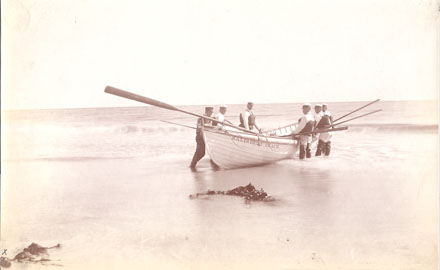 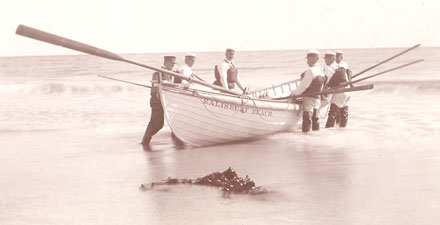
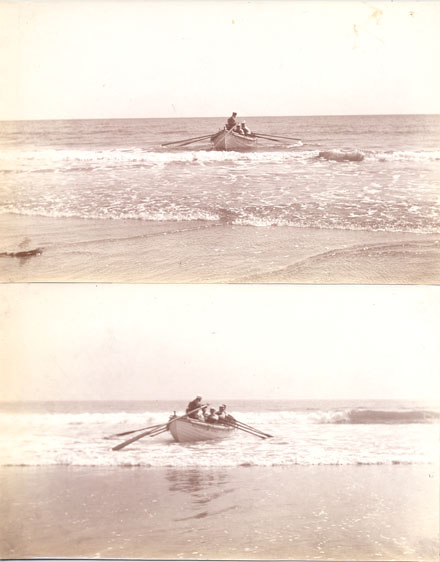 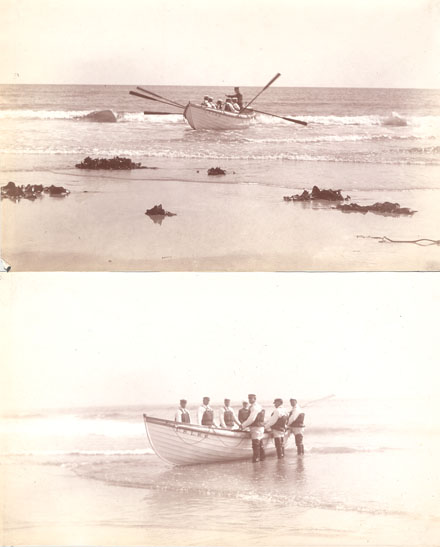
1718b. (lot 5 photos) U.S.
Life-Saving Service, Salisbury Beach, Mass. Surfboat Drill c.1890.
Lot consists of 5 original silver gelatin prints measuring 4 ¾” x 7 ¾”,
possibly by S.C. Reed, Newburyport, Mass. Rare lot of five crystal clear silver
gelatin prints captures beautifully the Salisbury Beach Life Saving crew
launching and landing on the beach as they drill in the station surfboat. The
Salisbury station was built in 1897 on the Massachusetts North Shore just south
of the New Hampshire state line. Excellent early Life-Saving Service images,
clear, crisp, unusually bright. A rare lot. (VG+). $495.
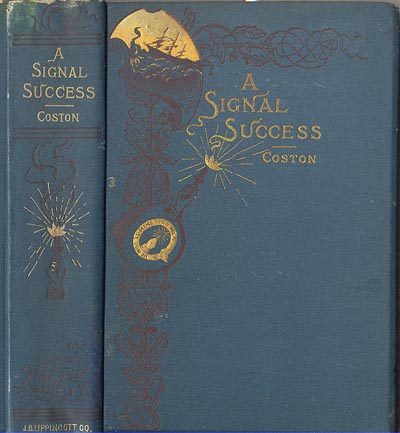
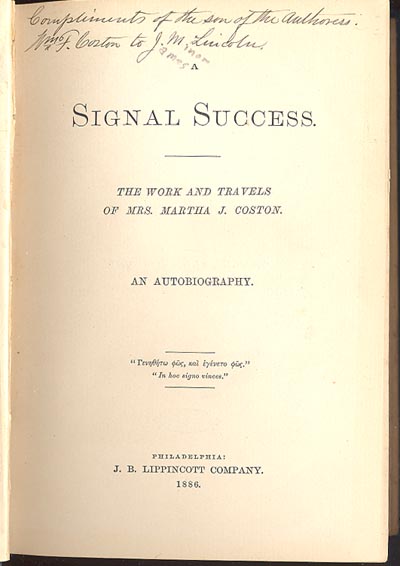
574f.
Coston, Martha J., SIGNAL SUCCESS. The Work and Travels
of Mrs. Martha J. Coston. An Autobiography.
Philadelphia
. 1886. 333p. First edition. Signed presentation copy
by the son, William F. Coston to James Minor Lincoln. Frontispiece
portrait, color plate of ship signals, plate of ship signaling, a few vignettes.
12MO. Beveled pictorial cloth covers, gilt embossed, clean and bright, light
edge wear. Top page edges gilded. Widow of the inventor of the Coston flares
used extensively by the Life-Saving Service, tells of her efforts to perfect and
sell his night signals. Quite clean, tight, front hinge just beginning to
loosen. (VG+). $138.
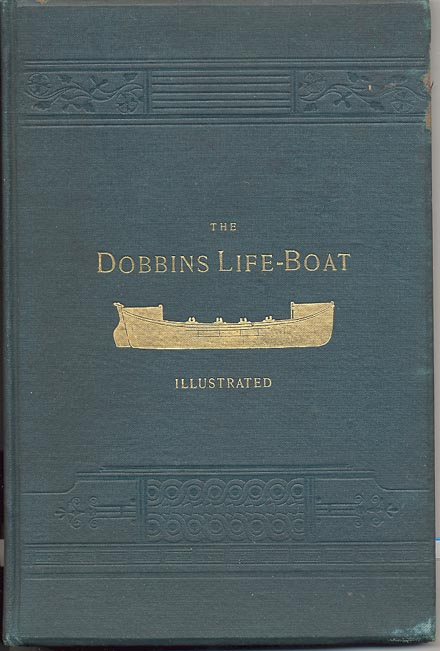
7238j.
Dobbins, David Porter. THE DOBBINS LIFE-BOAT
ILLUSTRATED.
Buffalo
,
NY
. 1886. 48p. b/w engravings. Exceptionally scarce publication by the inventor of
the self-righting life-boat that was adopted for use by the United States
Life-Saving Service. Finding the American surf-boat, the common lifeboat and the
English life-boat all inadequate, Dobbins invented his life-boat. His boat “is
strong, portable, self-righting and self-bailing, and literally unsinkable.”
Mr. Dobbin’s experience included over twenty five years on sail and steam
vessels and ten years experience as Superintendent of the Ninth District of the
United States Life-Saving Service. Here Mr. Dobbins presents a brief overview of
advantages and disadvantages of various life-boat designs and the design
features of his self-righting boat. With engraved illustrations and beautiful
frontis portrait photographically reproduced. Bright gilt cover illustration.
Overall clean and tight. Moderate foxing to frontis illustration page margins.
Wraps clean, some bumping, wear to one edge. $138.
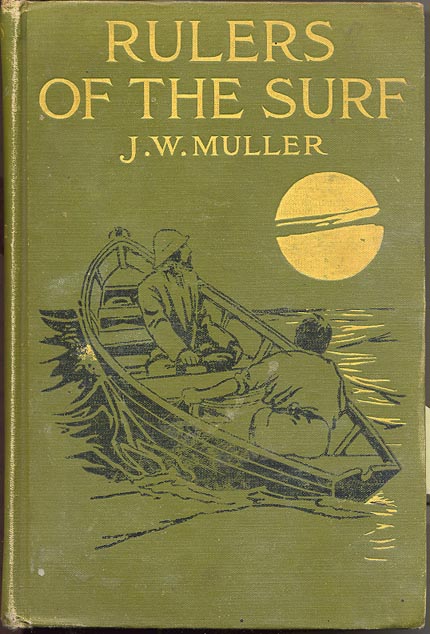
6632c. Muller, J. W., RULERS
OF THE SURF - A Story of the Mysteries and Perils of the Sea. D.
Appleton
.
New York
. 1910. 324p. Though the names and places are fictitious, the events narrated as
part of the life of bay and surf are true. The work of the life-savers in a
winter gale has not been exaggerated and is based on the wreck of the schooners
Augustus Hunt and
Louis V. Place
off the Lone Hill Life-Saving Station on Long Island. While returning from a
desperate rescue of nine men, and while badly frost-bitten, the life-savers
immediately embarked on a second rescue effort. With the crew of the Blue Point
L. S. Station, they fought for 36 more hours to get into the sea and at last
were able to rescue two more survivors. Clean, tight, with bright embossed
cover, light scuffing. (VG). $68.
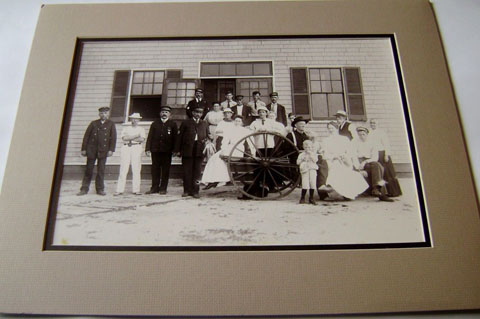
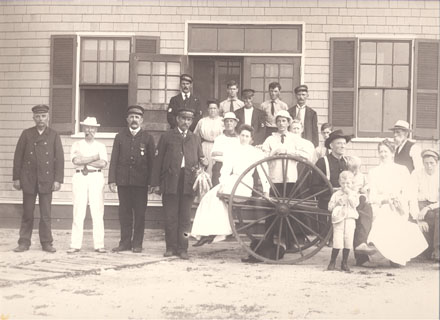
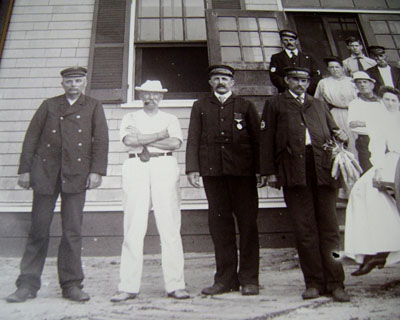 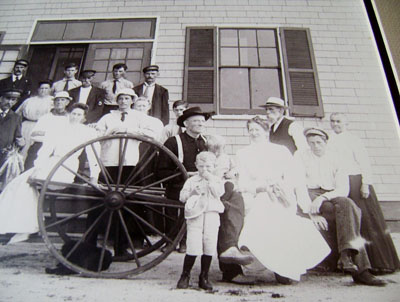
1703. (matted photo print) U.S.
Life-Saving Service Crew Posing. This is a large late 20th Century
photo print, probably from a glass negative, of an early view as the Keeper and
seven life-savers pose with others in front of a building, presumably a
life-saving station. The print is quite large 10” x 14” and dry mounted in
14” x 18” double mat. Crystal clear, would be great framed. (VG+). $84.
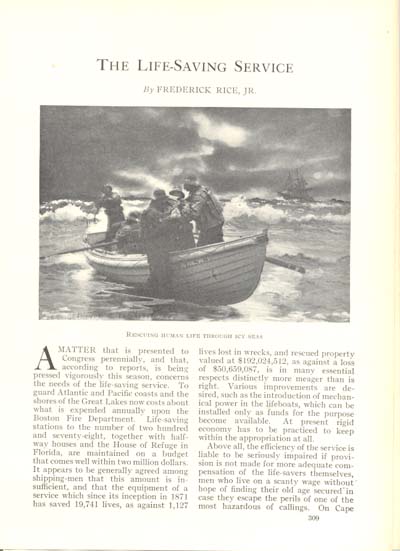
25351c.
Rice, Frederick Jr. THE
LIFE-SAVING SERVICE.
New England
Magazine. May 1908. 3 p. Disbound from early magazine of the day. Quite a nice
article detailing the present needs of the service, the inadequate pay rates and
especially the increasing difficulties in obtaining qualified men. With three
fine illustrations. Clean, crisp. (VG+). $26.
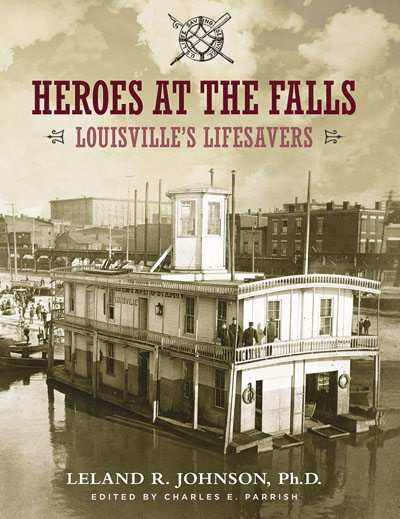
16202.
Johnson, Leland R. Ph.D. Heroes
at the Falls: Louisville's Lifesavers. Edited by Charles E. Parrish. Butler
Books. 2014. 128 pages. Large 8 ½” x 11”. Life-Saving Station #10, docked
at the wharf in Louisville, Kentucky, is a unique installation in American
history. As the only such federal installation on the inland waterways, this
rare floating life-saving station guarded against navigational disasters from
1882 until 1972. The only other similar life-saving station in the country was
the City Point Station in Boston Harbor. This station in Louisville was lobbied
for and manned by locally-grown heroes who maintained a constant vigil to
protect vessels and their passengers, cargoes and crews from destruction on the
jagged rocks of the Falls of the Ohio River in the days prior to modern lock and
dam systems. This Falls area was considered the most dangerous point along the
981 miles of the Ohio River. From the time it was authorized by Congress in 1881
until 1915, thousands of people were rescued from the treacherous falls area and
more than $5 million worth of boats, possessions and cargo were saved. The Coast
Guard would continue this fine record at the station until 1972, when the
completion of the newer McAlpine Locks and Dam submerged most of the Falls
and now required that all boat traffic pass through the canal and locks instead
of passing over the Falls. The third floating station remains today, with its
white double-decker building and watchtower aboard - the last of three river
rescue stations at the site. Dr. Johnson tells, for the first time, the
compelling story of the U.S. Life-Saving Service and Coast Guard stations at
this site, and the remarkable crews who saved thousands of lives, countless
numbers of boats, and millions of dollars of cargoes at the Falls of the Ohio.
(M). Published at $20. Our price $18.50. (x)

1269b. [cabinet photograph] Life-Saving
Service Surfman Frank Tuttle, Long Island, New York c.1890-1900. This
rare posed original portrait photograph shows the clean-cut surfman proudly
posing in his 4-button single-breasted uniform coat. Clearly visible on his
right sleeve is the life ring with crossed oar and pike and the letters “US”
“LSS”. On his cap is a tally lettered “U.S. Life-Saving Service”. The
image measures 4” x 5 ½” on a 6” x 8½” original mat. Mat stamped G.A.
Aneman, Riverhead, N.Y.” Photo is clear, and crisp, one of the better
images we have had in some time. On back is labeled in ink: My Great Uncle Frank
Tuttle, U.S. Life-Saving Service…. CWO4 Alvin E. Penny U.S.C.G.” It is
exceptionally rare to see such photos of surfmen in any format. (VG+). $225.
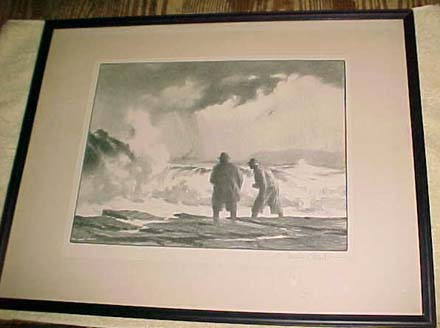
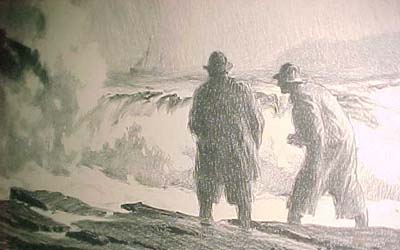
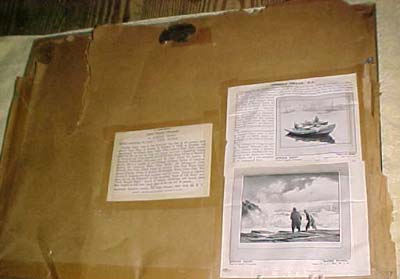
16102a.
(signed lithograph unframed) Shore
Patrol by Gordon Grant (1875-1962) c.1938. Limited Edition (likely
250). Size: 9” x 12” in 14” x 18” mat. Pencil signed by artist lower
right. Beautiful signed original lithograph shows Life-Saving Service (Coast
Guard) surfmen patrolling the beach in a storm as heavy seas roll ashore. A
vessel in distress can be seen in the background. Original lithograph has been
removed from its frame but included is the original mat, card and paper backing
complete with original description of the scene and biography of the artist.
This is from a limited edition, likely of 250 prints on wove paper with
watermark. Born in 1875 in San Francisco, Gordon Grant, traveled to Great
Britain for his formal education, and then studied art at Lambeth and Heatherley
in London. After his return to San Francisco, he worked as an illustrator and a
correspondent artist for various newspapers in the area. Covering the Boer War
and the Mexican Revolution, his images came East and appeared in Harper's Weekly
in New York. Eventually, Grant, established himself as an outstanding
illustrator of books. During the early 1900's he participated in a project to
restore and designate as a National monument, the historic vessel, the U.S.
Constitution. Publishing prints of his painting of this vessel, Grant, was
able to help raise money for its preservation. The original painting now hangs
in the White House. His lithographs, etchings, oils, water colors, and drawings
of life on the seven seas and the vessels that sailed them, prove Grant, to be
one of the foremost American marine artists. He was a member of the National
Academy of Design, American Watercolor Society, the Salmungudi Club, National
Arts Club, Allied Artists of America, New York Water Color Society, Chicago
Society of Etchers and the Philadelphia Water Color Club. Beautiful scene,
clean, only very light toning from age. When framed, will look fine on any wall.
(VG). $225.
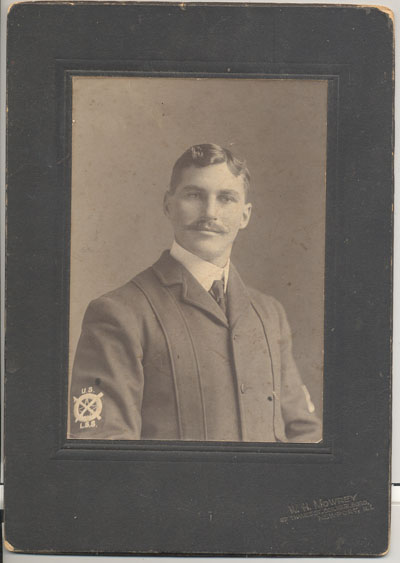 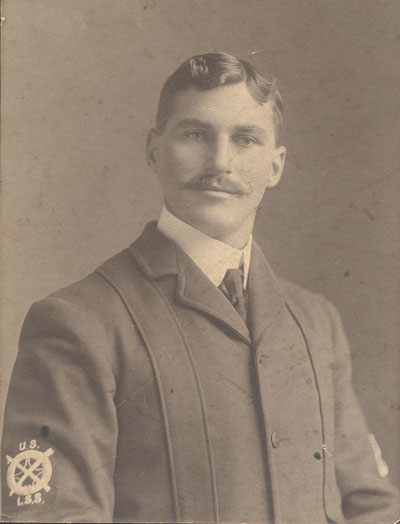
26107i. [cabinet photograph] Life-Saving
Service Surfman, Narragansett Pier Life Saving Station, Narragansett, Rhode
Island c.1906. This rare posed original portrait photograph shows the
clean-cut surfman proudly posing in his 4-button single-breasted uniform coat.
Clearly visible on his right sleeve is the life ring with crossed oar and pike
and the letters “US” “LSS”. The image measures 4” x 5 ½” on a 6”
x 8 ½” original mat. Mat stamped W, H, Mowrey (photographer), Newport, RI.
Photo is clear, and crisp, one of the better images we have had in some
time. On back is labeled in light pencil “From Mr. Charles L. Sa____s To Mr.
Wargesett Jackson [?] Feb 1906”. It is exceptionally rare to see
such photos of surfmen in any format. (VG+). $245.

1269b. [cabinet photograph] Life-Saving
Service Surfman Frank Tuttle, Long Island, New York c.1890-1900. This
rare posed original portrait photograph shows the clean-cut surfman proudly
posing in his 4-button single-breasted uniform coat. Clearly visible on his
right sleeve is the life ring with crossed oar and pike and the letters “US”
“LSS”. On his cap is a tally lettered “U.S. Life-Saving Service”. The
image measures 4” x 5 ½” on a 6” x 8½” original mat. Mat stamped G.A.
Aneman, Riverhead, N.Y.” Photo is clear, and crisp, one of the better
images we have had in some time. On back is labeled in ink: My Great Uncle Frank
Tuttle, U.S. Life-Saving Service…. CWO4 Alvin E. Penny U.S.C.G.” It is
exceptionally rare to see such photos of surfmen in any format. (VG+). $225.
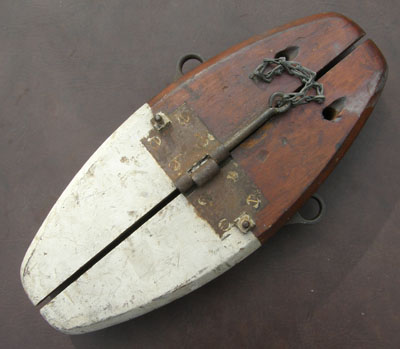 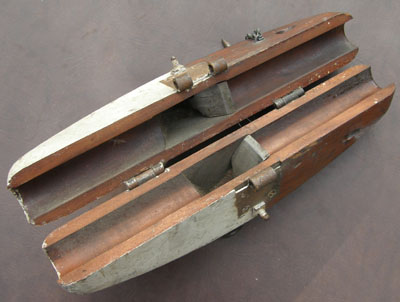
24102i. United
States Life Saving Service /
Coast
Guard
Beach
Apparatus Hawser Cutter. After a shipwrecked crew was landed from a
stranded vessel, it would be necessary to release the large hawser from the
vessel so that it could be used again. In this case, the hawser cutter would be
used. The cutter is hinged and would be closed around the hawser with the white
painted end on the inshore side. The whip was then tied to the cutter and with
it pulled back toward the wreck. Once as close to the wreck as possible, the
hauling in whip would be pulled, closing the knives in the cutter and severing
the hawser. The hawser, cutter and whips could then be pulled ashore. Cutter is
in wonderful condition, with original two-color finish still visible although
well worn, without original operating ropes. Knives intact, includes locking
pin. Unit is in good working order. Unit is not marked (many were not). This is
an extremely difficult to find piece from the beach apparatus cart. Condition is
very good and this will make an important addition to your collection.
Exceptionally scarce, and simply a must if you have a Lyle gun or beach
apparatus, or to complete your collection or exhibit. (VG+). $1695.

1592.
(photo) Life-Saving Crew Drilling with Beach Apparatus
c.1910. Clear close view shows good detail of the beach apparatus as
the crew drills. Location is unknown. Staining to upper margins, one corner
creased. (G+). $28.
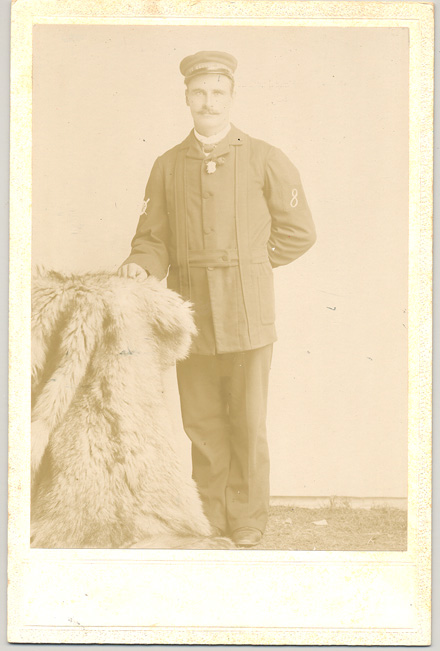 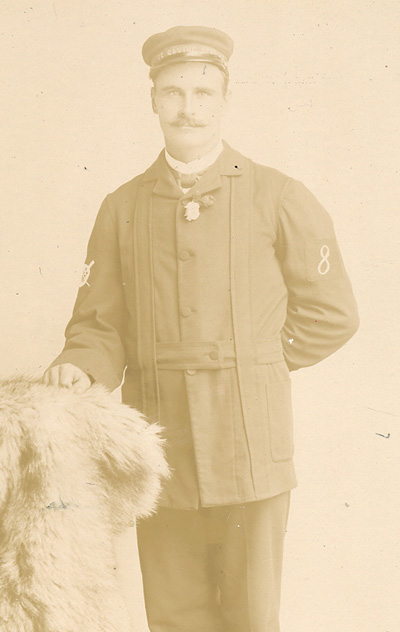
15188. [cabinet photograph]
c.1890-1900. Original portrait photograph, of a Life-Saving
Service Surfman. This rare posed portrait photograph shows the stout
surfman proudly posing in his 4-button single-breasted uniform coat. Clearly
visible on his left sleeve is his ranking number “8”, the insignia of the
Life-Saving Service on his right arm, and his uniform cap with “U. S. Life
Saving Service” visible on the band. The image measures 4” x 5 ½” on a 4
½” x 6 ½” original mat. Mat without photographer’s marking. Photo is
clear, and crisp, just a bit light. It is exceptionally rare to see such photos
of surfmen in any format. (VG+). $185.
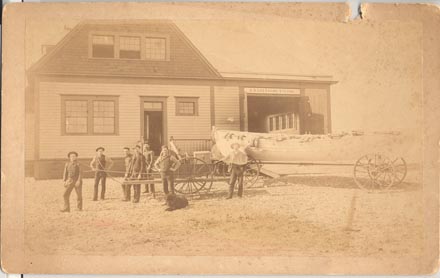 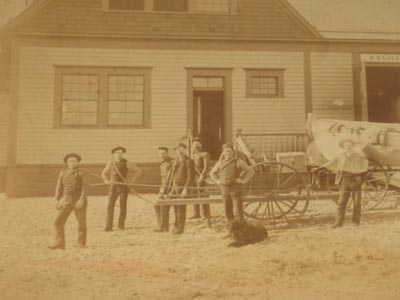
21498f. (cabinet photo) North
Scituate Life Saving Station and Crew by Otis Barker Photographer, Scituate
c.1887. Wonderful rare early image of the early 1887 Bibb #2 Type
life saving station on the beach at North Scituate, Massachusetts as the crew
poses with the surfboat in front. Original albumen photo measures 5 ¼” x 8 ½”.
This is an early view as the crew are without uniforms at this point in time.
Note the life preservers hanging on the surfboat to dry. Image is clear and
close, with some foxing to margins and one chip to mount above photo. Just a bit
light. (VG). $275.
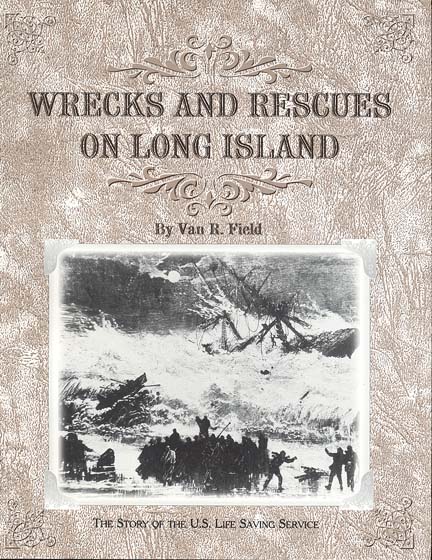 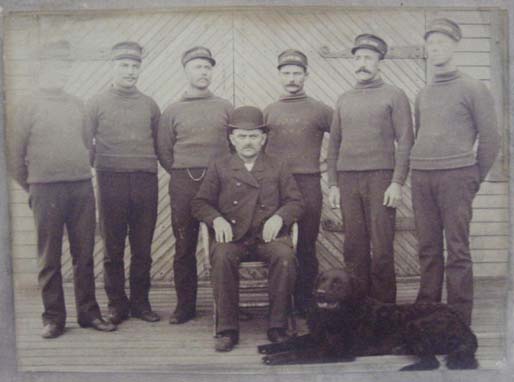
7340f. Field, Van. WRECKS
AND RESCUES ON LONG ISLAND - THE STORY OF THE U. S. LIFE SAVING SERVICE.
1997. 179p. Soft wraps. Over 188 vintage photographs. I have once again found a
copy of this long out of print work by Mr. Field. Filling a longtime void in the
chronicles of the Life-Saving Service on Long Island, this book is the result of
decades of research. In 179 large format pages, the author presents
unforgettable stories of the surfmen and their unsurpassed bravery. Unique to
this work are the 180 wonderful vintage photographs of the stations and the men
who served along this stormy coast. In this interesting chronicle, the author
provide a station by station look at the buildings, the crews and the rescues
they performed that make them such a unique and unforgettable piece of our
history. Filled with wonderful vintage photos. Clean, tight, only lightly used.
Extremely difficult to find. (M). $59.95.
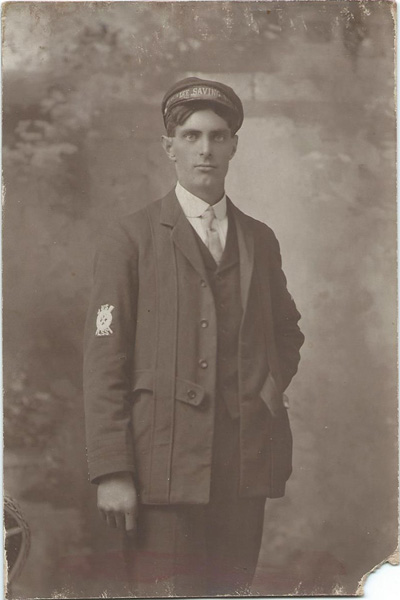
25111b.
[photograph] Life-Saving Service Surfman c.1900.
Original studio portrait style photograph of a Life-Saving Service Surfman. This
rare posed portrait photograph shows the young surfman casually posing in his
double-breasted uniform coat, unbuttoned. Clearly visible on his cap is the
lettering “U.S. Life Saving Service”. The photo measures 4” x 6”. There
is no photographer’s marking or label. Photo is clean and clear, some light
wear to edges. Provides good detail. It is quite rare to see such photos. (VG).
$165.

14292.
Hunt, Edward Soper. Weymouth Ways and Weymouth People -
REMINISCENCES.
Boston
. 1907. Reprint 2013. 307p. DJ. In Edward Hunt’s long and distinguished
career, no achievement gained him more satisfaction than his development of a
life-saving mortar or “Hunt Gun” adopted by the Massachusetts Humane Society
for the rescue of shipwrecked mariners. Later his gun was utilized by the United
States Life Saving Service as well, prior to the development of David Lyle’s
Bronze “C” gun. In Edward Hunt’s long and distinguished career, no
achievement gained him more satisfaction than his development of this life
saving system and the lives saved through his efforts. His life-saving gun had a
barrel is of bronze, 3 ½” muzzle diameter mounted on an oak base, with three
iron carrying handles. This is his memoirs, first published in 1907, which
contains chapters describing in detail his work on this early life-saving
device. Of particular interest are his descriptions of testing and instruction
given to the men at the Humans Society and Life-Saving Service on
Nauset
Beach
on Cape Cod and on
Nantucket
. (M). $32.
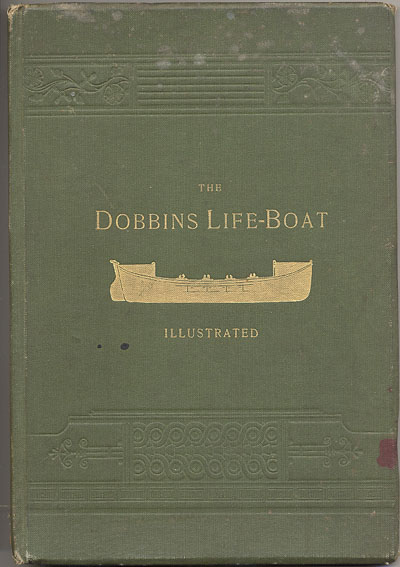 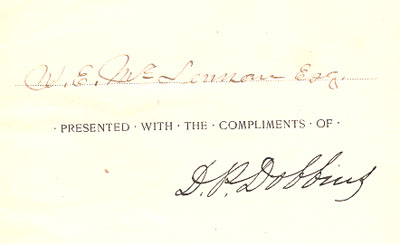
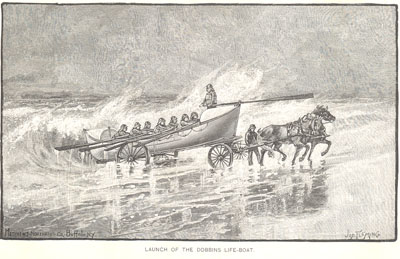
7238h. Dobbins, David Porter. THE
DOBBINS LIFE-BOAT ILLUSTRATED.
Buffalo
,
NY
. 1886. 48p. Gilt embossed beveled wraps with marbled endpapers. Exceptionally
scarce publication by the inventor of the self-righting life-boat that was
adopted for use by the United States Life-Saving Service. Mr. Dobbin’s
experience included over twenty five years on sail and steam vessels and ten
years experience as Superintendent of the Ninth District of the United States
Life-Saving Service. Here Mr. Dobbins presents a brief overview of advantages
and disadvantages of various life-boat designs and the design features of his
self-righting boat. Includes an addendum of testimonials by officers of the
United States
and Canadian Life-Saving Services. With engraved illustrations. Contents clean,
intact but becoming loose, hinges intact but becoming loose. Wraps with some
staining, edges worn, spine with one chip at base. (G+). $124.
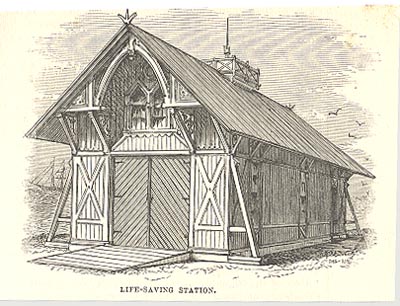
13396. (engraving) 1874-Type
life-saving station c.1870’s. Early engraving from periodical of
early 1874-Type life-saving station. Measures 3” x 4”. Great for
illustration. (VG+). $12.

29222d. [full page b/w plate with
article] Uniforms and Equipment - United
States Life-Saving Service, 1899-1915. The Company of Military
Historians. Winter 1976. Two page article with b/w full page plate details the
various uniforms used by the United States Life-Saving Service including
Keeper’s uniform, cook, surfman winter and other dress, storm suit, summer
uniform and more. Also includes numerous pieces of equipment including Lyle gun,
powder box, beach lantern, early station and more. Includes full page of
descriptions of uniforms and equipment from uniform regulations and other
research. The Company of Military Historians has published a continuing series
of articles and military prints, Military Uniforms in
America
, for many years. These b/w or full color prints are executed by different
member artists to illustrate military dress relating to the American scene. As
far as possible, the plates show items of material culture never illustrated
before or not accurately depicted in the past. They are a unique form of
reference. With over 800 plates completed to date, this continuing series
represents the single most comprehensive documentation available on the subject.
Excellent article and drawing, great for reference. Plate measures 8 ½” x
11” b/w. Full issue with additional articles on other military uniforms and
equipment including holsters, cartridge boxes, Confederate swords, militia coat,
and more. (VG+). $44.
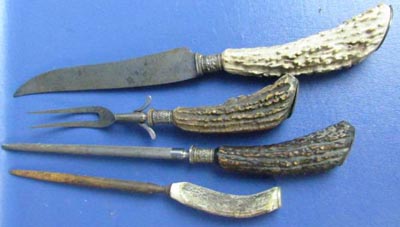 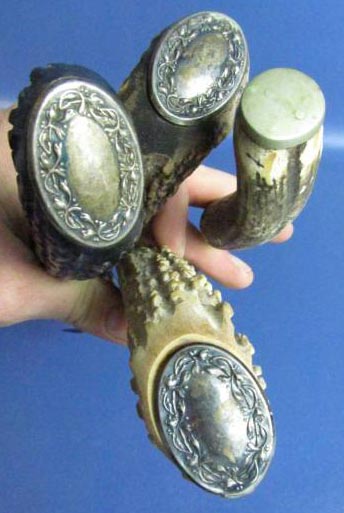
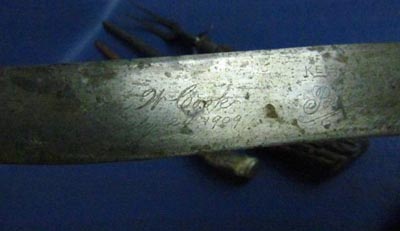 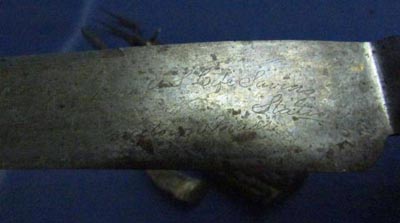
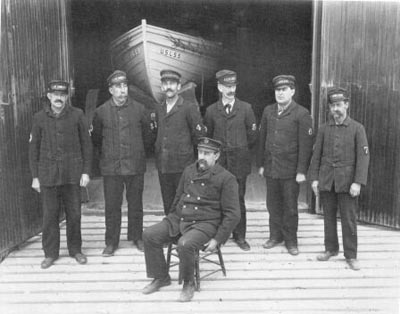 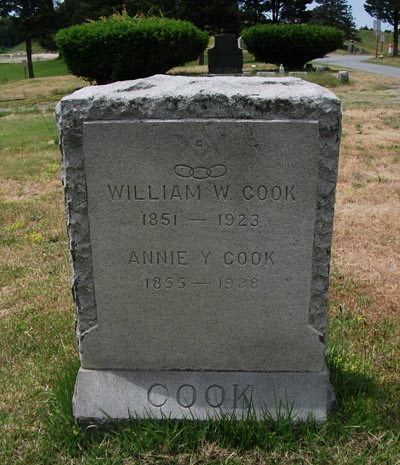
14143. (carving
set) William Wallace Cook (1851-1923), Keeper, Peaked
Hill Bars Life- Saving Station, Provincetown, Mass. c.1909. This is
an antique bone handle carving set, engraved from Keeper William W. Cook of
Peaked Hill Bars Life- Saving Station, Provincetown, Mass. The set consists of
three matching pieces and one additional piece, the largest being 15” in
length. The large knife is beautifully engraved “William W. Cook July 24,
1909. Keeper of Peaked Hill Bars U.S. Life Saving Station Provincetown
Mass.”One of the most dangerous stretches of coastline in the United States is
Peaked Hill Bars. Known as the graveyard of the Atlantic, Samuel Champlain named
it in his journal as "Mallebarre" in 1602. From the 64 gun British
frigate Somerset in 1778, to the JASON, the last full rigged ship to go aground
in 1873, hundreds of ships have been lost there spilling men's lives and ships
cargoes onto its shores. Peaked Hill Bars Lifesaving Station was located two and
one half miles east of Provincetown was another of the nine original stations
built in 1872. William Wallace Cook was born in Provincetown in 1852 and joined
King Hiram's Lodge November 3, 1879. As a boy he joined the fleet of
Provincetown whaling vessels that cruised on the north and south Atlantic
grounds becoming thoroughly familiar with boat handling. He attributed his great
success in the Lifesaving service to using a twenty one foot steering oar when
going to a wreck in a surfboat, similar to the kind used by him in his whaling
days. Cook was married to Annie Young Snow of Provincetown and they had an
adopted daughter. Cook was a great favorite of the Provincetown writers who
arrived during the 1920's, particularly Mary Heaton Vorse O'Brien. She relates
of bringing a lobster, a particular favorite of Captain Cook's to the station at
Peaked Hill Bars and his stories of wrecks and rescues. After serving as a
surfman at Peaked Hill Bars Station for fourteen years, William W. Cook was
appointed as Keeper on January 14, 1897 and served until he retired on November
3, 1915 at age 64. He passed away in 1923. He is shown seated at center in this
1901 photo (from Dalton. The Life Savers of Cape Cod). Completely intact, some
rust and soiling. Rare wonderful Cape Cod life-saving antique from a Cape Cod
estate. (VG). $525.
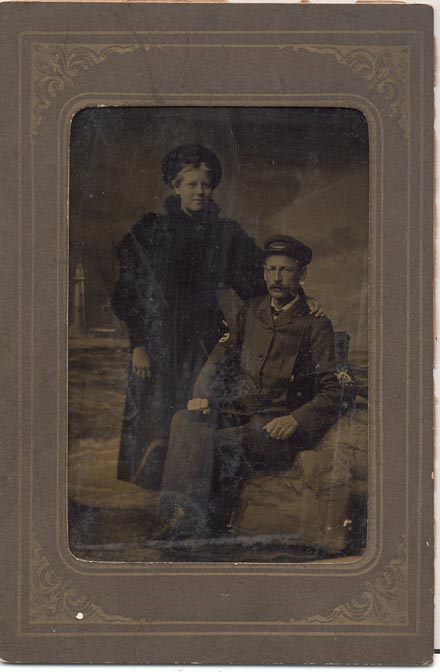
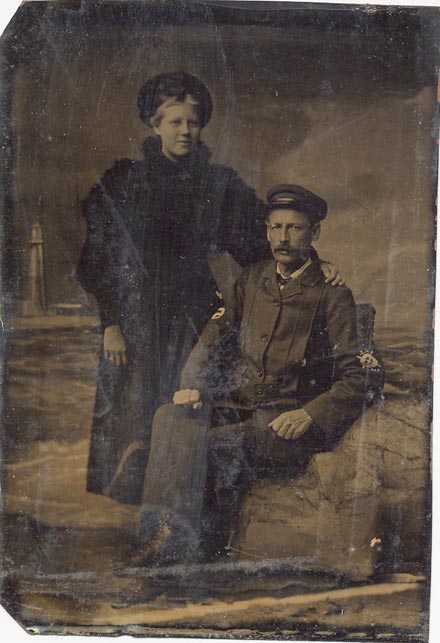
29221b.
(tintype) U.S. Life Saving Service Surfman c.1880’s. 1/4th.
plate. Offered is an incredibly rare tintype of a U.S. Life Saving Service
Surfman with wife or girlfriend. The subject is sitting in a chair, probably in
the photographer’s studio. Clearly visible is the gentleman’s cap, with no
markings, but on his uniform jacket right sleeve is the life ring with crossed
oar and pike and the letters “US” over “LSS”, and on his left sleeve is
his ranking number “5”. He appears to be a fairly young man. We have long
suspected that, like cabinet views and other early forms of photography, there
must have been some tintypes of life-savers produced but until now we had never
been able to find any. Presently this is one of only three known to us.
Tintypes, also known as a ferrotypes, originated in the early 1850’s and
became the choice for photographers before photographic paper was invented. The
use of this form peaked in the 1861-1870 period and began to give way to other
forms of photography by 1900. Tintypes were produced on a metallic sheet (not
actually tin) instead of the more common glass plates. The sheet was coated and
sensitized just before use, as in the wet plate process. These early metal
plates were then placed in the back of a box camera and exposed directly though
the camera lens. Because of this all forms of early photography resulted in a
mirror image of the subject, as is this image. The most common size for a
tintype was 2 5/8” x 3 ¼” [1/6 plate], but they were made in numerous
sizes. Tintypes were the first inexpensive photographic print and as such, made
photography available to the working class. Also, being quite rugged, tintypes
could be sent by mail, and many photographers did quite a trade visiting the
encampments during the Civil War. The surfman sports a single breasted jacket
common to life-savers of this early era, but without the brass buttons
instituted in the later in th e1880’s. I would suspect that this image was
captured in the early 1880’s, during the earlier years of the reorganized
Life-Saving Service. Measures 3 3/8” x 5” and is in original cardboard
mount. Condition is very good, clear, fine contrast, some scratches and marks
from mount and storage. Extremely rare. (VG). $425.

14147.
(photos) U.S. Life Saving Service Surfman c.1900.
Lot of two snapshot photos on portion of album page shows young surfman in
summer white uniform with his girlfriend, sitting in front of a Quonochontaug
style life-saving station. Photos measure 2 ¼” x 3 ¼” and are clean and
clear. (VG+). $22.
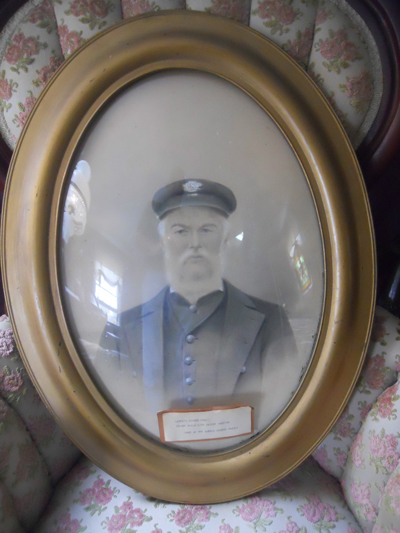 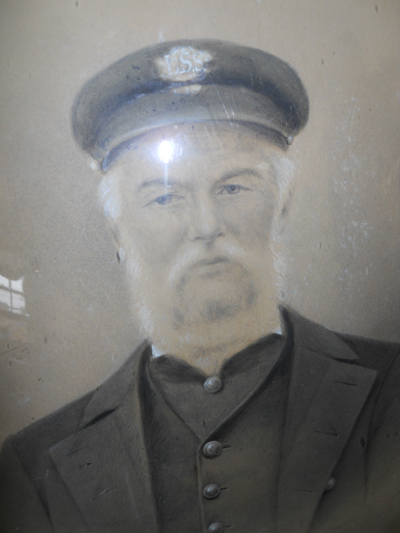
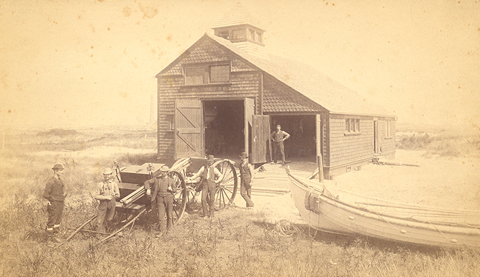
(similar 1871 Red House-Type station at
Fire Island. Not included.)
12315.
(framed portrait) Keeper Joseph F. Reed, U.S.
Life-Saving Service, Island Beach Station, NJ., c.1870-1880. Lovely
early hand-colored portrait, possibly from photo, of Keeper Joseph Reed of the
Island Beach Life-Saving Station, New Jersey on Barnegat Bay. Joseph Reed
was appointed Keeper of the Island Beach Life-Saving Station #14 in on December
30, 1870 and served until his death on March 15, 1895. The station was an 1871
Red House-Type station, built in 1872. Portrait is early as Reed is pictured
without uniform, with early style home made “LSS” insignia on kepi-style
cap. Portrait measures 13 ½” x 19 ½” oval, in period 2 ¾” wide gold
painted oval wood frame fitted with striking early convex glass. Overall
measures 24" x 18". A paper label on the back notes: "Captain
Joseph Reed, Island Beach Life Saving Station, lent by the Robert Brower
family". The photo was loaned for display in an area museum in the 1960's.
Rare early Life-Saving piece. No real issues other than a bit of cleaning
needed. (VG). $445.
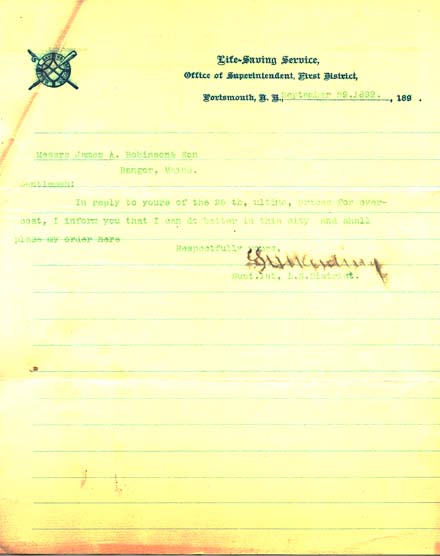
1234-26.
(document) U.S. Life-Saving Service, Office of
Superintendent, First District, Portsmouth, NH. c.1899. Silas H.
Harding, Superintendent, 1st. L.S. Dist. Original typed letter on official
stationery, signed in hand by Superintendent Harding, is addressed to James A.
Robinson & Son (clothiers), of Bangor, Maine, regarding pricing for an
overcoat. In the short, terse text Superintendent Harding notes that “In reply
to your [letter]…, prices for overcoat, I inform you that I can do better in
this city and shall place my order here. Dated September 29, 1899. 8” x 10”
on official Life-Saving Service stationery. Rare First District document in
overall clean, crisp condition, signature somewhat smudged, overall much better
than my image shows. A great piece to frame. (VG+). $74.
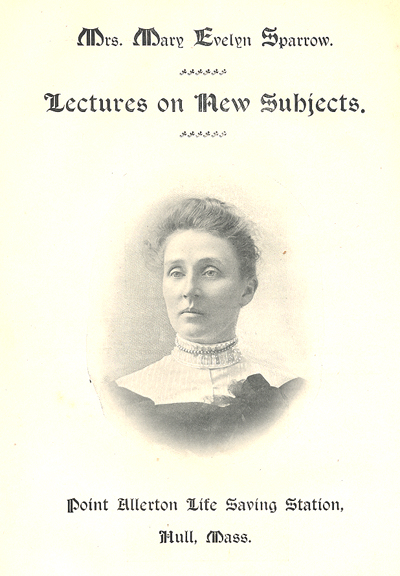
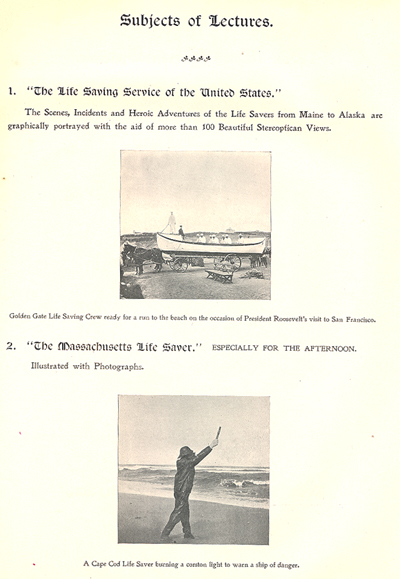
12431d.
(brochure) Sparrow, Mary Evelyn. Lectures on New
Subjects given at Point Allerton Life-Saving Station, Hull, Mass. The
Life-Saving Service of the United States. The Massachusetts Life-Saver. c.1904. 4p
folded. 8” x 11”. Keeper William Sparrow was the second keeper at the Point
Allerton Life-Saving Station and served there through its transition to the U.S.
Coast Guard in 1915. Point Allerton Station was one of the busier and more
distinguished in the Northeast. Other stations that he served at included Wood
End Station in Provincetown. When not involved with cooking and other duties at
the station, his wife, Mary Evelyn Sparrow, began traveling and lecturing on the
work of the U.S. life-savers in an effort to promote the work of the U.S.
Lifesaving Service, to increase public awareness of their hazardous work and
great life-saving record, and to aid in securing donations for shipwrecked
mariners as well as encourage politicians to support their work and thus secure
necessary government funds. Mrs. Sparrow used many photographs, as well as a set
of lantern slides, in public lectures she gave throughout New England and even
as far west as the Great Lakes. This brochure was used to advertise her three
lectures including: “The Life Saving Service of the United States”, “The
Massachusetts Life Saver”, and “Beautiful Women (In The Bible, In History,
In Song And Story, In The World Today)”. Brochure is illustrated with a few
Life-Saving Service photos, and includes 16 testimonials to Mrs. Sparow’s
abilities including one from General Superintendent Sumner I. Kimball,
Superintendents of the 2nd. and 3rd. Life-Saving Districts, the Boston Globe and
more. Rare early information and Life-Saving Service. collectible. Intact, light
edge wear, some moisture spotting and soiling to edges. (VG). $145.

14160.
Lane, Mark. The United States Life Saving Service.
Treasure Trove Magazine. October 1891. Half-page article discusses the short
history and work of the crews at the 225 stations in the country. Full issue
with interesting early articles of the day. (VG). $18.
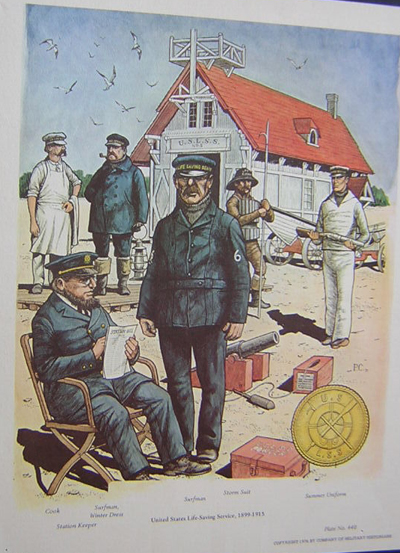 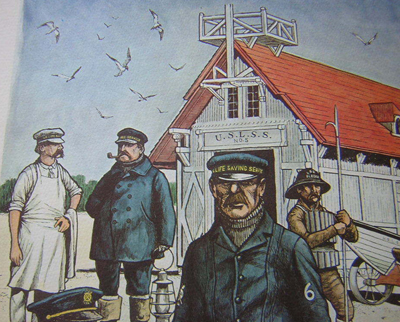
29222c. [full page plate] United
States Life-Saving Service, 1899-1915. The Company of Military
Historians. Winter 1976. Full color, full page plate details the various
uniforms used by the United States Life-Saving Service including Keeper’s
uniform, cook, surfman winter and other dress, storm suit, summer uniform and
more. Also includes numerous pieces of equipment including Lyle gun, powder box,
beach lantern, early station and more. The Company of Military Historians has
published a continuing series of articles and military prints, Military Uniforms
in
America
, for many years. These full color prints are executed by different member
artists to illustrate military dress relating to the American scene. As far as
possible, the plates show items of material culture never illustrated before or
not accurately depicted in the past. They are a unique form of reference. With
over 800 plates completed to date, this continuing series represents the single
most comprehensive documentation available on the subject. Excellent color plate
of Life-Saving Service uniforms and equipment for framing. Extremely difficult
to find. Light edge wear. (VG+-). $54.


12431c. (brochure) Sparrow,
Mary Evelyn. Lectures on New Subjects given at Point Allerton Life-Saving
Station, Hull, Mass. The Life-Saving Service of the United States. The
Massachusetts Life-Saver. c.1904. 4p folded. 8” x 11”. Keeper
William Sparrow was the second keeper at the Point Allerton Life-Saving Station
and served there through its transition to the U.S. Coast Guard in 1915. Point
Allerton Station was one of the busier and more distinguished in the Northeast.
Other stations that he served at included Wood End Station in Provincetown. When
not involved with cooking and other duties at the station, his wife, Mary Evelyn
Sparrow, began traveling and lecturing on the work of the U.S. life-savers in an
effort to promote the work of the U.S. Lifesaving Service, to increase public
awareness of their hazardous work and great life-saving record, and to aid in
securing donations for shipwrecked mariners as well as encourage politicians to
support their work and thus secure necessary government funds. Mrs. Sparrow used
many photographs, as well as a set of lantern slides, in public lectures she
gave throughout New England and even as far west as the Great Lakes. This
brochure was used to advertise her three lectures including: “The Life Saving
Service of the United States”, “The Massachusetts Life Saver”, and
“Beautiful Women (In The Bible, In History, In Song And Story, In The World
Today)”. Brochure is illustrated with a few Life-Saving Service photos, and
includes 16 testimonials to Mrs. Sparow’s abilities including one from General
Superintendent Sumner I. Kimball, Superintendents of the 2nd. and 3rd.
Life-Saving Districts, the Boston Globe and more. Rare early information and
Life-Saving Service. collectible. Intact though moderate edge wear, a few spots
and soiling to edges. (VG). $185.
 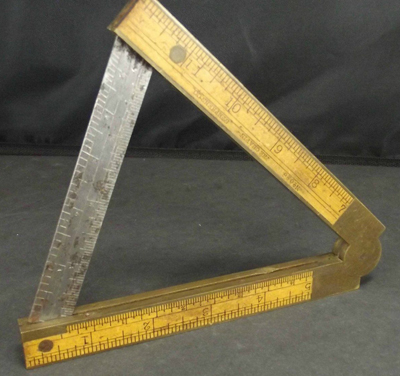
27361.
U. S.
Life Saving Service Lyle Gun Folding Octant c.1878-1901. This
octant, or elevation level, was used by the Life Saving Service for setting the
elevation of the Lyle Gun. From 1878 until 1901 the Life Saving Service use this
octant, made by the Chapin Stephens & Co in
Riverton
,
Conn.
In 1901 when this company ceased operation, the government began to make their
own elevation levels. However these were entirely of metal, lighter and of a
lesser quality. Octant is made of boxwood, brass bound and includes a metal
fold-out scale for setting the angle, with a bubble level set into the upper
arm. The octant was carried by the keeper in his haversack. Marked “No. 036
The Chapin Stephens Co” Scarce, early piece. Clean, bright, light rust to
scale. (VG+). $325. (similar shown)
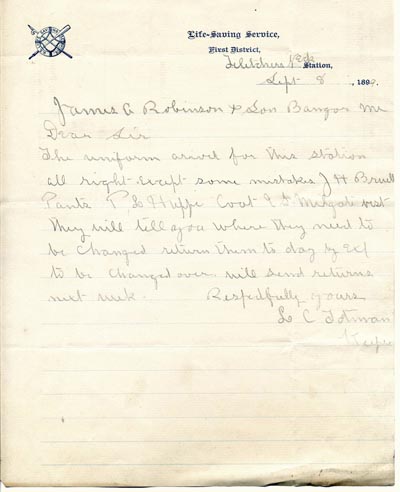
1234x.
(document) U.S. Life-Saving Service, First District,
Fletchers Neck Station. September 8, 1899. L.C. Totman, Keeper.
Original hand-written letter from Keeper Totman to James A. Robinson & Son
(clothiers), of Bangor, Maine, regarding difficulty with an order for coats.
Text reads: “Dear Sir. The uniform arrived for this station all right except
some mistakes. J.H. Bruell pants & P. L. Hupper coat L.S. Milgate vest. They
will tell you where they need to be changed. Return them to …by … to be
changed over. Will send returns next week. Respectfully yours, L.C. Totmans,
Keeper.” 8” x 10” on official Life-Saving Service stationery. Rare First
District document in overall clean, crisp condition. (VG+). $84.
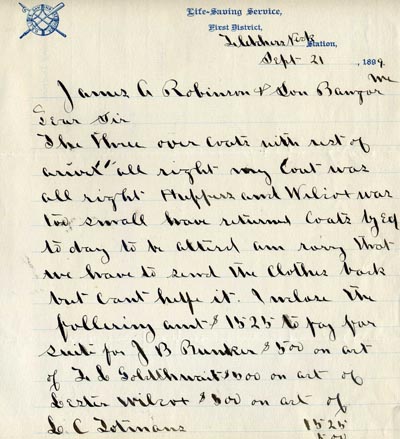
1234v.
(document) U.S. Life-Saving Service, First District,
Fletchers Neck Station. September 21, 1899. L.C. Totman, Keeper.
Original hand-written letter from Keeper Totman to James A. Robinson & Son
(clothiers), of Bangor, Maine, regarding difficulty with an order for coats.
Text reads: “Dear Sir. The three over coats with rest of …arrived all right.
My coat was all right. Huper’s and Wilcot was too small have returned coats by
Ed today to be altered am sorry that we have to send the clothes back but
can’t help it. I enclose the following ant $15.25 to pay for suit for J.B.
Bunker $5 on coat of J.L. Goldwaith $5 on …of Lislie Wilcot $5 on … of L.C.
Totmans. Respectfully yours, L.C. Totmans, Keeper.” 8” x 10” on official
Life-Saving Service stationery. Rare First District document in overall clean,
crisp condition. (VG+). $110.
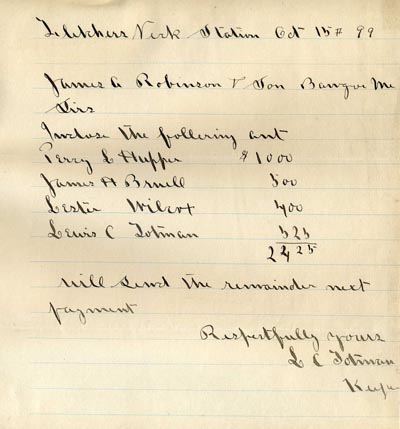
1234w.
(document) U.S. Life-Saving Service, First District,
Fletchers Neck Station. October 15, 1899. L.C. Totman, Keeper.
Original hand-written letter from Keeper Totman to James A. Robinson & Son
(clothiers), of Bangor, Maine, regarding payment for orders. Text reads:
“Inclose the following amt. Perry L. Hupper $10 James H. Bruell $5 Lislie
Wilcot $4 Levis C. Totman $5.25. Will send the remainder next payment.
Respectfully yours, L.C. Totmans, Keeper.” 8” x 10” on official
Life-Saving Service letter paper. Rare First District document in overall clean,
crisp condition. (VG+). $84.
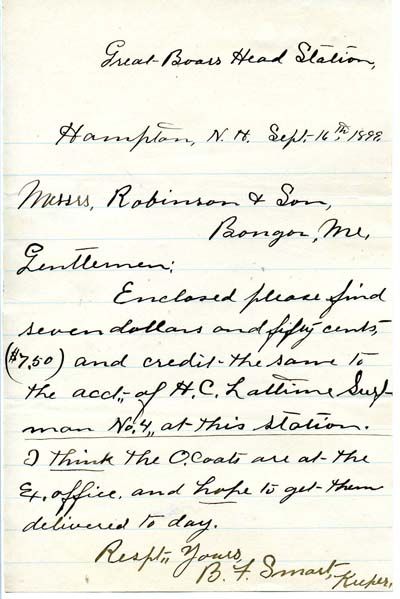
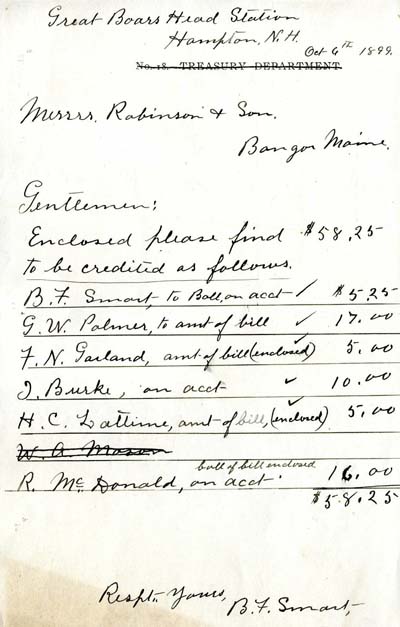
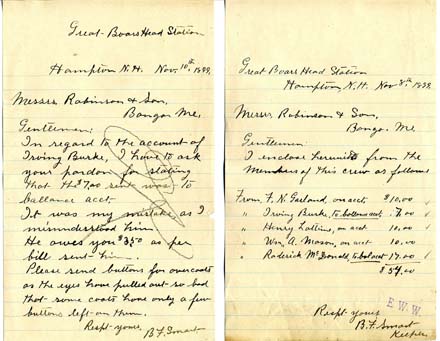
1234q.
(lot 4 documents) U.S. Life-Saving Service, First
District, Great Boars Head Life-Saving Station, Hampton, NH. c.1899.
1page each. B.F. Smart, Keeper. Lot of four original hand-written letters from
Keeper Smart to James A. Robinson & Son (clothiers), of Bangor, Maine,
regarding various orders for uniforms, accounts and payments, etc. For example,
text of one letter reads: “Gentlemen: In regard to the account of Irving
Burke, I have to ask your pardon for stating that the $7 was sent to balance
acct. It was my mistake as I misunderstood him. He owes you $3.50 as per bill
sent him. Please send buttons for over coats as the eyes have pulled out so bad
that some coats have only a few buttons left on them. Remaining three letters
are similar, regarding payments, accounts and delivery of uniforms and are dated
Sept. – Oct. 1899. Respectfully yours, B.F. Smart [Keeper].” About 5” x
8” on lined stationery (not letterhead). November 10, 1899. Rare set of
documents from the Keeper of the Great Boars Head Life-Saving Station. Overall
clean, crisp condition. (VG+). $174.
Rare U.S.
Life Saving Service Tintypes:
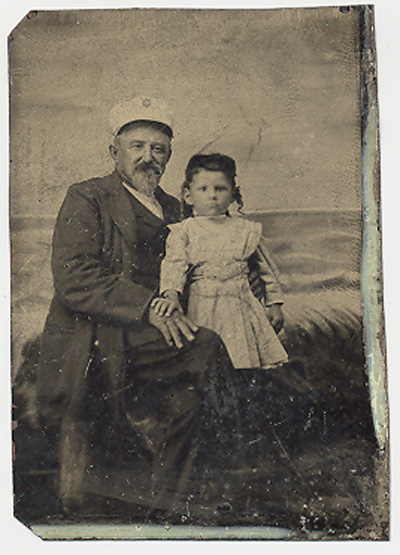
12504. (tintype) U.S. Life Saving Service
Keeper (New Jersey) c.1860-1870. 1/6th plate. Offered is an
incredibly rare tintype of a U.S. Life Saving Service Keeper, believed to
be in the New Jersey area. The subject is sitting in a chair with a young
girl, possibly his daughter, probably in the photographer’s studio.
Clearly visible is the gentleman’s white bell-top cap, with insignia
consisting of life ring with crossed oar and pike. The color of the hat
suggests that this is a station keeper, the only paid person dusing this
early 1849-1870 period before the reorganization of the Life-Saving
Service under General Superintendent Sumner I. Kimball. During this early
period there were no official uniforms and we find personnel wearing
locally designed clothing. The keeper’s weathered appearance speaks of
his long career on the sea. We have long suspected that, like cabinet
views and other early forms of photography, there must have been some
tintypes of life-savers produced but until recently we had never been able
to find any. Tintypes, also known as a ferrotypes, originated in the early
1850’s and became the choice for photographers before photographic paper
was invented. The use of this form peaked in the 1861-1870 period and
began to give way to other forms of photography by 1900. Tintypes were
produced on a metallic sheet (not actually tin) instead of the more common
glass plates. The sheet was coated and sensitized just before use, as in
the wet plate process. These early metal plates were then placed in the
back of a box camera and exposed directly though the camera lens. Because
of this all forms of early photography resulted in a mirror image of the
subject, as is this image. The most common size for a tintype was 2 5/8”
x 3 ¼” [1/6 plate], but they were made in numerous sizes. Tintypes were
the first inexpensive photographic print and as such, made photography
available to the working class. Also, being quite rugged, tintypes could
be sent by mail, and many photographers did quite a trade visiting the
encampments during the Civil War. The Keeper sports a jacket common to
life-savers of this early era, but without the brass buttons instituted in
the late 1870’s. Measures 2 3/8” x 3 9/16”. Condition is
exceptional, clear, good contrast. (VG). $625.
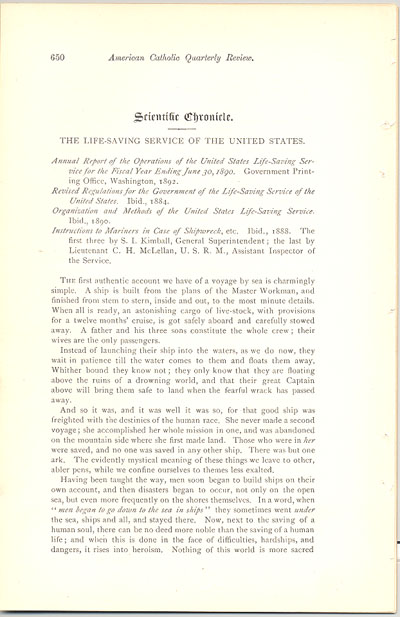
13236.
Freeman, Rev. Thomas J.A. The Life Saving Service in
the United States. The American Catholic Quarterly Review, 1893,
Volume XVIII., 17 Pages. Disbound. Chronicles the need and establishment of
life-saving services in the world since the time of Henry III (1216), but
focusing on the United States since the establishment of the Massachusetts
Humane Society in 1786. Detailed account describes the evolution of the U.S.
Life-Saving Service, the establishment of Districts and building and design of
new stations over the years and in various parts of the country. Also examines
the equipment design and its use, the lives of the men and much more. Quite a
nice, detailed account. Clean. (VG+). $54.
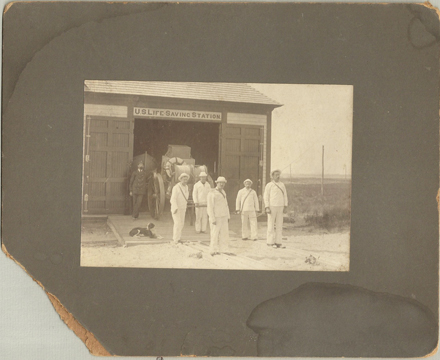
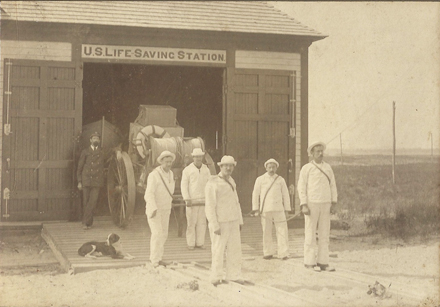
12479. (mounted photo) Captain
Thomas J. Maddock and Crew, Merrimack River Life-Saving Station, Plum Island,
Newburyport, Massachusetts c.1900-1910. Close clear mounted photo
provides a good view of the crew posing at the Bibb #2 station with the boatroom
doors open and beach cart on the ramp. Captain Maddock is leaning on the beach
cart wheel, with his dog laying in front. His five-man crew are posing in the
beach-cart pulling ropes. Photo itself is quite clear and crisp, on original
grey mount. Mount has one missing corner 2”, a few stains to margins. Will mat
and frame nicely. Great early detail. 4” x 5 ½” on 7 ½” x 9”. (VG).
$185.
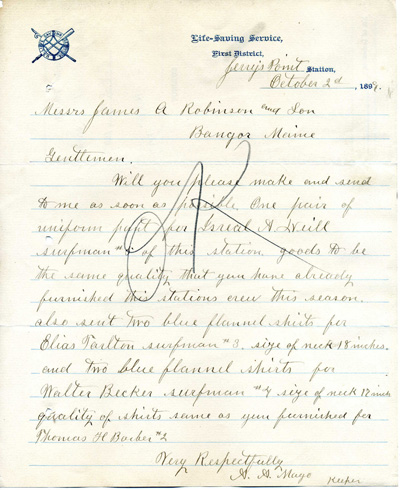
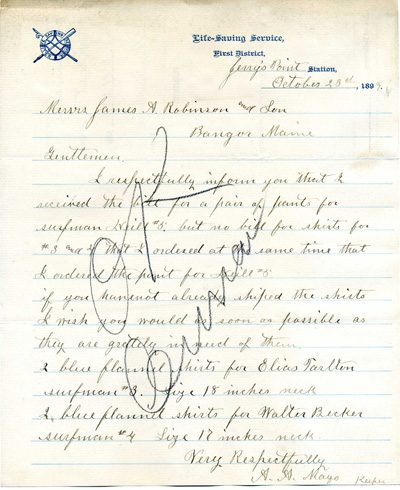
1234n.
(document) U.S. Life-Saving Service, First
District, Jerry’s Point Station c.1899. A.A. Mayo, Keeper.
Original hand-written letter from Keeper Mayo to James A. Robinson &
Son (clothiers), of Bangor, Maine, regarding order for surfman’s
uniforms. Text reads: “Gentlemen. Will you please make and send to me as
soon as possible one pair uniform pant for Isreal A. Hill surfman #5 of
this station, goods to be the same quality that you have already furnished
this station crew this season. Also sent two blue flannel shirts for Elias
Tarlton surfman #3 size of neck 18 inches and two blue flannel shirts for
Walter Becker surfman #4 size of neck 17 inches quality of shirts same as
you furnished for Thomas H. Barber #2. Very Respectfully, A.A. Mayo
Keeper.” Dated October 2, 1899. 8” x 10” on official Life-Saving
Service stationery. Rare First District document in overall clean, crisp
condition. (VG+). $110.
1234o.
(document) U.S. Life-Saving Service, First
District, Jerry’s Point Station c.1899. A.A. Mayo, Keeper.
Original hand-written letter from Keeper Mayo to James A. Robinson &
Son (clothiers), of Bangor, Maine, regarding order for surfman’s
uniforms. Text reads: “Gentlemen. I respectfully inform you that I
received the bill for a pair of pants for surfman Hill #5 but no bill for
shirts for #3 and 4 that I ordered at the same time that I ordered the
pant for Hill #5. If you have not already shipped the shirts I wish you
would as soon as possible as they are greatly in need of them. 2 blue
flannel shirts for Elias Tarlton surfman #3 size 18 inches neck 2 blue
flannel shirts for Walter Becker surfman #4 size 17 inches neck. Very
Respectfully, A.A. Mayo Keeper.” Dated October 28, 1899. 8” x 10” on
official Life-Saving Service stationery. Rare First District document in
overall clean, crisp condition. (VG+). $110.
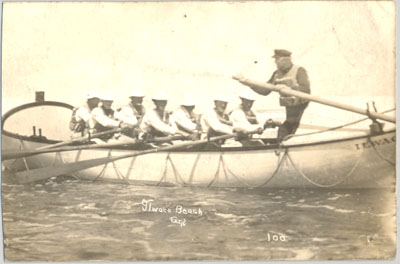
12418. (photo) Dobbins
type pulling lifeboat, 28ft. version (boat No. 884). Station Ilwaco/Klipsan,
Washington c.1910. Rare view shows great detail of the 8 surfmen and
keeper rowing the rare Dobbins pulling surfboat of the Ilwaco Beach Life Saving
Station. The boat in the photo is a Dobbins type pulling lifeboat. Station
Ilwaco/Klipsan had two of them at various times, with the first being a 27ft.
version that they inherited from Station Golden Gate Park in 1892 (no boat
number assigned), and the second being a slightly larger 28ft. version (boat No.
884) which they received new in 1909. This may be either, but probably No. 884,
the 28-footer Dobbins lifeboat. Rare view of this seldom seen boat model. Great
early detail, on postcard paper. Not postmarked, light wear, clear and close.
Dates from c.1904-1915 based on the backmark. (VG). $86.
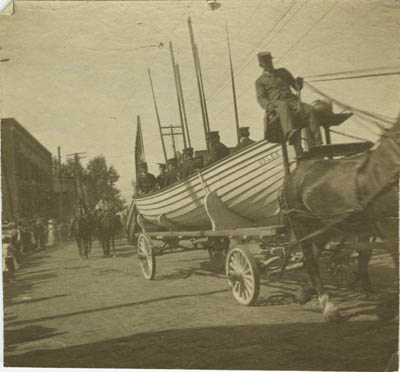
12467.
(photo) U.S. Life-Saving Service Horse-Drawn Parade
Float c.1900. Rare view shows Life-Saving crew in surfboat on
carriage, oars in upright position, being drawn by a team of horses in a
parade. “U.S.L.S.S. can be seen on the bow of the boat but location is
not known. Measures 3” x 3 ¼”. Clear, close view. (VG+). $68.
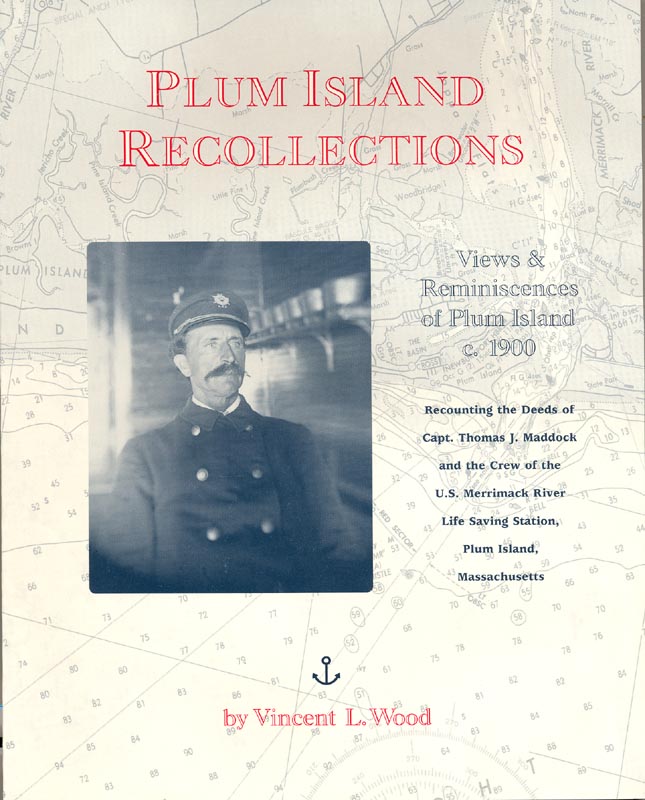
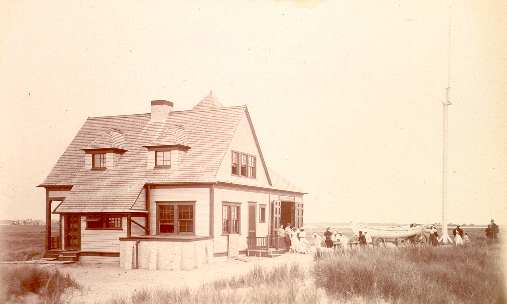
6641. Wood, Vincent L., PLUM ISLAND
RECOLLECTIONS - Views and Reminiscences of Plum Island c.1900 Recounting
the Deeds of Capt. Thomas J. Maddock and the Crew of the U. S. Merrimack
River Life-Saving Station, Plum Island, Massachusetts.
Newburyport
. 1995. 81p. Soft wraps. Signed by the author. Whatever your interest, you are sure to enjoy
this readable account of every day life at a station of the U. S.
Life-Saving Service. This wonderful account of life as Keeper of the
Merrimack River Life-Saving Station brings together over 80 never before
published vintage photographs made from the family’s archives of glass
plate negatives. Taken by Mr. Wood’s grandfather, these negatives
provide unusually clear, crisp views which have been faithfully reproduced
in a high quality format. Using these views, along with personal notes and
family memories, Mr. Wood presents a rare portrait of station life and
training in 1910. This interesting account is only available here and is
priced unusually low considering the rare accounts and quality
photographs, well worth the retail price. A wonderful addition to your
library. (M). $24.95.
Rare U.S.
Life Saving Service Tintypes:
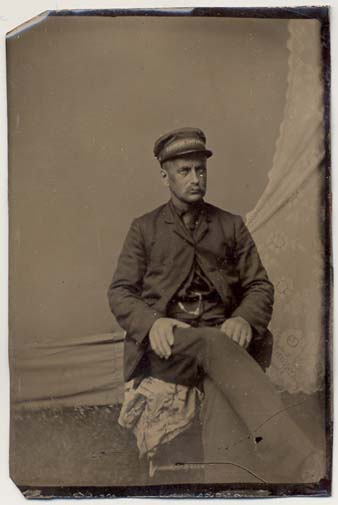

29221. (tintype) U.S.
Life Saving Service Surfman c.1870. 1/6th plate. Offered is an
incredibly rare tintype of a U.S. Life Saving Service Surfman. The subject
is sitting in a chair, probably in the photographer’s studio. Clearly
visible is the gentleman’s cap, with the words [LIFE] “SAVING
SERVICE” visible to the camera. His weathered appearance speaks of his
long career on the sea. We have long suspected that, like cabinet views
and other early forms of photography, there must have been some tintypes
of life-savers produced but until now we had never been able to find any.
Presently this is the only one known to us. Tintypes, also known as a
ferrotypes, originated in the early 1850’s and became the choice for
photographers before photographic paper was invented. The use of this form
peaked in the 1861-1870 period and began to give way to other forms of
photography by 1900. Tintypes were produced on a metallic sheet (not
actually tin) instead of the more common glass plates. The sheet was
coated and sensitized just before use, as in the wet plate process. These
early metal plates were then placed in the back of a box camera and
exposed directly though the camera lens. Because of this all forms of
early photography resulted in a mirror image of the subject, as is this
image. The most common size for a tintype was 2 5/8” x 3 ¼” [1/6
plate], but they were made in numerous sizes. Tintypes were the first
inexpensive photographic print and as such, made photography available to
the working class. Also, being quite rugged, tintypes could be sent by
mail, and many photographers did quite a trade visiting the encampments
during the Civil War. The surfman sports a jacket common to life-savers of
this early era, but without the brass buttons instituted in the late
1870’s. I would suspect that this image was captured in the early
1870’s, at the inception of the reorganized Life-Saving Service.
Measures 2 3/8” x 3 9/16”. Condition is exceptional, clear, fine
contrast, no scratches to image. (VG+). $625.
12504. (tintype) U.S. Life Saving Service
Keeper (New Jersey) c.1860-1870. 1/6th plate. Offered is an
incredibly rare tintype of a U.S. Life Saving Service Keeper, believed to
be in the New Jersey area. The subject is sitting in a chair with a young
girl, possibly his daughter, probably in the photographer’s studio.
Clearly visible is the gentleman’s white bell-top cap, with insignia
consisting of life ring with crossed oar and pike. The color of the hat
suggests that this is a station keeper, the only paid person dusing this
early 1849-1870 period before the reorganization of the Life-Saving
Service under General Superintendent Sumner I. Kimball. During this early
period there were no official uniforms and we find personnel wearing
locally designed clothing. The keeper’s weathered appearance speaks of
his long career on the sea. We have long suspected that, like cabinet
views and other early forms of photography, there must have been some
tintypes of life-savers produced but until recently we had never been able
to find any. Tintypes, also known as a ferrotypes, originated in the early
1850’s and became the choice for photographers before photographic paper
was invented. The use of this form peaked in the 1861-1870 period and
began to give way to other forms of photography by 1900. Tintypes were
produced on a metallic sheet (not actually tin) instead of the more common
glass plates. The sheet was coated and sensitized just before use, as in
the wet plate process. These early metal plates were then placed in the
back of a box camera and exposed directly though the camera lens. Because
of this all forms of early photography resulted in a mirror image of the
subject, as is this image. The most common size for a tintype was 2 5/8”
x 3 ¼” [1/6 plate], but they were made in numerous sizes. Tintypes were
the first inexpensive photographic print and as such, made photography
available to the working class. Also, being quite rugged, tintypes could
be sent by mail, and many photographers did quite a trade visiting the
encampments during the Civil War. The Keeper sports a jacket common to
life-savers of this early era, but without the brass buttons instituted in
the late 1870’s. Measures 2 3/8” x 3 9/16”. Condition is
exceptional, clear, good contrast. (VG). $625.
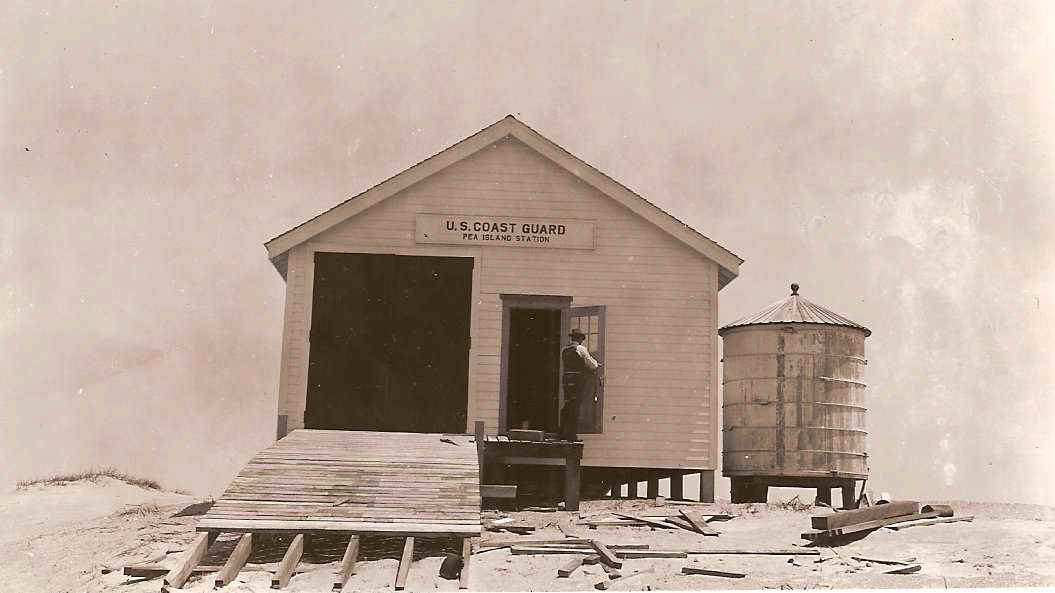
11501. Stover, Douglas. Pea
Island Life-Saving Station, Rodanthe, North Carolina, Coast Guard Station #177 :
Historic Resource Study. National Park Service. 2008. 83p. Provides a
valuable foundation for the restoration of historic structures and insights into
the lives of the crews. Report is particularly important in documenting the
historic significance of the property and the accomplishments of the Life-Saving
Service and Coast Guard crews here. In this case, the Pea Island, North Carolina
Life-Saving Station was studied using evidence present at the site, historical
documents found at the National Archives, Life-Saving Service records, logs,
reports, letters from the keepers and more. Using these and other sources, the
author is able to provide a detailed assessment of how the structure would have
looked during the period of interest, and more. The report includes numerous
period and current photos and diagrams, architectural plans, and excerpts from
Life-Saving Service books and documents, original specifications, and more for
guidance. A most important reference for anyone interested in what the station
building(s) would have contained and looked like as well as an in depth look at
the construction and work of the Life-Saving Service there. (no longer in print)
PDF File on Disc. (M) $29.95. (x)
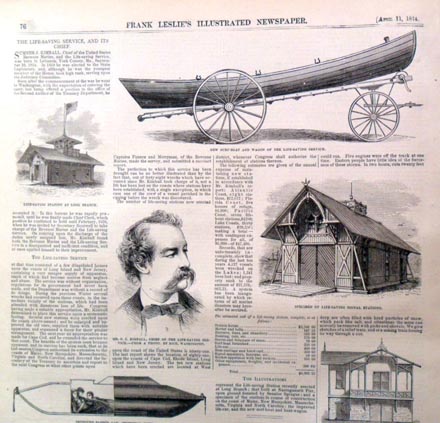
12505. The
Life-Saving Service, and its Chief. Frank Leslie's Illustrated
Newspaper. April 11, 1874. Lengthy full page article describes the new
Life-Saving Service and its new Chief, Sumner I. Kimball. Good detail includes a
brief biography of Chief Kimball, a look at the Service and the improvements
that will be implemented, new stations being built and their costs, and more.
Includes six beautiful woodcut engravings depicts Chief Kimball himself,
life-saving station at Long Branch, new station design, new surf-boat and
carriage, improved “safety-car”, life-saving station at Narragansett, R.I.
Great illustrations, wonderful detail. Full issue includes other articles and
advertisements of the day. Intact, clean, fine for framing. (VG+). $58.
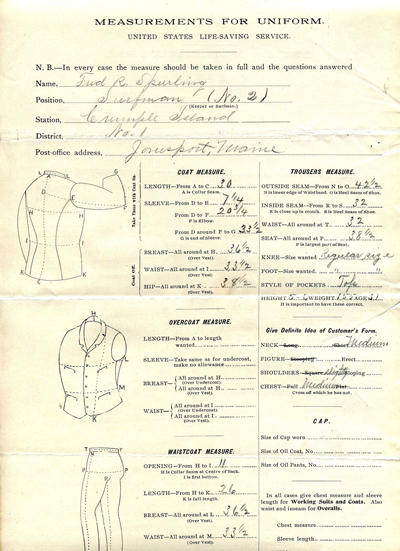 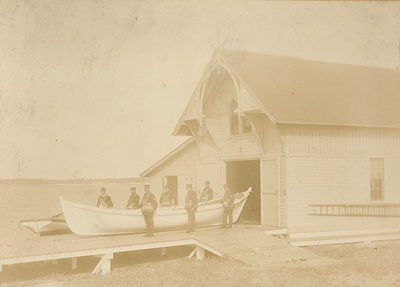
1258d. U.S.
Life-Saving Service. Order Form for Uniform for Crumple Island Life-Saving
Station, Jonesport, Maine c.1899. 2p. 8 ½” x 14”. Two page
original Life-Saving Service uniform form for Oehm & Co., Army and Navy
Outfitters of Baltimore, Md., includes all necessary forms for ordering and
paying for uniforms. Includes listing of items ordered including Kersey coats,
vests and trousers for winter, flannel for summer, caps, overcoats, jumpers,
storm suits, cap ornaments, and buttons. Also includes page for measurements
with diagrams. Filled out for Surfman No. 2 Fred R. Spurling at Crumple Island
Life-Saving Station, Jonesport, Maine. Form is filled out in hand by Surfman
Spurling. Rare early Life-Saving Service uniform information and form. Expected
wear, light soiling, original folds. (VG). $185.
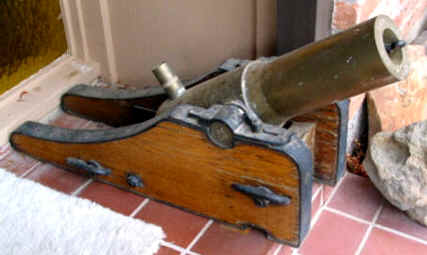

20386. Barnett, J. P., THE
LIFESAVING GUNS OF DAVID LYLE.
South Bend
. 1976. 3rd. 108p. Soft wraps. 3rd. updated edition. This is the definitive
reference on this well known backbone of the Life-Saving Service and early Coast
Guard – the Lyle Gun. Using early records and searching out makers and
specimens, the author presents a most complete account of the manufacture and
history of these important tools. Includes Manby mortar, Hunt gun, and numerous
civilian guns including Hall’s, Coston, Cunningham’s rockets, Galbraith,
General Ordnance, Naval Co., Steward, American Ordinance, Sculler, HTP, and many
more. Also includes firing mechanisms, faking equipment, projectiles, octants,
powder, performance tests, and more. Filled with vintage photos and diagrams,
this is an extremely valuable reference on the subject. (M). $21.50.

12435. (photo) U.S.
Life Saving Service Crew, Big Sandy Life-Saving Station, Lake Ontario c.1913. Great
image shows a close, clear view of the keeper and his 6-man crew posing outside
with their beach apparatus cart. Rare, clean and clear, nice view of uniforms,
insignia, beach cart, etc. The life saving station at the mouth of Sandy creek
was established in 1876. Before the station went into operation, more than 80
boats and vessels were driven into the Mexico bay region, and of this number
one-half were total wrecks, while the fatalities aggregated 80 lives lost. Great
early detail, on postcard paper. Postmarked 1913. Only very light wear, clear
and close. (VG+). $156.

12248i.
[envelope] Office of Superintendent of Life-Saving
Stations, Second District, East Orleans, Mass. c.1892. Original
envelope from District Superintendent Benjamin C. Sparrow addressed to Keeper
E.P. Worthen, Highland Life-Saving Station No. 8, North Truro. With nicely
printed return address, envelope is cancelled but without stamp. Great rare
piece for framing. Expected moderate soiling. (G). $26.
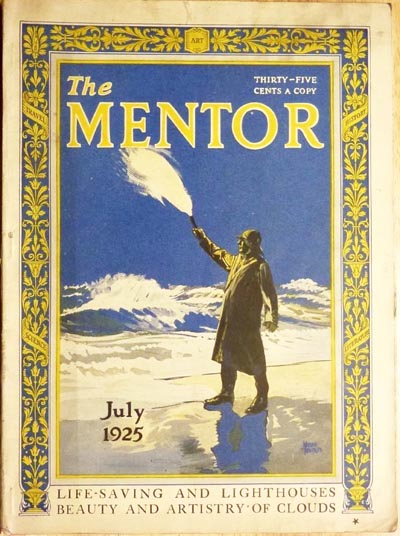 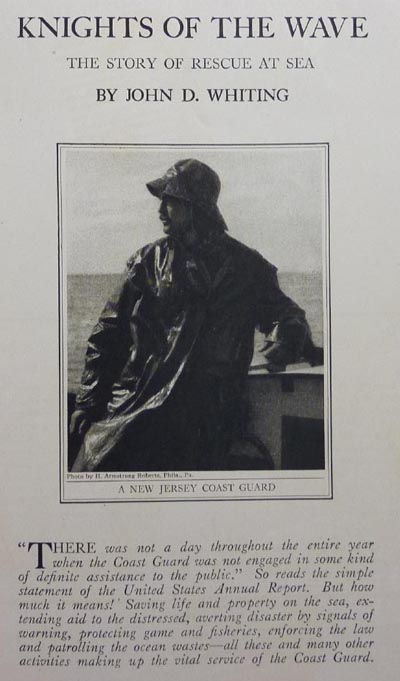

7159q.
(magazine) THE MENTOR. July 1925. Vol. 13,
No. 6. Pub.
Springfield
,
Ohio
. 66 pp. b/w photos & gravures: few color ads. Special
issue devoted to the U. S. Coast Guard, Lifesaving Service and Lighthouse
Service contains 4 articles with beautiful illustrations chronicling
the history and work of the Life-Saving Service, the Light-House Service and the
Coast Guard. Includes an article on "Lighthouses Tended by Women",
article on Winslow Homer titled "He Painted the Might of the Sea" and
containing reproductions of his paintings of the Lifesaving Service, a photo-article
titled "Picturesque Lighthouses", featuring photos of 11 different
lighthouses, article "Through Calm & Storm" relating to
lighthouses & Coast Signals, and the article "Knights of the Wave"
17 pages with 16 photos relating "The Story of Rescue at Sea-Duties,
Responsibilities and Perilous Service of the Coast Guard of Today". An
important lighthouse and life-saving issue. Clean, tight, light spine wear, good
copy. (VG). $46.
7159s.
(magazine) THE MENTOR. July 1925. Vol. 13,
No. 6. Pub.
Springfield
,
Ohio
. 66 pp. b/w photos & gravures: few color ads. Special
issue devoted to the U. S. Coast Guard, Lifesaving Service and Lighthouse
Service contains 4 articles with beautiful illustrations chronicling
the history and work of the Life-Saving Service, the Light-House Service and the
Coast Guard. Includes an article on "Lighthouses Tended by Women",
article on Winslow Homer titled "He Painted the Might of the Sea" and
containing reproductions of his paintings of the Lifesaving Service, a photo-article
titled "Picturesque Lighthouses", featuring photos of 11 different
lighthouses, article "Through Calm & Storm" relating to
lighthouses & Coast Signals, and the article "Knights of the Wave"
17 pages with 16 photos relating "The Story of Rescue at Sea-Duties,
Responsibilities and Perilous Service of the Coast Guard of Today". An
important lighthouse and life-saving issue. Clean, tight, light wear, good copy.
(VG+). $48.


12431. (brochure) Sparrow,
Mary Evelyn. Lectures on New Subjects given at Point Allerton Life-Saving
Station, Hull, Mass. The Life-Saving Service of the United States.
The Massachusetts Life-Saver. c.1904. 4p folded. 8” x 11”. Keeper William
Sparrow was the second keeper at the Point Allerton Life-Saving Station and
served there through its transition to the U.S. Coast Guard in 1915. Point
Allerton Station was one of the busier and more distinguished in the Northeast.
Other stations that he served at included Wood End Station in Provincetown. When
not involved with cooking and other duties at the station, his wife, Mary Evelyn
Sparrow, began traveling and lecturing on the work of the U.S. life-savers in an
effort to promote the work of the U.S. Lifesaving Service, to increase public
awareness of their hazardous work and great life-saving record, and to aid in
securing donations for shipwrecked mariners as well as encourage politicians to
support their work and thus secure necessary government funds. Mrs. Sparrow used
many photographs, as well as a set of lantern slides, in public lectures she
gave throughout New England and even as far west as the Great Lakes. This
brochure was used to advertise her three lectures including: “The Life Saving
Service of the United States”, “The Massachusetts Life Saver”, and
“Beautiful Women (In The Bible, In History, In Song And Story, In The World
Today”. Brochure is illustrated with a few Life-Saving Service photos, and
includes 16 testimonials to Mrs. Sparrow’s abilities including one from
General Superintendent Sumner I. Kimball, Superintendents of the 2nd. and 3rd.
Life-Saving Districts, the Boston Globe and more. Rare early information and
Life-Saving Service. collectible. Intact though moderate edge wear, a few spots
and soiling to edges. (VG-). $225.
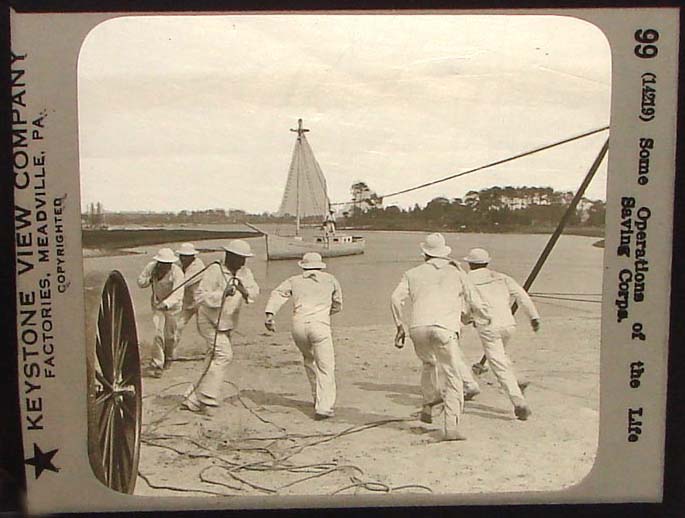
8426b,c,d.
[glass slide] Some Operations of the Life-Saving Corps,
Jamestown
Exposition. #14219. c.1907 by Keystone View Company. Beautiful b/w
glass projection slide featuring the Life-Saving Service performing breeches
buoy drill at the Jamestown Exposition. The crew of six are in the foreground
pulling a seventh member from an offshore vessel. The pinstriped wheels of the
beach apparatus cart are just visible in the foreground. Slide measures 3 ¼”
x 4” and presents a superb, clear image. Includes original printed
description. (F). $32. Reduced $26.
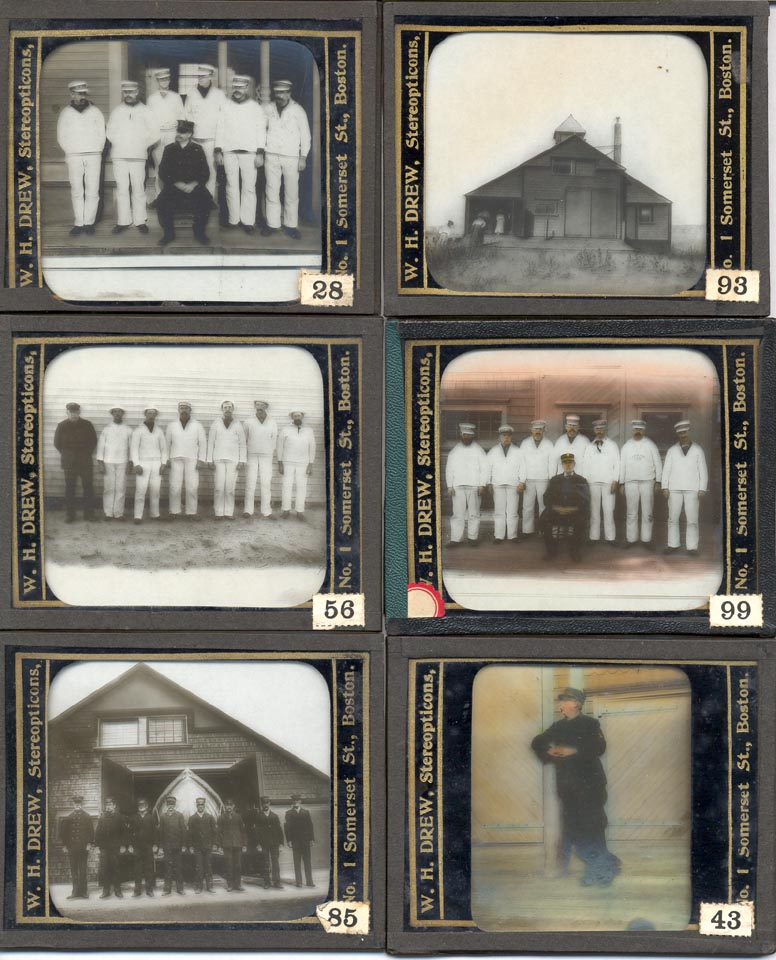
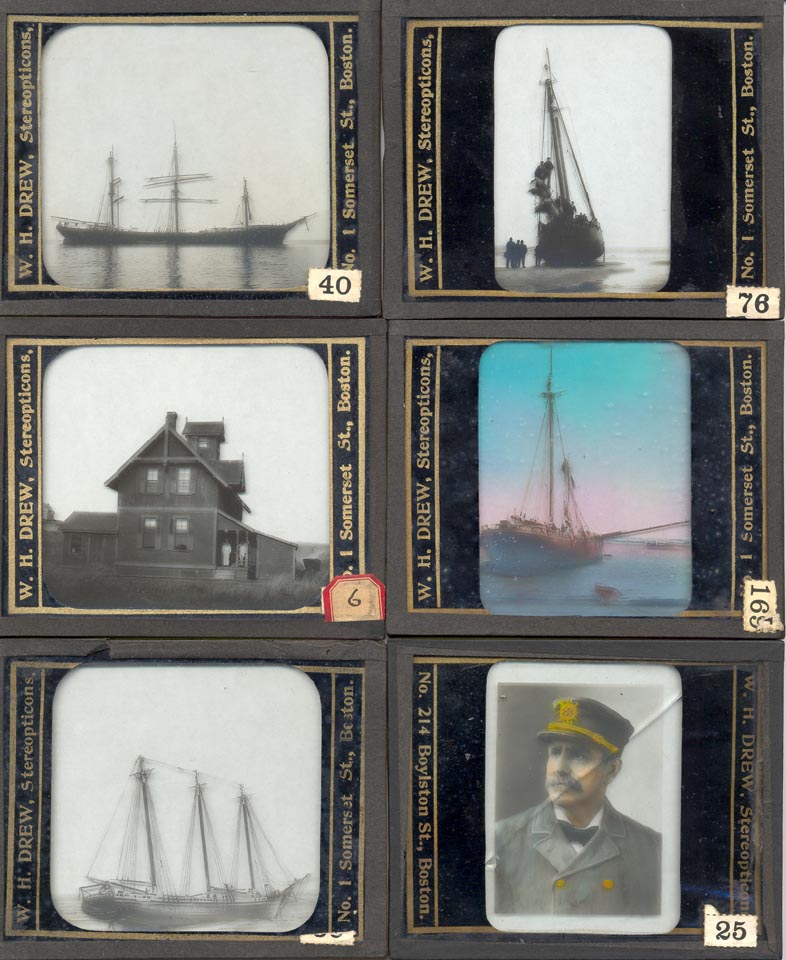
28122. [15 glass slide set] The
Life-Savers of Cape Cod. c.1902. In 1902 Dalton wrote probably the
finest and most complete history of the Life-Saving Service and its 13 stations
on the outer reaches of
Cape Cod
. In it he looked at each of the 13 stations individually including their men,
equipment, construction and modifications of the buildings, rescues, and much
more. It was profusely illustrated with over 100 fine b/w photographs. During
this period, surfman Asa Cobb Paine Lombard along with his Cahoon’s Hollow
companion, Eugene Young, gave lectures at the time in the eastern part of
Massachusetts
describing the wrecks that occurred on Cape Cod from Monomoy to
Provincetown
, explaining how rescue attempts were made, and the operations of the United
States Life Saving Service. The proceeds from the lectures were used to buy
Station personnel the necessary extras needed to perform their duties —
equipment not provided by the government. In addition, other surfmen gave
similar lectures, all using similar b/w projection slides using these images
from Dalton’s book and others. This lot of 15 glass projection slides is from
such a set used for these lectures. Crystal clear views include: Surfman E. S.
Dyer, Pamet River LSS, oldest surfman in the U.S.L.S.S.; wreck Katie J. Barrett
breaking up on beach; ship A. S. Ropes dismasted off Provincetown; Highland LSS
crew; wreck Panchita driven ashore in Provincetown; High Head LSS; High Head LSS
crew; Wood End LSS crew; Nauset LSS crew; Monomoy LSS; Keeper Seth Ellis, Keeper
Monomoy LSS; Keeper Joseph Kelley, Monomoy Point LSS; Schooner ashore; wreckage
on beach; dismasted schooner. The views are superb and crystal clear, perfect
for printing or projecting in a proper projector. Slides measures 3 ¼” x 4”
and presents a superb, clear image. Two slides have crack but are intact,
remaining near fine. (VG+). $445. Reduced $325.
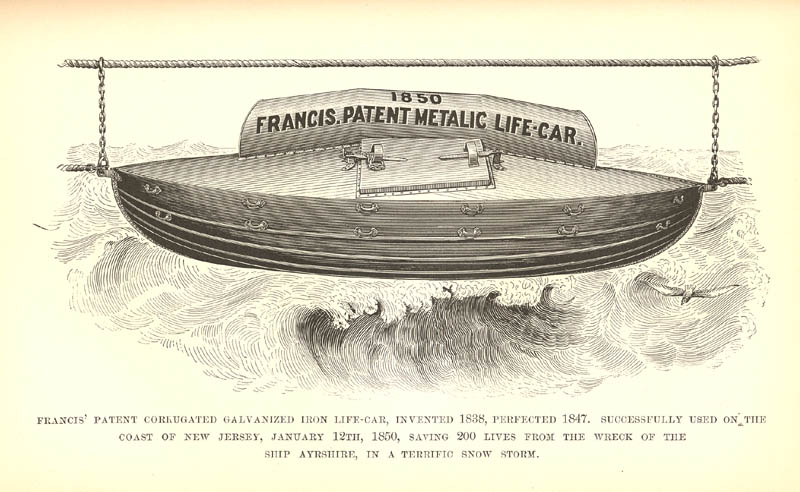
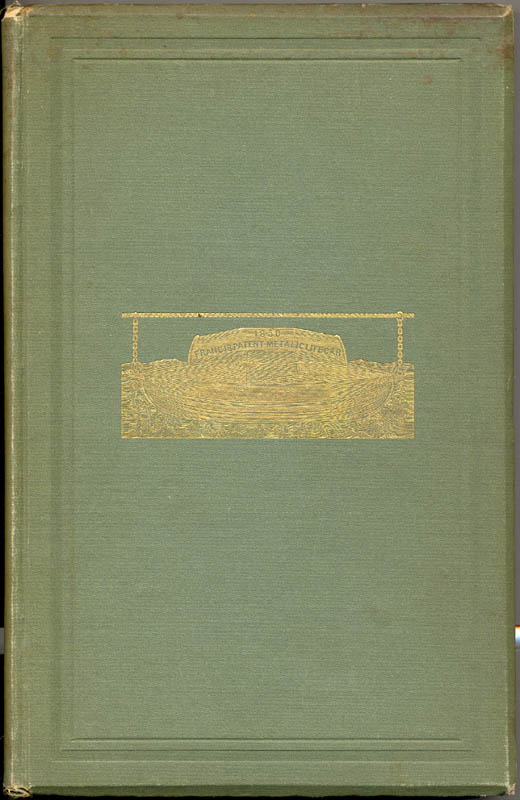
4234.
Pond, James L., HISTORY OF LIFE-SAVING APPLIANCES, AND
MILITARY AND NAVAL CONSTRUCTIONS. INVENTED AND MANUFACTURED BY JOSEPH FRANCIS
WITH SKETCHES AND INCIDENTS OF HIS BUSINESS LIFE IN THE UNITED STATES AND
EUROPE
....
New York
. Published and Printed by E. D. Slater 1885. 127. Tall octavo, olive green
cloth titled in gilt on spine with gilt embossed vignette of the "1850
Francis Patent Metallic Life-Car". on front cover. Indexed; illustrated in
black and white throughout with 17 wonderful engraved illustrations, with
several full-page drawings and a folding plate of equipment related to
life-saving and life boat construction. With presentation label from Joseph
Francis pasted to inside front board. First edition presented to Captain
Franklin C. Jessup by Joseph Francis, with Jessup’s name handwritten on
Francis’s printed presentation label mounted on the front pastedown. The book
is wonderfully illustrated with plates depicting shipwrecks and other maritime
accidents, and boats and equipment built by Francis. Chronicles the design and
use of Francis’ life-saving appliances including his Patent Metal Life-Car,
which saw use on the coast of
New Jersey
in January, 1850 and was credited with saving 200 lives from the wreck of the
Ayrshire. Later the metallic life-car was adopted for use by the United States
Life-Saving Service. Excellent descriptions of many terrible wrecks and rescues
including the Ayrshire, with many fine engravings. Also includes a great deal of
information regarding many other designs of life-saving appliances, some of
which were adopted for use by the Life-Saving services throughout the world. The
binding is rubbed & stained; the covers are bumped & the head of the
spine is chipped. there is insect damage to the portrait frontispiece & to
the front edges of the following 3 leaves & of the last 24 pages of the
book; there is a short tear to the bottom edge of the folding plate; there is
occasional light soiling & staining. A most important work by this early
life-saving inventor, a sought after collector’s piece. (VG). $275. Reduced
$185.

9139. Means, Dennis R., A
HEAVY
SEA
RUNNING: THE FORMATION OF THE
U. S.
LIFE-SAVING SERVICE 1846-1878. [Prologue pp.222-243. Journal of the
National Archives. Winter 1987 Vol. 19, No.4.] This excellent issue has become
almost impossible to find and contains a thoroughly research article detailing
the numerous events leading up to the formation of the Life-saving Service.
Included is information on Senator John P. Stockton who helped convince Congress
to employ surfmen, Treasury Secretary James Guthrie who obtained Congressional
support for local keepers in 1854, Treasury Secretary George Boutwell who
promoted Sumner Kimball and much more. Wonderfully illustrated with many early
photographs and engravings. This is one of the better accounts of the early
years. (M). $38.
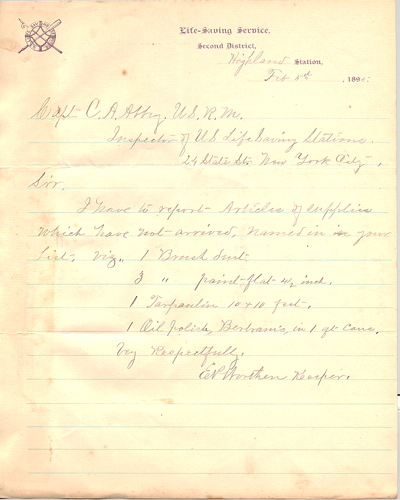
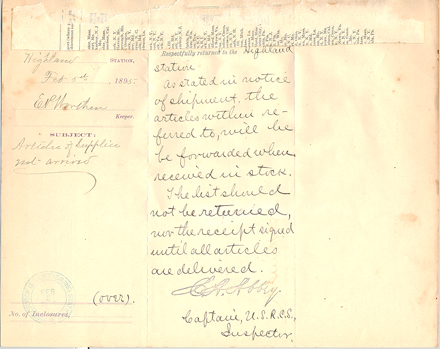
12248a.
(document) U.S. Life-Saving Service, Second
District, Highland Station, Cape Cod c.1895. E.P. Worthen, Keeper.
Original hand-written letter on official stationery from Keeper Edwin P. Worthen
to Captain C.A. Abbey, U.S. Revenue Marine, Inspector of U.S. Life-Saving
Stations, New York City, regarding supplies that have not yet arrived. The
letter reads: “Sir. I have to report articles of supplies which have not
arrived, named in your list. Vis., 1. Brush dust; 3 Brush paint – flat 4 ½
inch; 1 Tarpaulin 10x10 feet; 1 Oil Polish, Berlman’s, in 1 gt cans. Very
respectfully, E.P. Worthen, Keeper.” The letter was read by Captain Abbey and
returned to Keeper Worthen with this notation: “As stated in notice of
shipment, the articles … referred to, will be forwarded when received in
stock. The list should not be returned, nor the receipt signed until all
articles are delivered. C.A. Abbey [stamp] Captain, U.S.R.C.S., Inspector.”
8” x 10” on official Life-Saving Service, Second District stationery.
Dated February 5, 1894. Rare Second District life-saving document in
overall clean, crisp condition. (VG+). $115.
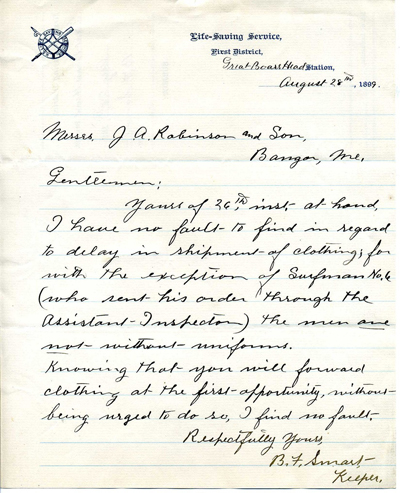
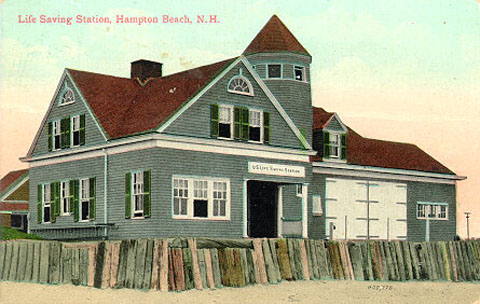 (postcard
view not included) (postcard
view not included)
1234k. U.S.
Life-Saving Service, First District, Great Boars Head Life-Saving Station,
Hampton, NH. c.1899. 1p. B.F. Smart, Keeper. Original hand-written
letter from Keeper Smart to James A. Robinson & Son (clothiers), of Bangor,
Maine, regarding delay in shipment of order for surfman’s uniforms. Text
reads: “Gentlemen: Yours of 26th. Inst. At hand, I have no fault to find in
regard to delay in shipment of clothing; for with exception of Surfman No. 6
(who sent his order through the Assistant Inspector) the men are not without
uniforms. Knowing that you will forward clothing at the first opportunity,
without being urged to do so, I find no fault. Respectfully yours, B.F. Smart,
Keeper.” 8” x 10” on official Life-Saving Service stationery. Dated August
28th., 1899. Rare First District document in overall clean, crisp
condition. (VG+). $94.
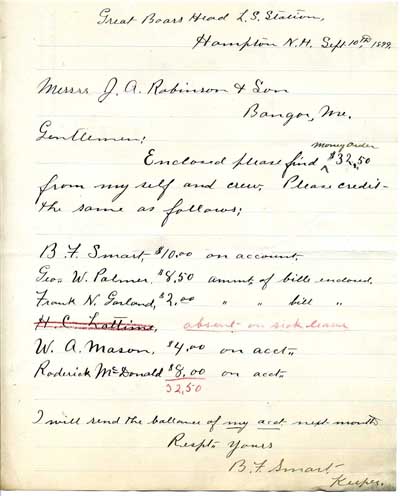
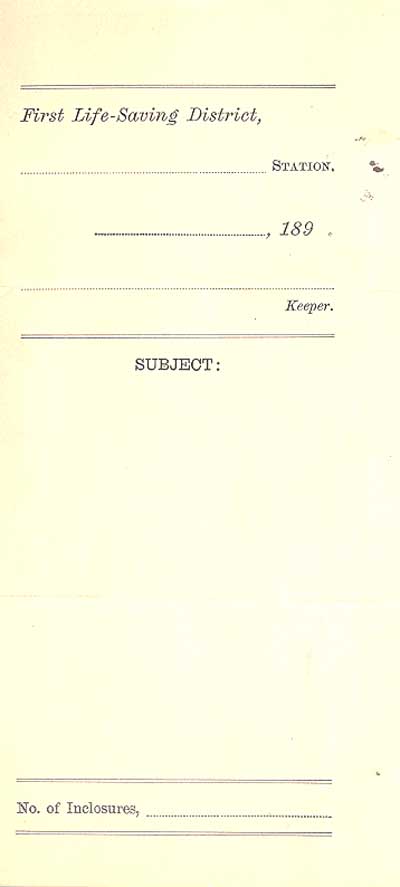
1234L. U.S.
Life-Saving Service, First District, Great Boars Head Life-Saving Station,
Hampton, NH. c.1899. 1p. B.F. Smart, Keeper. Original hand-written
letter from Keeper Smart to James A. Robinson & Son (clothiers), of Bangor,
Maine, regarding delay in shipment of order for surfman’s uniforms. Text
reads: “Gentlemen: Yours of 26th. Inst. At hand, I have no fault to find in
regard to payment for a shipment of clothing. Letter reads: “Gentlemen:
Enclosed please find money order $32.50 from myself and crew. Please credit the
same as follows: [Keeper] B.F. Smart $10 on account, Geo. W. Palmer $8.50 amount
of bills enclosed, Frank N. Garland $2 amount of bill enclosed, H.C. Lattime
absent on sick leave, W.A. Mason $4 on acct., Roderick McDonald $8 on acct. I
will send the balances of my acct. next month. Respectfully yours, B.F. Smart,
Keeper.” 8” x 10” on official Life-Saving Service stationery. Dated
September 10, 1899. Rare First District document in overall clean, crisp
condition. (VG+). $76.
Rye
Beach Life-Saving Station:
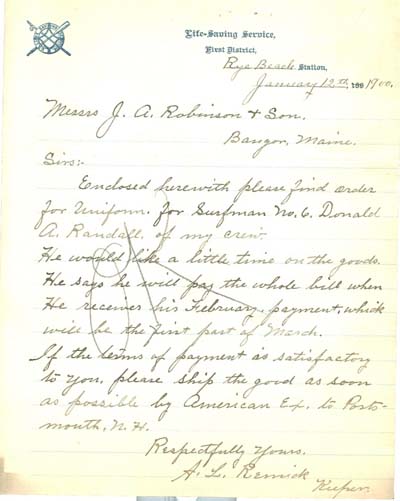
1234J. (document) U.S.
Life-Saving Service, First District, Rye Beach Station c.1900. A.L.
Remick, Keeper. Original hand-written letter from Keeper Remick to James A.
Robinson & Son (clothiers), of Bangor, Maine, regarding order for
surfman’s uniforms. Text reads: “Sirs; Enclosed herewith please find order
for uniform for Surfman No. 6 Donald A. Randall of my crew. He would like a
little time on the goods. He says he will pay the whole bill when he receives
his February payment which will be the first part of March. If the terms of
payment is satisfactory to you, please ship the good as soon as possible by
American Ex. To Portsmouth, N.H. Respectfully Yours, A.L. Remick Keeper.” 8”
x 8 ½” on official Life-Saving Service stationery. Dated January 12, 1900.
Rare First District document in overall clean, crisp condition. (VG+).
$124.
 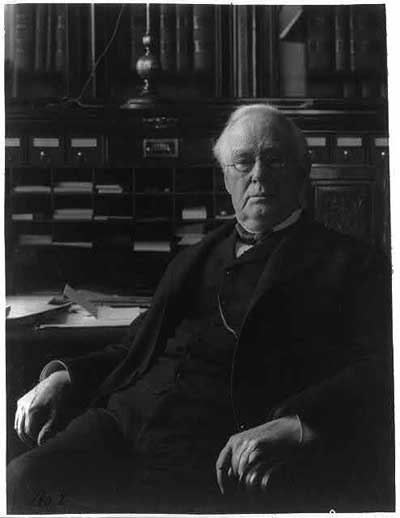 (photo not included)
(photo not included)
12177. (document) George
Frisbie Hoar, Senate of the United States re. Life Saving Service. c. 1893.
Rare document is on United States Senate stationery, dated September 16, 1893
and is signed in hand by Senator Hoar. Letter is addressed to Solomon R. Hawes,
Esq., Wellfleet, Mass., who apparently wrote to Hoar discussing the importance
of the work of the Life-Saving Service and the need for proper compensation for
the men. The letter reads “My dear Sir: You can say nothing that will seem to
me exaggerated in regard to the importance of the Life Saving Service, or the
title of the brave men who belong to it to public gratitude and to full and
generous compensation. I shall do all that I can to carry out the principles so
well stated in your letter. I am faithfully yours, [signed] Geo F. Hoar.”
George F. Hoar (1826 – 1904) was a U.S. Representative (1869-1877) &
Senator (1877-1904) from Massachusetts. Hoar was long noted as a fighter against
political corruption, and campaigned for the rights of African Americans and
Native Americans. He argued in the Senate in favor of Women's suffrage as early
as 1886 and opposed the Chinese Exclusion Act, 1882. As a member of the
Congressional Electoral Commission, he was involved with settling the highly
disputed U.S. presidential election, 1876. He authored the Presidential
Succession Act of 1886. Letter is typed by a stenographer on official Senate
stationery and is signed in hand by Hoar. Rare and important document. Clean,
crisp, with original folds. (VG+). $145.
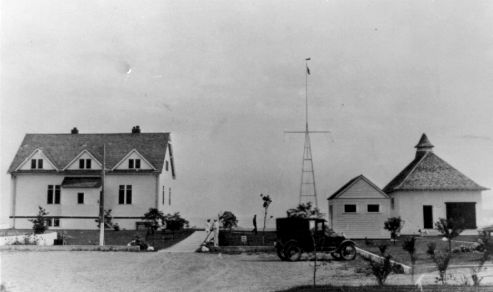
10257. Menz, Kahterine
B. Historic Furnishings
Report - Sleeping Bear Point Life-Saving Station:
Sleeping Bear Dunes National Lakeshore. Harpers Ferry, WV: Historic
Furnishings Branch, Harpers Ferry Center, National Park Service, 1983. 275p.
Thoroughly illustrated. Detailed report describes all property items issued to
and used at the Marquetts-style life-saving station boathouse and sleeping
quarters during the period 1901-1902. Report is extensively researched and
details all items issued to the station with a great deal of information about
each, and then presents an interpretive plan for the current museum with
recommended artifacts to properly convey the life and work of the life-savers.
Thoroughly documented with plans, illustrations and reports including a copy of
the complete Life-Saving Service, List of Articles of Outfit for the Sleeping
Bear Point Life-Saving Station, Twelfth District, June 24, 1901. Superb
information. (spiral bound photocopy $58).

1234i. (document) U.S.
Life-Saving Service, First District, Jerry’s Point Station c.1899.
A.A. Mayo, Keeper. Original hand-written letter from Keeper Mayo to James A.
Robinson & Son (clothiers), of Bangor, Maine, regarding order for Keeper’s
and surfman’s uniforms. Text reads: “Gentlemen. I respectfully inform you
that I have received clothing for myself and surfman of this station, and all
clothing is allrigfht excepting the vest for surfman T.H. Barber. That is too
small for him and I return it to you by the American Express this date for you
to make larger. The vest is allright as to length, but vest must be 39 inches
around the body over the chest and under the arms, and 40 inches around the
bottom of the vest. I will send you a check for the clothing soon. Very
Respectfully, A.A. Mayo Keeper.” 8” x 8 ½” on official Life-Saving
Service stationery. Rare First District document in overall clean, crisp
condition. (VG+). $124.
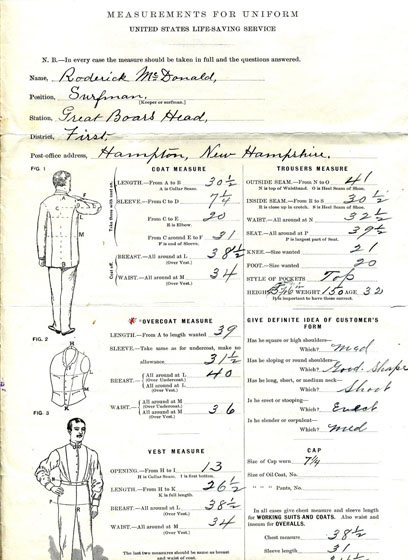
 (postcard
view not included) (postcard
view not included)
1258b. U.S.
Life-Saving Service. Order Form for Uniform Form No. 1852 c.1899. Great Boars
Head Life-Saving Station, Hampton, NH. 4p. 8 ½” x 14”. Four page
original form includes all necessary forms for ordering and paying for uniforms.
Includes listing of items ordered including Kersey coats, vests and trousers for
winter, flannel for summer, caps, overcoats, jumpers, storm suits, cap
ornaments, and buttons. Also includes page for measurements with diagrams,
invoice page and receipt. Filled out for Surfman Roderick MsDonald at Great
Boars Head Life-Saving Station, Hampton, NH. Form is filled out in hand by
Surfman McDonald and by Assistant District Inspector Lt. Worth G. Ross. Rare
early Life-Saving Service uniform information and form. Expected wear, light
soiling, original folds. (VG). $295.

12179. [photo] Merrimack
River Life-Saving Station, Plum Island, Newburyport, Massachusetts c.1900-1910.
Close photo provides a good view of the station with the boatroom doors open,
looking through. Photo itself is clear, a few marks and written message. Great
early detail, on postcard paper. 3 ½” x 5 ½”. (VG). $28.

12174. (photo) Klipsan
Beach Life Saving Station with Crew, Washington c.1910. Original
photo shows the life savers from the Klipsan Beach station (formerly Ilwaco
Beach station) posing on the lawn in front of the station. The station guarded a
sandy beach many miles long, a rarity on the rocky Pacific coast. The
Marquette-style station was built in 1891 on the southwest Washington coast, 13
miles north of Cape Disappointment. Crystal clear view, unusually clear, as nice
as they come. Great detail. Photo measures 3 ½” x 5” on postcard paper.
Rare image. (VG+). $76.
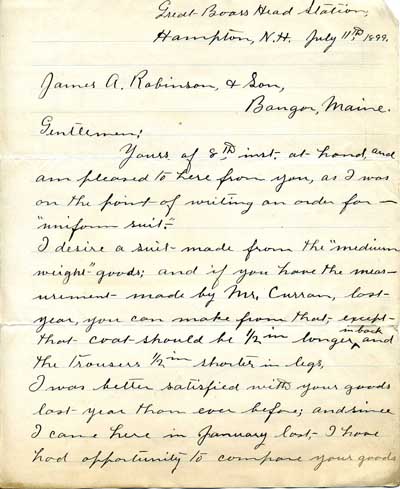
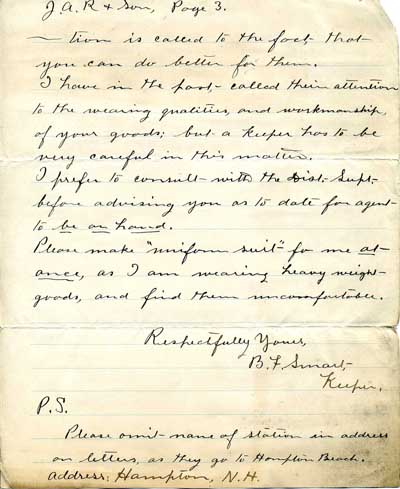 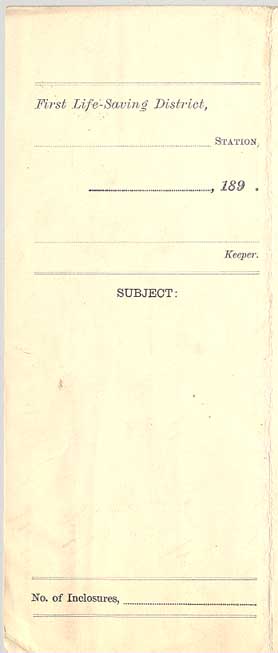
12132. (document) U.S.
Life-Saving Service, First District, Great Boar’s Head (Hampton Beach) Station
c.1899. B. F. Smart, Keeper. Original hand-written letter dated July
11, 1899, from Keeper Smart to James A. Robinson & Son (clothiers), of
Bangor, Maine, in which he orders a light weight officer's suit for himself and
discusses the quality of uniforms from other distributors in comparison to those
of Robinson & Son. Keeper Smart notes his satisfaction and that he will
recommend this clothier to his crew as well. Quite interesting insight. 3
sheets. 8” x 10” on official Life-Saving Service stationery. Rare First
District document in overall good condition, light soiling. Two original folds.
(VG). $144.
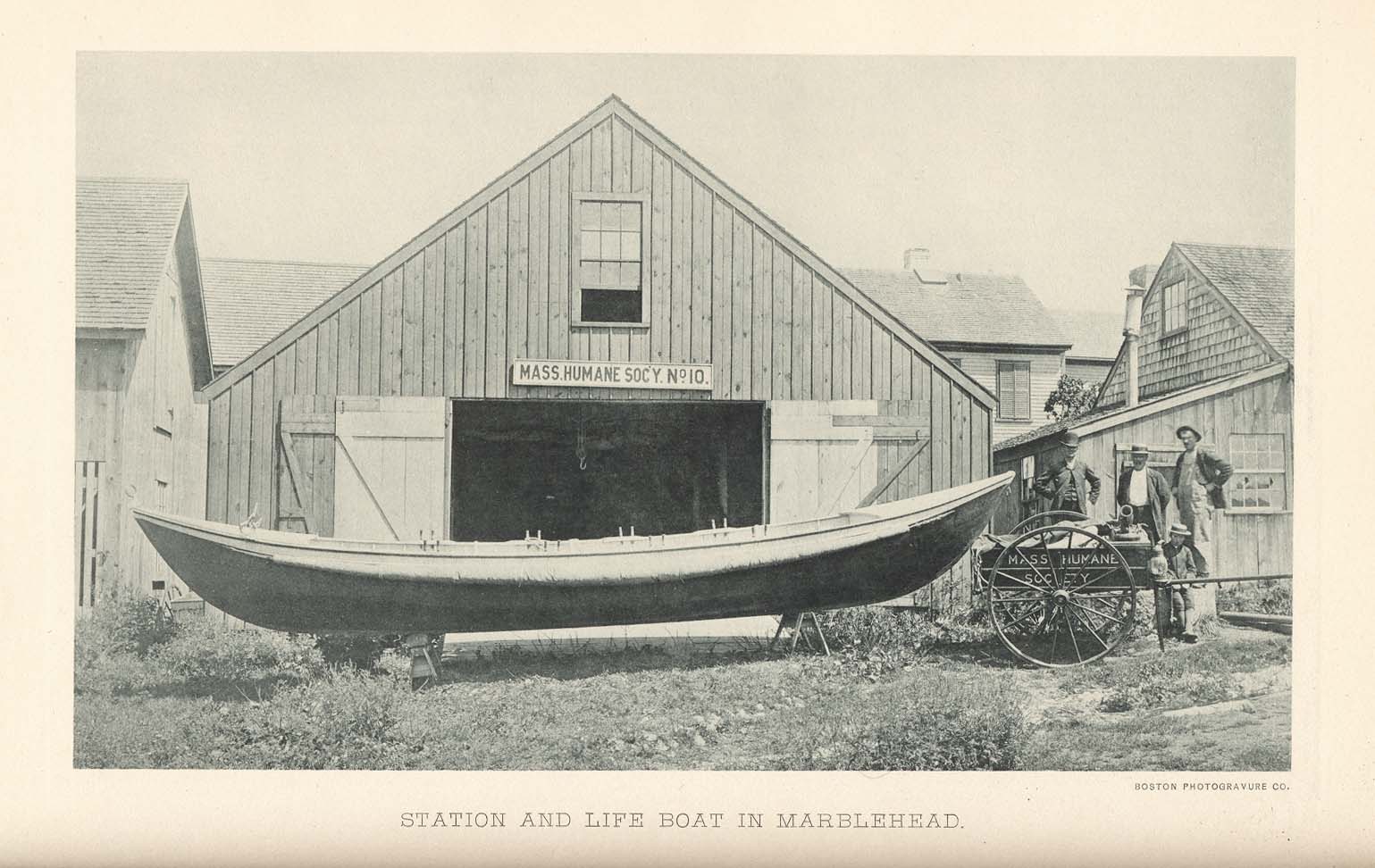
793d.
Bennett, Robert F. SURFBOATS, ROCKETS, AND CARRONADES.
GPO. 1976. 98p. Stiff wraps. Inscribed by the author. Written before the
resurgence of interest in the origins of the Life-Saving Service, Surfboats,
Rockets, And Carronades traces the little known origins, successes and
failures of the earliest federal efforts in lifesaving along the coasts. During
the years from 1848 through 1870 volunteer efforts of private citizens saved
countless thousands of lives from shipwreck. To help them, they had only native
experience, abundant courage, and some token federal assistance in the form of
… SURFBOATS, ROCKETS, AND CARRONADES. This is the story of these first rescue
stations and of the later establishment of the Life-Saving Service. Extremely
difficult to find. Contents clean, tight, light soiling to wraps, light foxing
to end papers. (VG). $88.
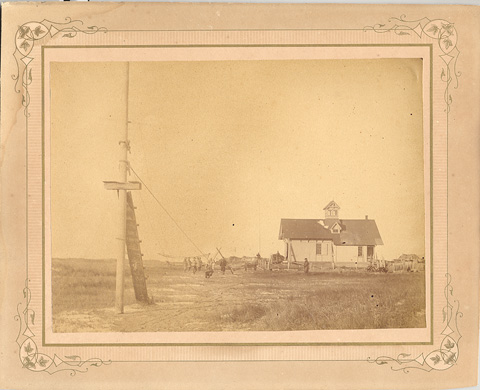 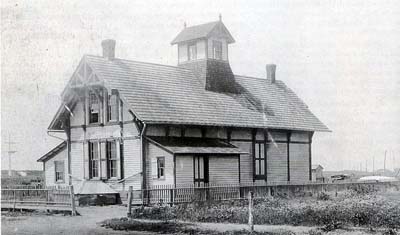 (later view Mecox LSS)
(later view Mecox LSS)
858. (mounted photo) U.S.
Life-Saving Station (possibly Mecox, NY) c.1878. Clear close view of
this 1875-Type station as the crew drills with the breeches buoy apparatus to
the drill pole in the foreground. Regarding the identification of this station,
Wick York, co-author with Ralph Shanks of “The U.S. Life-Saving Service”,
notes: “I think (but I'm not certain) that this is an 1875-Type and that it
could be the 1877 Mecox, NY station on Long Island that's on page 78 in our
book. However in the book photo (and in all other photos of the station I've
seen) the roof of the side lean to intersects the sidewall of the main part of
the station below the eave of the main roof. In your photo the lean to's roof is
an extension of the main roof. I've also never seen any photos of the station
with a gable roof dormer like the one in your photo, although I have seen photos
of the station with a shed roof dormer. And the station has two chimneys in the
book photo while it has only one in your photo. I've seen photos of most but not
every 1875 Type station and the Mecox station is the only one I've seen with an
1882 type tower like this one. It's very possible the Mecox station only had one
chimney at some point but I find the lean to roof more difficult to explain.”
This is a superb early view, one of the few that I have found of this vintage.
Probably taken shortly after the station was constructed. Photo image measures 5
½” x 8” on original 8” x 10” mount. Beautiful original piece. Overall
clean, very good condition, only light moisture to margins of mount, foxing to
back. (VG). $285.
(lot) Damariscove
Life Saving Station c.1900. Includes photos, documents, etc.

1269. [mounted photograph] c.1900.
Original portrait photograph, of a U.S. Life-Saving
Service Surfman, from the Damariscove Life-Saving Station, Maine c.1900.
This rare posed portrait photograph shows the handsome surfman proudly posing in
his 4-button single-breasted uniform coat. Clearly visible is his uniform cap
with “U. S. Life Saving Service”, and life ring and “U.S.L.S.S.” on the
right sleeve. Clearly visible too is his surfman No. 7” on his left sleeve.
The view measures 4” x 5 ½” on original 6” x 9” mount. Mount is labeled
“Holmes [photographer] Bath, ME”. Photo is clear, and crisp, one of the
better images we have had in some time. Light soiling to mount. It is
exceptionally rare to see such photos of surfmen in any format. From a private
collection lot of Damariscota Life-Saving Service items. (VG+). $345.
2245.
Griffin
, Carl R. III AND Alaric Faulkner. COMING OF AGE ON
DAMARISCOVE ISLAND
,
MAINE
. Orono. 1981. 116 p. Soft wraps. A wonderful chronicle of growing up and of
life on
Maine
’s
Damariscove
Island
. Includes a most interesting chapter on the Coast Guard [Life-Saving] station
on the island, their work and details about the men stationed there at the time.
Wonderful coastal
Maine
reading. (VG). $26.
Lot four (4) Damariscove
Life Saving Station items $685 (savings of $68).

27431c. Civilian
line gun projectile. $685 (1 available) .Reduced $435 each.
North
Scituate Life Saving Station c.1890-1910

25363.
One of the
finest original views that we have ever had. Original cabinet view,
a full 10” x 12” and with gilded edges show superb detail in an
unprecedented format. Station is the North Scituate Bibb #2-Type station,
built in 1887 and located near Minot, Mass. Clearly the largest and finest
view that we have yet seen.
Exterior view with crew posing on the boat ramp. $375. Reduced $285.

8426b,c,d.
[glass slide] Some Operations of the Life-Saving Corps,
Jamestown
Exposition. #14219. c.1907 by Keystone View Company. Beautiful b/w
glass projection slide featuring the Life-Saving Service performing breeches
buoy drill at the Jamestown Exposition. The crew of six are in the foreground
pulling a seventh member from an offshore vessel. The pinstriped wheels of the
beach apparatus cart are just visible in the foreground. Slide measures 3 ¼”
x 4” and presents a superb, clear image. Includes original printed
description. (F). $32. Reduced $24.

11155.
Carlson, Commander Arnold E. USCG. Captain Joshua James
-- Lifesaver Nonpareil. United States Naval Institute Proceedings.
August 1959. 7p. Joshua James (1826-1902) is to this day still acknowledged to
the most distinguished seafaring lifesaver in te United States. Capt. James
served in the lifeboats of the Massachusetts Humane Society from 1842 and later
as Keeper of the Point Allerton Life-Saving Service station at
Stoney
Beach
until his death in 1902. According to Sumner I. Kimball, General Superintendent
of the Life-Saving Service, "Joshua James was probably the best-known
life-saver in the world….his sixty years of rescue work gave him a longer term
of service and a more diversified experience in battling with the sea than any
of his contemporaries. In this regard he might be called the greatest among
them." Some of his sixty years of rescues and the medals that he and
his crews earned are chronicled in this scarce work. Includes photographs. Full
issue - this 164 page magazine also contains comment and discusion, book
reviews, professional notes, USNI publications in 1959 and other interesting
items including a lengthy article on the San Francisco Maritime Museum,
advertisements carried which show various items purchased and used by the Navy,
and more. Clean, tight. (VG). $24.
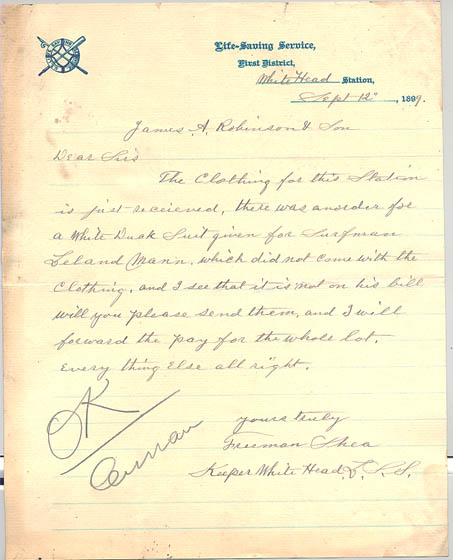
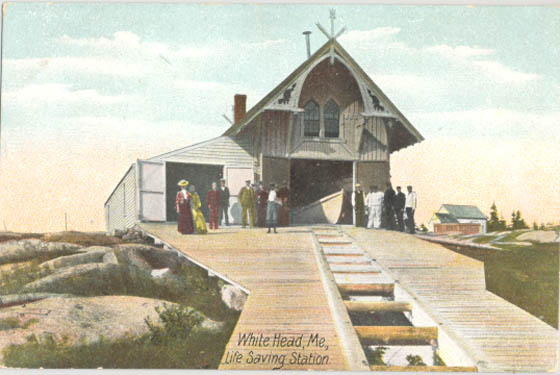
1234c. (document) U.S.
Life-Saving Service, First District, White Head Station. September 12, 1899.
Freeman Shea, Keeper. Original hand-written letter from Keeper Shea to James A.
Robinson & Son (clothiers), of Bangor, Maine, regarding uniforms received at
the station. Text reads: “Dear Sirs, The clothing for this station is just
received. There was an order for a white-duck suit given for Surfman Leland
Mann, which did not come with the clothing, and I see that it is not on his
bill. Will you please send them, and I will forward the pay for the whole lot.
Everything else is all right. Yours truly, Freeman Shea, Keeper White Head L.S.S.”
8” x 10” on official Life-Saving Service stationery. Rare First District
document in overall clean, crisp condition. Light soil, toning. (VG+). $134. (postcard view not included)
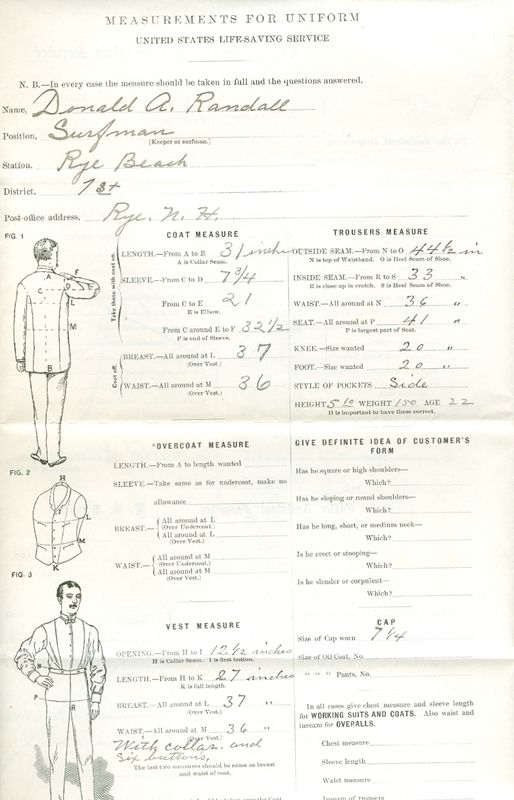
1258. (copy) United
States Life-Saving Service. Order for Uniform. Form No. 1852. c.1895.
4p. 8 ½” x 14”. Four page copy of form includes all necessary forms for ordering
and paying for uniforms. Includes listing of items ordered including Kersey
coats, vests and trousers for winter, flannel for summer, caps, overcoats,
jumpers, storm suits, cap ornaments, and buttons. Also includes page for
measurements with diagrams, invoice page and receipt. Filled out for Surfman
Donald Randall, Rye Beach Station, NH. Rare early Life-Saving Service uniform
information. (photocopy $4).
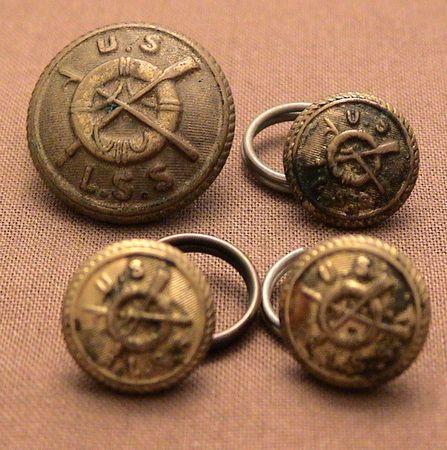

U.S. Life-Saving
Service, Light-House Establishment & Lighthouse Service buttons available
- all designs. Please inquire.
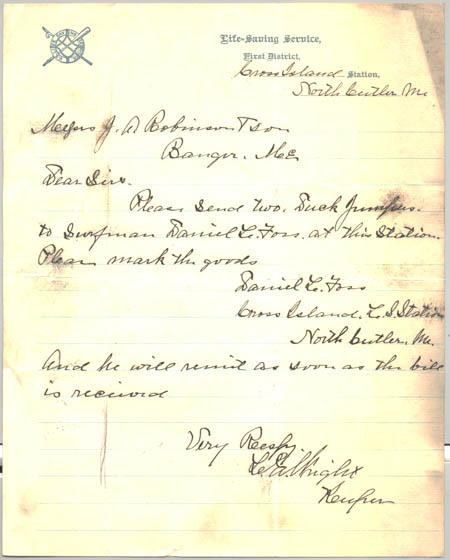

1234b. (document) U.S.
Life-Saving Service, First District, Cross Island Station c.1899.
Lyman E. Wright, Keeper. Original hand-written letter from Keeper Wright to
James A. Robinson & Son (clothiers), of Bangor, Maine, regarding uniform
measurements for Surfman Daniel L. Foss. Text reads: “Dear Sirs. Please send
two Duck Jumpers to Surfman Daniel L. Foss at this station. Please mark the
goods: Daniel L. Foss, Cross Island L.S. Station, North Cutler, Me. And he will
remit as soon as the bill is received. Very Resply., L.E. Wright, Keeper.”
8” x 10” on official Life-Saving Service stationery. Rare First District
document in overall clean, crisp condition. A few soiled areas. (VG). $134. (postcard
view not included)
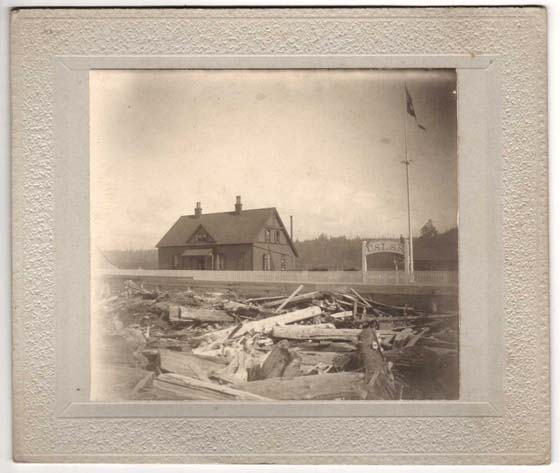
1209. (mounted photo) U.S.
Life Saving Station, Yaquina Bay, Newport, Oregon c.1895. Rare
mounted image of the Marquette-style station built in 1895. In the foreground
can be seen the unusual “U.S.L.S.S. Yaquina Bay” sign, next to the flag pole
flying the Life-Saving Service pennant. Image is clear and clean and measures
4” x 4 ¼” on 5 ¼” x 6 ¼” decorated mount. Probably taken shortly
after the station was completed in 1895. (VG+). $88.
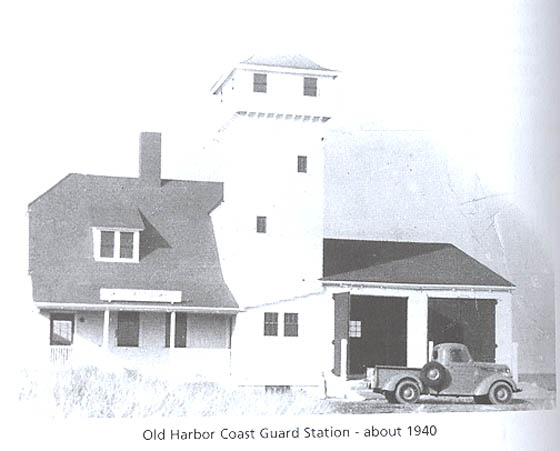
11444.
Old Harbor Life-Saving Station - Historic Structure
Report. 1988. 348p. Boston, Mass.
Historic Architecture Program, Northeast Region, National Park Service, U.S.
Dept. of Interior, National Park Service. Soft wraps. Historic Structure Reports
provide a valuable foundation for the rehabilitation, restoration, stabilization
or reconstruction of historic structures. Such a report is particularly
important for finding or fabricating significant missing architectural details
and other items that would have been found on such structures, and for
documenting the history and changes to such structures over time. This allows
one to recapture the appearance of a property at one particular period of its
history, removing later additions, or substantially modifying existing historic
fabric. In this case, the Old Harbor Cove Life-Saving Station
(Chatham/Provincetown, Cape Cod) was studied using evidence present at the site,
historical documents found at the National Archives, Life-Saving Service
records, logs, reports, letters from the keepers and more. Using these and other
sources, the author is able to provide a detailed assessment of how the
structure would have looked during the period of interest, and more. The report
includes a number of period photos and diagrams, architectural plans, and
excerpts from Life-Saving Service books and documents for guidance. A most
important reference for anyone interested in what the station building(s) would
have contained and looked like. (M). $78.
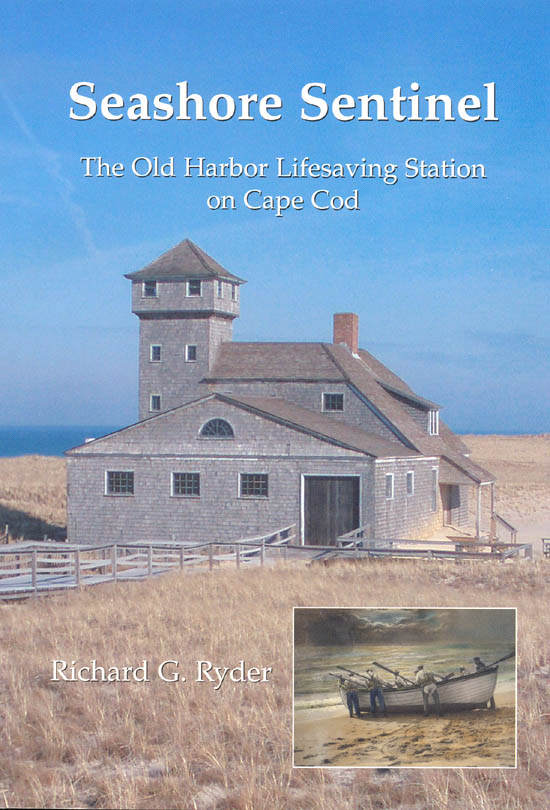
29313.
Ryder, Richard G. Seashore Sentinel: The Old Harbor
Lifesaving Station on Cape Cod. West Barnstable. 2009. 120p. Soft
wraps. This latest account of the history and life at Cape Cod’s Old Harbor
Life-Saving Station updates his older work -
OLD
HARBOR
STATION
CAPE
COD – now long out of print but still in demand. This extremely worthwhile
account of the life-savers at the Old Harbor Life Saving Station in
Chatham
, Mass., is a one of a kind, chronicling not only much of the wrecks and work of
the life savers, but particularly looking at the equipment issued to such a
station at the time and the lives of the men living and working there. Includes
many photographs, wreck accounts, life at the station, moving the station and
much more. A most interesting chronicle. (M). $12.95.
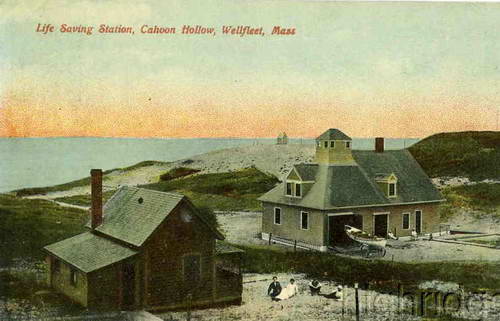 (postcard
view not included) (postcard
view not included)
479.
(document) H. R. Ex. Doc. No. 244. RE-IMBURSEMENT OF
CREW OF CAHOONS [Hollow] LIFE-SAVING STATION (
Cape Cod
).
January 23, 1895
. 10pp. Seeks to reimburse the crew for personal losses ($968.49) sustained in
the recent burning of the station (February 25, 1893). Includes listings of each
surfman’s items lost in the fire, etc. Disbound, clean. $44.
 (image
courtesy Bangor Public Library) (image
courtesy Bangor Public Library)
5397. (newspaper) A
WINTER GALE – Wrecks and Loss of Life Along The Coast. The Boston
Daily Advertiser. January 11, 1886. Lengthy detailed article describes in great
detail the recent gale resulting in scores of lives and ships lost along the New
England coast. Includes detailed accounts of a number of wrecks, rescues by the
Life-Saving Service, an account of the tremendous efforts aboard the steamer
Katahdin to save the vessel and its passengers, and more. Most interesting with
rare information and detailed accounts of incidents. Page has been encased in
plastic for protection. $26. (photo not included)
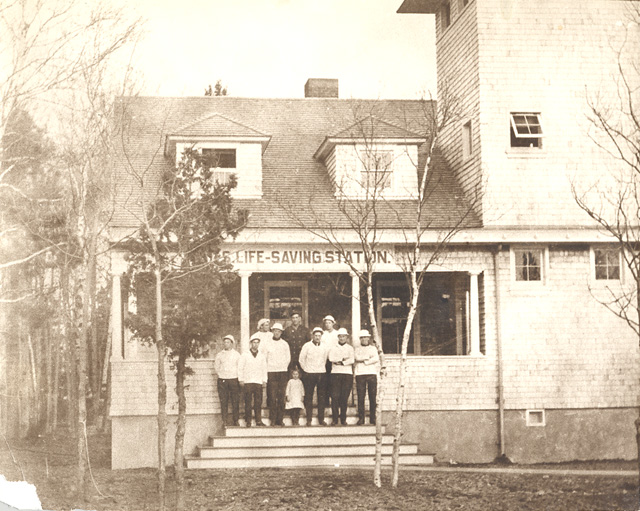
11285.
(copy photo) U.S.
Life Saving Station, Eagle Harbor, Michigan. Great early view, some
wear, one torn corner. 8” x 10”. (G+). $8.
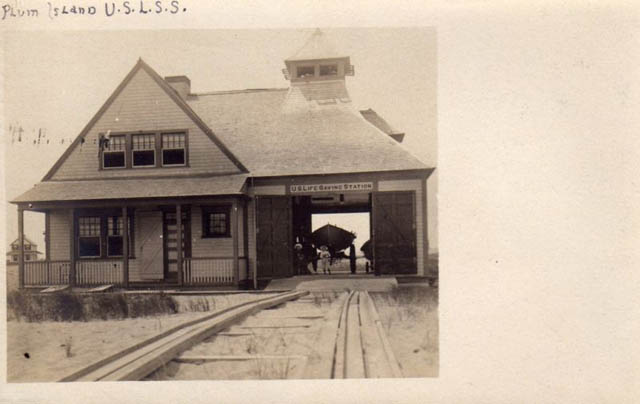
11359. [photo] Merrimack
River Life-Saving Station, Plum Island, Newburyport, Massachusetts c.1900-1910.
Fine photo provides an unusually clear, crisp views of the station with the
boatroom doors open, looking through. Photo itself is exceptionally clear and
crisp, a few marks. Great early detail, on postcard paper. 3 ½” x 5 ½”.
(VG+). $42.
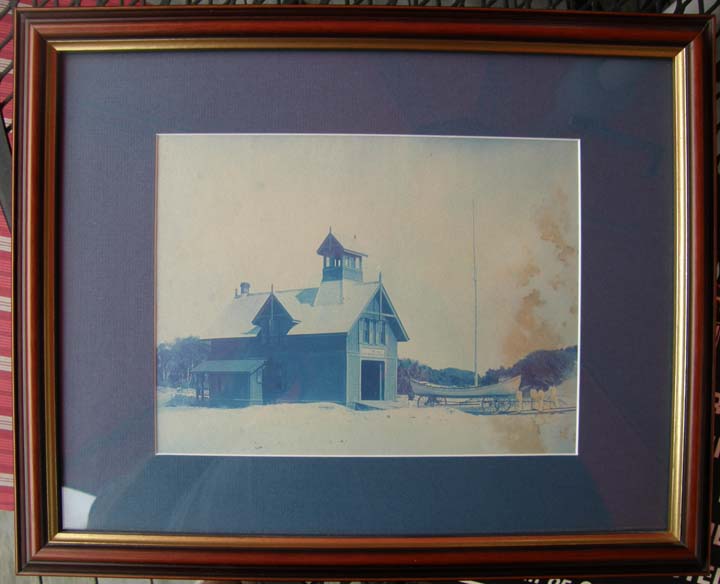
HB-142b. (framed photo) Morris
Island Life-Saving Station, South Carolina c.1893. 8” x 10” framed to 13” x
16”. The Morris Island Life Saving station was constructed in 1885 near Morris
Island (Charleston) Lighthouse. The station was an 1882-type station, almost
identical to the Cape Lookout station. This photograph was taken in March of
1893 when the station was only eight years old. View is a wonderful, clear,
crisp view of the station from the front left side. This close view clearly
shows the entire building. On the boatramp is the surfboat on its carriage with
the Keeper and four surfmen posing for the camera. Light moisture surrounds the
surfmen at the bow, detracting only slightly from an otherwise stunning photo.
Good contrast and crisp details make this photo a most desirable view. This
image is one of only two printed, from the files of U.S. Lighthouse Engineer
Herbert Bamber, who designed and supervised the construction of lighthouses
across the country in the 1880-1920 period. Image is a cyanotype, blue on white,
a process which lent itself to being printed in the field, and one that was able
to capture exquisite detail. Photo has been beautifully matted and
professionally framed. (VG+). $295.
312e. Lamb, Martha J., "THE AMERICAN LIFE
SAVING SERVICE", 17pp., February 1882. (from Harper’s Monthly) 6" x
9 1/2". With 15 excellent engravings; Patrolmen exchanging checks-Sumner I.
Kimball-Lifeboat Station on Lake Michigan-Self-righting Life-Boat-United States
Life-saving Station on the Eastern Coast-Nag’s Head, Scene of the
"Huron" disaster-Wreck of the "Huron"-"They found him
nearly dead"-Surfman’s Shield-Wreck of the Schooner "Hartzel in Lake
Michigan-Life-saving Car-Life-saving Station on the North Carolina Beach-First
Ball, Ship "Ayrshire"-The Lyle Gun-Life-saving Medals. Describes the
history and the work of the life-savers, their equipment and the rescues. Full
issue, some expected wear and chipping, clean. (G). $24.
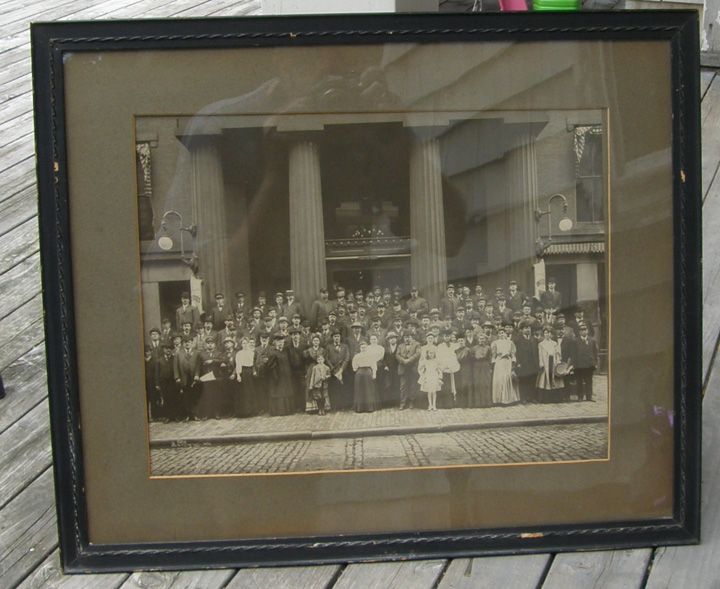
11206d. (original framed
photograph.) U.S. Surfmen on steps, probably at meeting
of the U. S. Life-Saving Service Surfman’s Mutual Benefit Association on Long
Island or in Washington c.1900. Found in Long Island Coast
Guardsman’s estate. The Surfman’s Mutual Benefit Association was instituted
in the later 1800’s to provide an organization to which the surfman could
belong to provide comradeship as well as promote their common interests. Through
their efforts retirement and death benefits were later instituted for the men
and other benefits lobbied for. The organization held annual meetings and
published a monthly journal entitled Along the Coast. Original large matted
photo measures 20” x 24” overall, in original wood frame. Clear, crisp, rare
Life Saving Service view. (VG+). $165. Reduced $110.
20347. [newspaper] THE LIFE-SAVING SERVICE.
The Daily Graphic. August 17, 1875. Lengthy 1 column article describes the
history and organization of the Service, location and organization of the
stations, equipment and systems employed for the rescue of shipwrecked mariners.
This early piece is quite interesting as it predates the annual reports and
provides a look into the organization during its earliest years. One large full
sheet, also with some with articles of the day, light browning, moderate wear.
(G).$68.
97197xx8. [newspaper] THE LIFE-SAVING SERVICE.
Portland Transcript. September 21, 1872. Lengthy ¼-page article details a
bit of the early history of the service, with a great deal on the present
state of recent appropriations and work in progress to upgrade the
operations along the coasts. Additional information is presented regarding
the equipment and methods currently in use. Most interesting with a great
deal of information. Full issue with additional articles of the day, light
browning, original folds. (VG). $32
9155. O’Connor, William D.[Assistant Superintendent of the United
States Life-Saving Service.] THE UNITED STATES
LIFE-SAVING SERVICE. [disbound] from an early Appleton’s
Annual Cyclopaedia Vol. III, c.1878. 19 p. As Assistant Superintendent of
the Life-Saving Service, the author relates tales of the equipment, the
work and of the men of the Service as few can. His intimate knowledge and
access to official sources allow him to relate the stories of these
dramatic rescues as never before. Well illustrated. $18.

11206b. (framed photograph.) U.S.
Surfmen on steps of Treasury Building, probably at meeting of the U. S.
Life-Saving Service Surfman’s Mutual Benefit Association c.1900. The
Surfman’s Mutual Benefit Association was instituted in the later 1800’s to
provide an organization to which the surfman could belong to provide comradeship
as well as promote their common interests. Through their efforts retirement and
death benefits were later instituted for the men and other benefits lobbied for.
The organization held annual meetings and published a monthly journal entitled
Along the Coast. Original matted photo measures 8 x 10, in original wood frame.
Clear, crisp, light foxing, but with one crease down center. Still presents
well, however. Rare Life Saving Service view. (G). $84.
2026c. Spears, John R., TALES
OF THE MUSH-ICE-HEROES. Harper’s Weekly. March 2, 1901. 2p.
Great 2-page tale of the
Great Lakes
life-savers as they braved to get across the “mush-ice” to perform
their rescues. Mush-ice is always found along the shore as the season of
lake navigation draws to a close. Though it thickens and clots, it does
not harden and thus poses serious difficulties to the life-savers in
making their way across it with their equipment to reach a wreck. A number
of tales are told from the annuals of the Life-Saving Service reports,
including the efforts of the
Marquette
,
Michigan
crews during the great of November 1886. Includes a number of other tales
including the wreck of the City of Duluth near
St. Joseph
, the schooner J. H. Hartzell south of
Frankfort
, and more. Includes six nice engraved illustrations. Full issue. (VG).
$38.
7197LL.
[newspaper] LIFE BOATS FOR THE COASTLINE.
Yankee Farmer. January 21, 1837. Short article notes the need for establishing a
line of life boats along the coast in the vicinity of New York City. It is also
suggested that a “howitzer be placed at the stations, and that such equipment
properly placed might have saved the individuals who perished in recent deaths.
Full newspaper contains four large pages with articles of the day, clean, two
folds. (VG-). $18.
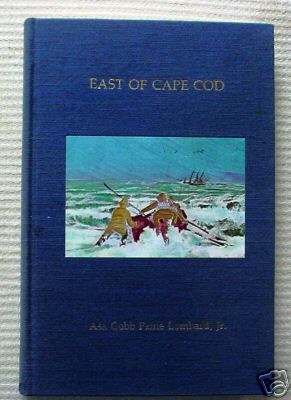 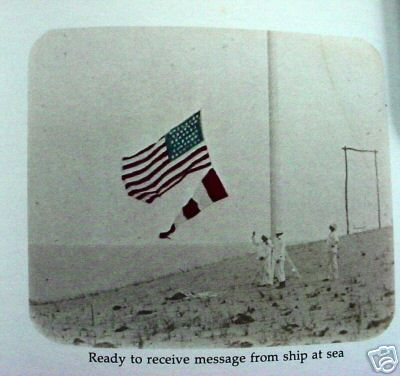
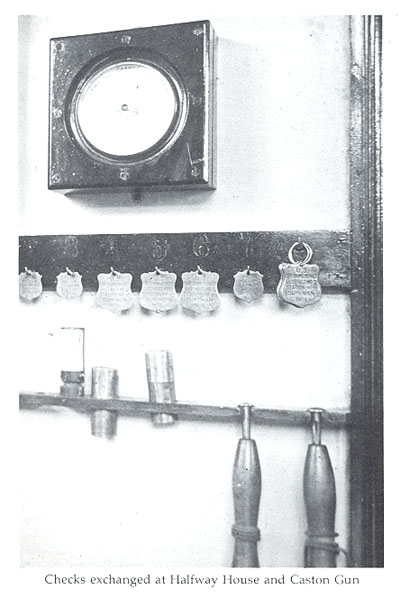

5461.
Lombard, Asa Cobb Paine. EAST OF CAPE COD
. Cuttyhunk. 1976. 157 pp. The author tells the
stories of ships and shipwrecks and particularly of the Life-Savers of
this dangerous area. The author incorporated into this account numerous
photographs and records of his grandfather, United States Life-Saving
Service Warrant Officer [1885-1921] Edward Everett Lombard who was
stationed at the Cahoon’s Hollow station. Extremely well
illustrated with over 80 wonderful early photographs, one of the better
accounts of the Life-Saving Service. The glass slides from which the
pictures are reproduced were made from 1885 to 1900. Lombard, along with
his Cahoon’s Hollow companion, Eugene Young, gave lectures at the time
in the eastern part of Massachusetts
describing the wrecks that occurred on Cape Cod from Monomoy to Provincetown
, explaining how rescue attempts were made, and the operations of the
United States Life Saving Service. The proceeds from the lectures were
used to buy Station personnel the necessary extras needed to perform their
duties — equipment not provided by the government. Chapters include the
Wreck of the Jason, History of the Life-Saving Service, the Lifesaver’s
Tools, Lifeboat Drill, Communications, Smuggler, Restoring the Apparently
Drowned, Shipwrecks, the Way of the Wreckers, and more. Becoming scarce,
this has always been one of the two best on Cape Cod
’s life-savers but so far has not received proper recognition. Clean,
tight, light sunning to wraps. (VG+). $48 net.

2704. Davis, Rebecca Harding. LIFE
SAVING STATIONS- History, Anecdotes, and Famous Shipwrecks, Etc. Reprint
from Lippincott's Magazine (Mar. 1876): pp. 301-310. This article by Rebecca
Harding Davis, originally appearing in Lippincott's Magazine in 1876, presents
an interesting discussion of the history of life saving stations, surf boats,
and wrecking crews in the United States and particularly along the coast of Newe
Jersey. Written as an interview with several old-hands at a life saving station
on the Jersey Coast, includes anecdotes, discussion of the history of the
lifeboat service in Britain and the U.S., pilfering of wrecked ships, life
saving apparatus, etc. A scarce reference to early coastal lifesaving services
in the New Jersey and Long Island area, with mention of several shipwrecks. New,
staple bound card stock covers. Dimensions: 8.5x11 inches Page Count: 11. (M).
$9.95.
5200J-b.
Life-Saving Service. Report Of The General
Superintendent On The Transfer Of The Life-Saving Service To The Navy
Department. 1883. 5p. Original soft wraps. Quite a lengthy reply and
discussion by Superintendent Kimball of the recent bill proposed to reorganize
the Navy Department and transferring to it the duties and functions of the
Life-Saving Service. Includes a detailed discussion of the origins and functions
of the Life-Saving Service and in particular their duties, contrasting them with
the markedly different duties and skills of the Navy Department. Rare rebuttal
by the Superintendent himself, quite interesting reading. Wraps and contents
tight, intact, light soiling, some expected edge wear. (VG). $120.

793c.
Bennett, Robert F. SURFBOATS, ROCKETS, AND CARRONADES.
GPO. 1976. 98p. Stiff wraps. Inscribed by the author. Written before the
resurgence of interest in the origins of the Life-Saving Service, Surfboats,
Rockets, And Carronades traces the little known origins, successes and
failures of the earliest federal efforts in lifesaving along the coasts. During
the years from 1848 through 1870 volunteer efforts of private citizens saved
countless thousands of lives from shipwreck. To help them, they had only native
experience, abundant courage, and some token federal assistance in the form of
… SURFBOATS, ROCKETS, AND CARRONADES. This is the story of these first rescue
stations and of the later establishment of the Life-Saving Service. Extremely
difficult to find. (F). $118.
793d.
Bennett, Robert F. SURFBOATS, ROCKETS, AND CARRONADES.
GPO. 1976. 98p. Stiff wraps. Inscribed by the author. Written before the
resurgence of interest in the origins of the Life-Saving Service, Surfboats,
Rockets, And Carronades traces the little known origins, successes and
failures of the earliest federal efforts in lifesaving along the coasts. During
the years from 1848 through 1870 volunteer efforts of private citizens saved
countless thousands of lives from shipwreck. To help them, they had only native
experience, abundant courage, and some token federal assistance in the form of
… SURFBOATS, ROCKETS, AND CARRONADES. This is the story of these first rescue
stations and of the later establishment of the Life-Saving Service. Extremely
difficult to find. Contents clean, tight, light soiling to wraps, light foxing
to end papers. (VG). $88.
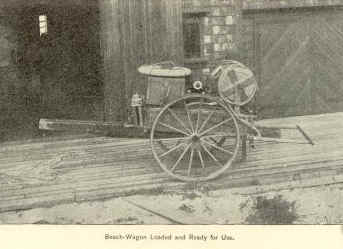
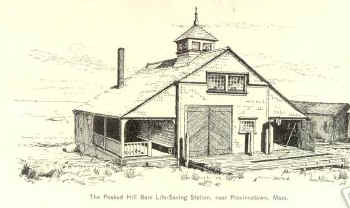
21458c,d.
Johnson, William Wallace. THE UNITED STATES
LIFE-SAVING SERVICE. New England
Magazine. April 1890. (disbound) pp. 134-145. Quite a nice article
detailing the history and work of the Life-Saving Service. Beginning in
the 1700’s with the Massachusetts Humane Society, the author discusses
the early years and into the 1880’s. Includes nine fine early engravings
and photo images including a fine image of Superintendent Sumner I.
Kimball, day signals, beach patrolman, beach apparatus cart, Peaked Hill
Bar station on Cape Cod
, and more - quite a good article. $28.
29248.
(newspaper) Life-Saving Service – Report of the Chief
of the Bureau – Two Hundred and Thirty Five Lives Imperiled, and Only One Lost
– An Extension of the Service Contemplated – The Storm Signal and
Life-Saving Stations Connected. New York Tribune. December 4, 1873.
Lengthy two column article details the progress made in the fledgling
Life-Saving Service with a look toward future improvements. Includes listing of
the current 81 stations, costs, plans for the future, English vs. American
life-saving methods, what has been accomplished in the two years they have been
operating on the coast, table of wrecks in the 1872-1873 period, and more.
Excellent early account of the early years of the service. Full newspaper
contains 8 large pages with interesting early articles of the day, only light
occasional foxing, unusually clean and crisp. (VG+). $74.
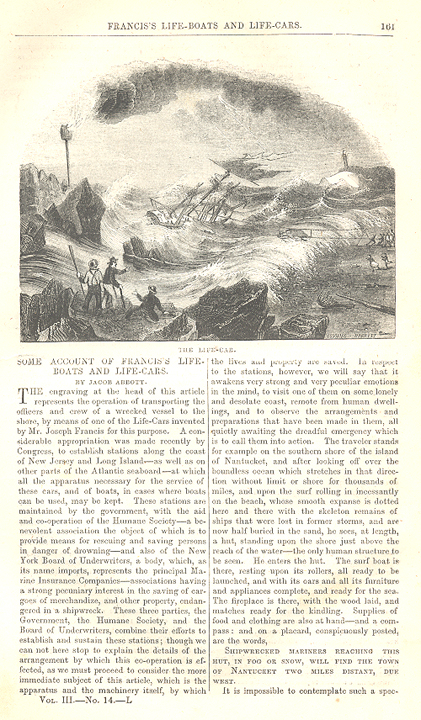
11175. Abbott, Jacob. SOME
ACCOUNTS OF FRANCIS’S LIFE-BOATS AND LIFE-CARS.
Harper’s New Monthly Magazine. 1851. 11p. With 8 detailed engravings of the
life-car and life-saving efforts including rescue scenes, manufacturing process,
firing the shot, surfboat to the rescue, and more. Fine early account of the
manufacture and use of Francis’ metallic life-car, which was later adopted by
the U. S. Life-Saving Service. Disbound. Clean, crisp. (VG+). $32.
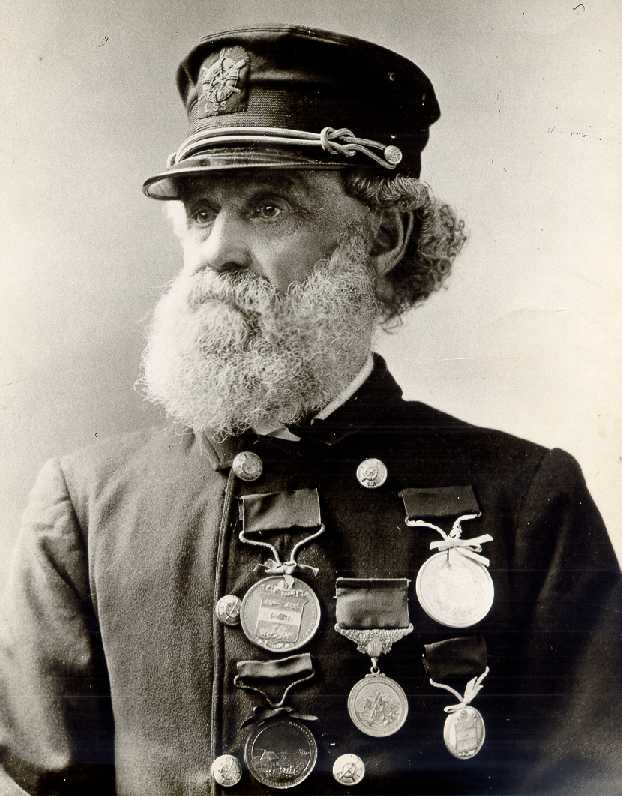
11155. Carlson, Commander Arnold E.
USCG. Captain Joshua James -- Lifesaver Nonpareil. United
States Naval Institute Proceedings. August 1959. 7p. Joshua James (1826-1902) is
to this day still acknowledged to the most distinguished seafaring lifesaver in
the United States. Capt. James served in the lifeboats of the Massachusetts
Humane Society from 1842 and later as Keeper of the Point Allerton Life-Saving
Service station at
Stoney
Beach
until his death in 1902. According to Sumner I. Kimball, General Superintendent
of the Life-Saving Service, "Joshua James was probably the best-known
life-saver in the world….his sixty years of rescue work gave him a longer term
of service and a more diversified experience in battling with the sea than any
of his contemporaries. In this regard he might be called the greatest among
them." Some of his sixty years of rescues and the medals that he and
his crews earned are chronicled in this scarce work. Includes photographs. Full
issue - this 164 page magazine also contains comment and discusion, book
reviews, professional notes, USNI publications in 1959 and other interesting
items including a lengthy article on the San Francisco Maritime Museum,
advertisements carried which show various items purchased and used by the Navy,
and more. Clean, tight. (VG). $24.
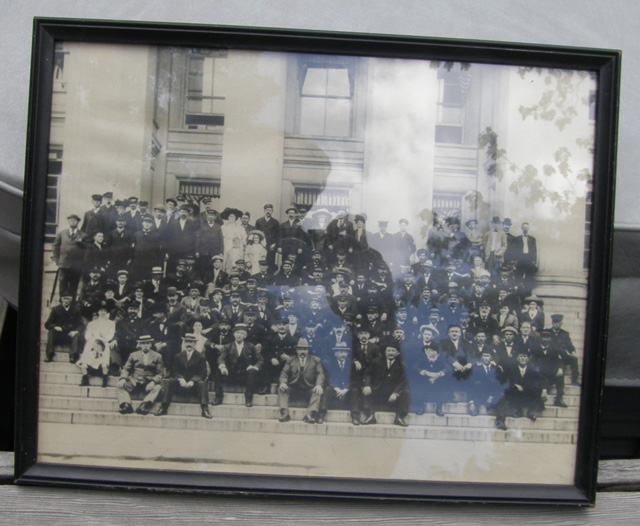
11206e. (framed photograph.) June 9,
1909. General Superintendent Sumner I Kimball,
Assistant Superintendent O.M. Maxim and U.S. Surfmen on steps of Treasury
Building, after shaking hands with President Taft in the White House.”
The Surfman’s Mutual Benefit Association was instituted in the later 1800’s
to provide an organization to which the surfman could belong to provide
comradeship as well as promote their common interests. Through their efforts
retirement and death benefits were later instituted for the men and other
benefits lobbied for. The organization held annual meetings and published a
monthly journal entitled Along the Coast. Photo may be original or may be copy
print. Framed photo measures 11” x 14” in original wood frame. Clear, close
view. Rare Life Saving Service view. (VG). $65.
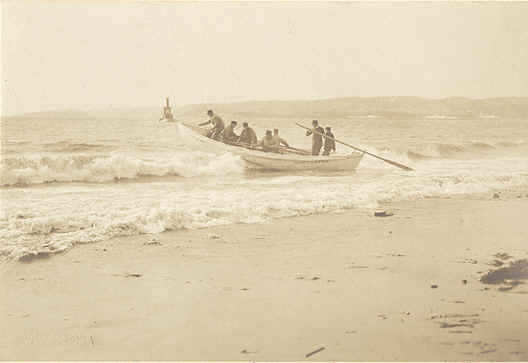 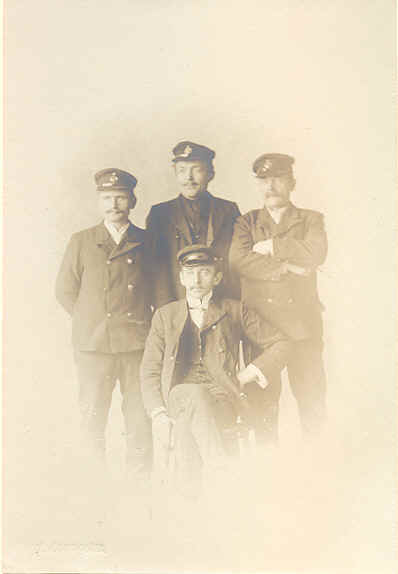
11195. (lot 3 mounted photos) Gloucester,
Massachusetts, Life Saving Crew Rescuing Crew of Sloop Urad c.1905. Rare
lot of three large mounted photos were taken by photographer H.W. Spooner of
Gloucester on January 7 & 8, 1905. Albumen images each measures 4 ½” x 6
½” on 10” x 12” mount. Each is fully identified on the back by the
photographer. The Annual Report for the Life-Saving Service from 1905 tells the
story best: “At 11:50 pm news by telephone reached the Gloucester Life Saving
station that a vessel was ashore on Pavilion Beach, 1 ½ miles NE of the
station, with her crew calling for help. The life-saving crew at once launched
the surfboat and went to her assistance. The vessel [the Norwegian sloop Urad
bound for New York City] had stranded on the rocks while entering the harbor.
The crew of four was taken off and landed safely on shore and cared for at an
hotel, while the life-savers carried out her anchor and 100 fathoms of cable and
hove her off the rocks, it being impossible to float her until high tide. On the
following day she was floated by a tug, the life-saving crew assisting with
their surfboat to run her lines.” The three views include: (1) the life-saving
crew launching their surfboat from the beach; (2) local crowd assembled at
Pavilion Beach watching the Urad as it is towed off the rocks; (3) the entire
crew of the Urad including Captain O. Brude. Images are clean and clear, very
light soiling to mounts. Rare Gloucester life-saving lot. (VG+). $225.
Lot
Photos Life-Saving Service Surfman, Narragansett Pier Life Saving Station,
Narragansett, Rhode Island
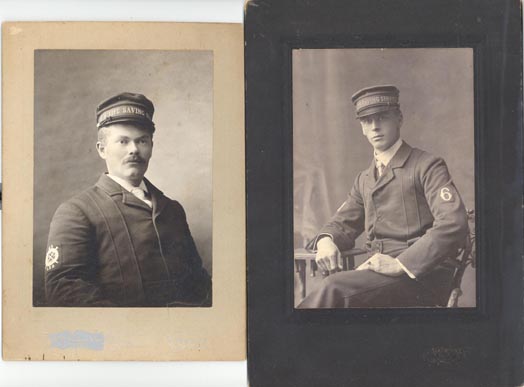
26107a.
[cabinet photograph] c.1900. Original portrait photograph, of a Life-Saving
Service Surfman, Narragansett Pier Life Saving Station, Narragansett, Rhode
Island. This rare posed portrait photograph shows the stout surfman proudly
posing in his 4-button single-breasted uniform coat. Clearly visible on his
right sleeve is the life ring with crossed oar and pike and the letters “US”
“LSS”, and his uniform cap with “U. S. Life Saving Service” clearly
visible on the band. The image measures 4” x 5 ½” on a 5 ¼” x 7”
original mat. Mat stamped H. W. Rankin & Co (photographer), Newport, RI.
Photo is clear, and crisp, only a few pinpoints of foxing, one of the
better images we have had in some time. It is exceptionally rare to see
such photos of surfmen in any format. (VG+). $245 net.
26107d.
[cabinet photograph] c.1900. Original portrait photograph, of a Life-Saving
Service Surfman, Narragansett Pier Life Saving Station, Narragansett, Rhode
Island. This rare posed portrait photograph shows the stout surfman proudly
posing in his 4-button single-breasted uniform coat. Clearly visible on his left
sleeve is his ranking number “6”, and his uniform cap with “U. S. Life
Saving Service” clearly visible on the band. The image measures 4” x 5 ½”
on a 6” x 8 ½” original mat. Mat stamped H. W. Rankin & Co
(photographer), Newport, RI. Photo is clear, and crisp, one of the better images
we have had in some time. It is exceptionally rare to see such photos of
surfmen in any format. (VG+). $245 net.
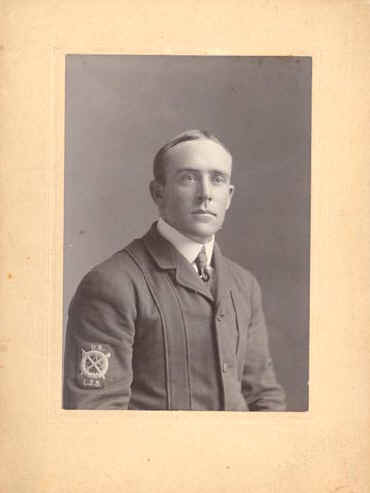
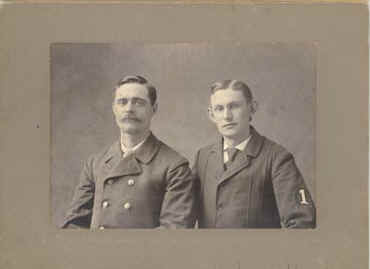
26107b.
[cabinet photograph] c.1900. Original portrait photograph, of a Life-Saving
Service Surfman, Narragansett Pier Life Saving Station, Narragansett, Rhode
Island. This rare posed portrait photograph shows the clean-cut surfman proudly
posing in his 4-button single-breasted uniform coat. Clearly visible on his
right sleeve is the life ring with crossed oar and pike and the letters “US”
“LSS”.The image measures 4” x 5 ½” on a 6” x 8” original mat. Mat
stamped W, H, Mowrey (photographer), Newport, RI. Photo is clear, and crisp,
one of the better images we have had in some time. It is exceptionally
rare to see such photos of surfmen in any format. (VG+). $245 net.
26107c.
[cabinet photograph] c.1900. Original portrait photograph, of two Life-Saving
Service Surfman, Narragansett Pier Life Saving Station, Narragansett, Rhode
Island. This rare posed portrait photograph shows two young surfman proudly
posing, one in his 4-button single-breasted uniform coat and the other in an
8-button double breasted type coat. Clearly visible on one surfman’s left
sleeve is his ranking number “1”. The image measures 4” x 5 ½” on a
6” x 8” original mat. Mat stamped H. W. Rankin & Co (photographer),
Newport, RI. Photo is clear, and crisp, one of the better images we have had in
some time. It is exceptionally rare to see such photos of surfmen in any
format. (VG+). $245 net.
26107e. [cabinet photograph] c.1900. Original portrait photograph, of a
Life-Saving Service Surfman, Narragansett Pier Life Saving Station,
Narragansett, Rhode Island. This rare posed portrait photograph shows the tall
surfman proudly posing standing on the beachin his 4-button single-breasted
uniform coat. Clearly visible on his right sleeve is the life ring with crossed
oar and pike and the letters “US” “LSS”, and his uniform cap with “U.
S. Life Saving Service” clearly visible on the band. The image measures 6” x
8” on a 7” x 9” original mat. Photo is clear, and crisp, but has
lost contrast over time. One of the larger posed images we have had in some
time. It is exceptionally rare to see such photos of surfmen in any
format. (VG-). $145 net.
26107f.
[photograph] c.1900. Original posed photograph of three Life-Saving Service
Surfman, Narragansett Pier Life Saving Station, Narragansett, Rhode Island. This
rare posed portrait photograph shows the three surfman proudly posing on a
nearby boulder. Visible on the men are some of their sleeve and hat markings.
The image measures 3 ½” x 5 ½” and is printed on photo paper. Photo
is clear, but slightly dark, somewhat poor contrast. It is exceptionally
rare to see such photos of surfmen in any format. (VG). $115
net.
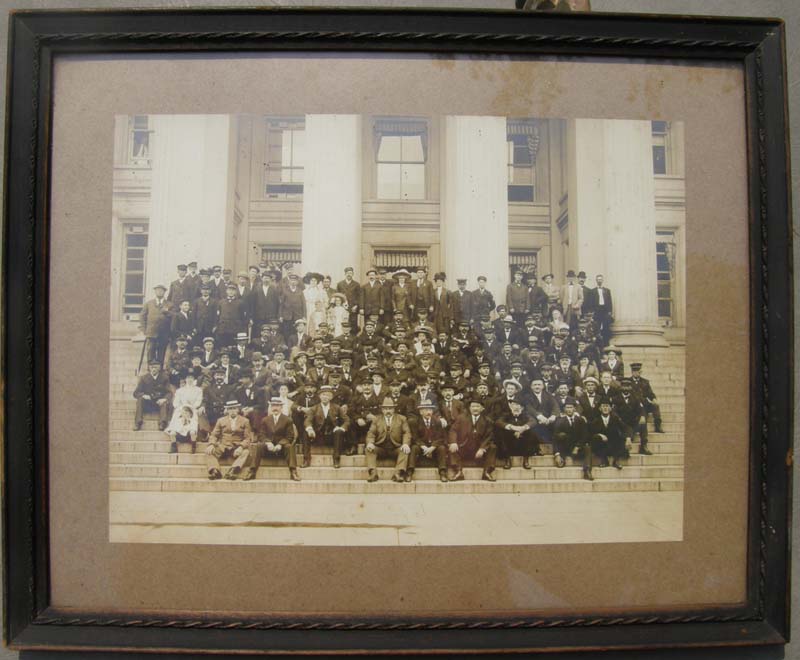
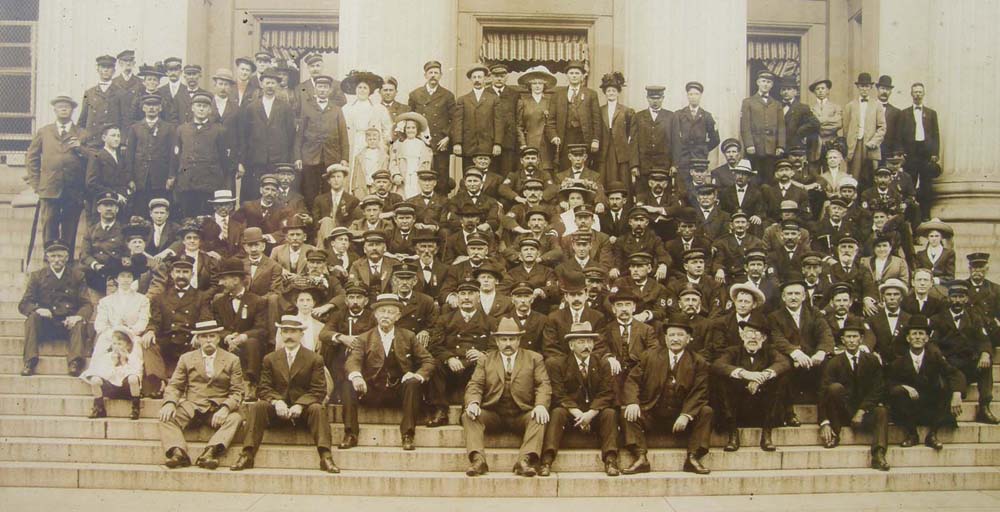
11206a. (framed photograph.) “June
9, 1909. General Superintendent Sumner I Kimball (second row, beside man with
derby), Assistant Superintendent O.M. Maxim and U.S. Surfmen on steps of
Treasury Building, after shaking hands with President Taft in the White
House.” Once property of CWO4 Alvin J. Penny U.S.C.G. (father
of CWO4 Alvin E. Penny). Original mounted photo measures 15” x 18 ½, in
original wood frame. Clear, crisp, no staining. Rare Life Saving Service view.
(VG). $225.
U. S.
Volunteer Life Saving Corps., Sheepshead Bay Station, New York c.1900.
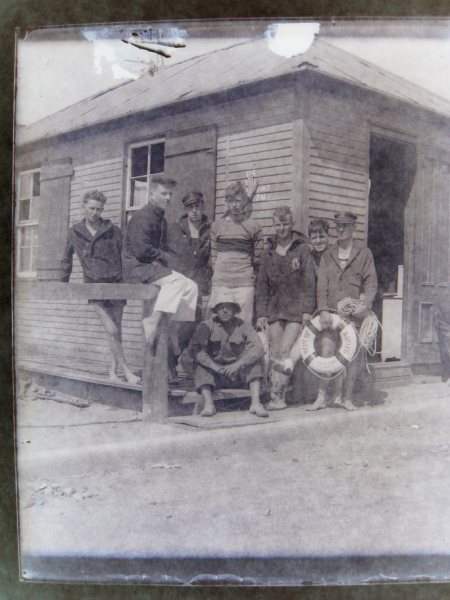
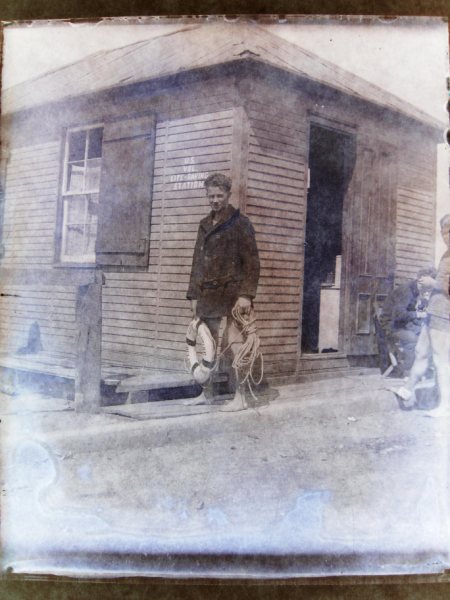
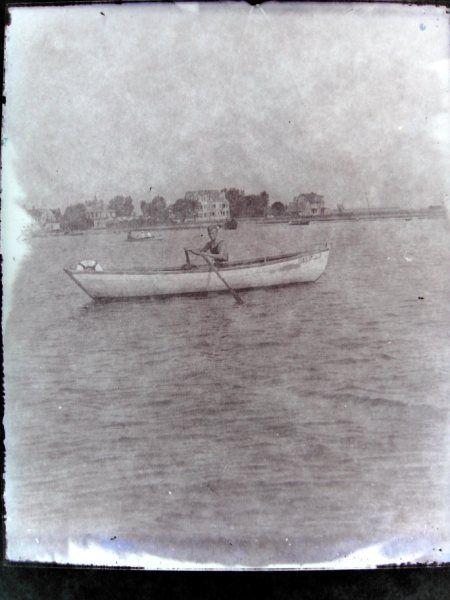
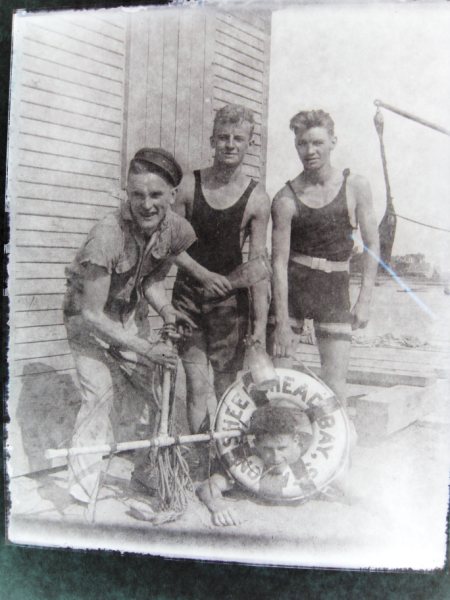
29369. (lot 7 glass negatives) U.
S. Volunteer Life Saving Corps., Sheepshead Bay Station, New York c.1900.
.Lot of seven rare clear glass plate negatives captures nicely the crew and
building of the U. S. Volunteer Life Saving Corps. at Sheepshead Bay, NY.
Sheepshead Bay is a bay separating the mainland of Brooklyn, New York City from
the eastern portion of Coney Island, the latter originally a barrier island. The
U. S.
Volunteer Life-Saving Corps. existed in a number of states and was an early
supplement to the
U. S.
Life-Saving Service in some areas, manning lifeboats and providing life-saving
services on the coast and on inland waters. The Service maintained branches in
15 states where there were no stations of the Government Life-Saving Service or
the Humane Society. Information and awards of this service are exceptionally
scarce and this has become an interesting collection area. Views include the
members posing in front of station with life-saving equipment. Large negative
images measure 4” x 5” and are clear and close. There are some marks and
wear to edges but do not detract. Would provide great clear images. (VG). $165.
For
additional views and information on the Merrimack River Life Saving station,
don’t miss the book written by Vincent L. Wood, who published a chronicle of
life at the Merrimack River Life-Saving Station entitled Plum Island
Recollections [available in soft cover for $16.95]. This interesting work
provides a wonderful account of life as the Keeper of the Merrimack River
Life-Saving Station, bringing together over 80 never before published vintage
photographs made from the family’s archives of glass plate negatives.

11113. (cabinet photo) U.S.
Life Saving Station, Scituate area c.1896. Early close cabinet view
features seven young visitors to the Life Saving station posing on the boat ramp
for the camera. Inside the open door can be seen the surfboat ready for use.
Photo came with a lot of Marshfield photos, probably a Scituate station. Some of
the visitors are identified on the back, which also indicates that it was taken
August 14, 1896. Has been cropped to 5” x 7”. Some damage to emulsion on
right side, edge wear. (G). $38.
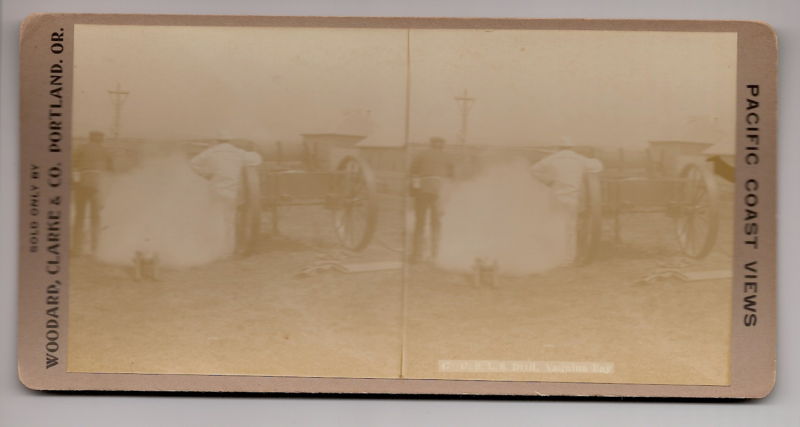
10494.
[stereoview] U. S. Life Saving Drill, Yaquina Bay,
Oregon c.1900 by Woodard, Clark & Company. Fine clear image
features the Life-Saving Service performing breeches buoy drill at the Yaquina
bay Life Saving station. The crew can be seen as the keeper fires the Lyle gun
projectile toward the drill pole as one surfman leans on the beach apparatus
cart. The station can be seen in the background. Nice clear image, just a bit
light. Clean, clear. (VG+). $42.
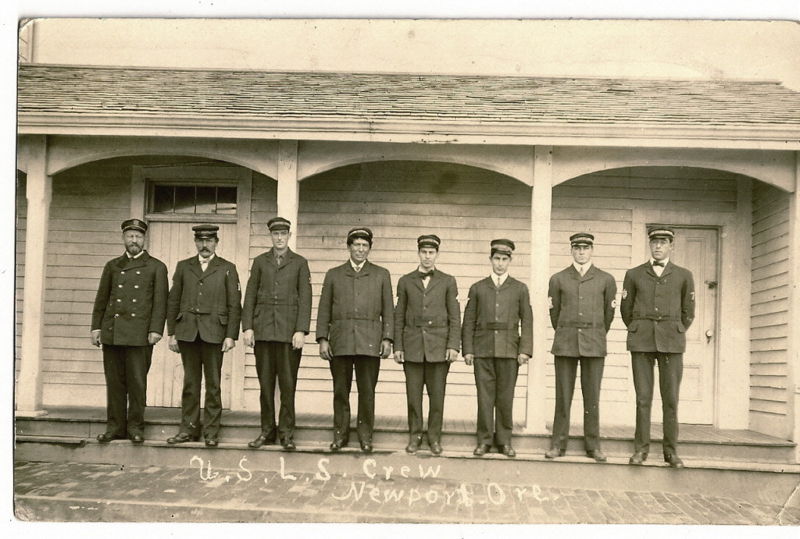
10503.
(photo) U. S. Life Saving Crew, Newport, Oregon c.1912.
Fine clear image features the 8-member Life-Saving Service crew posing in front
of the station at Newport, Oregon. Clear, close b/w photo. Nice view, great
early detail, on postcard paper. Postmarked 1912. (VG+). $62.
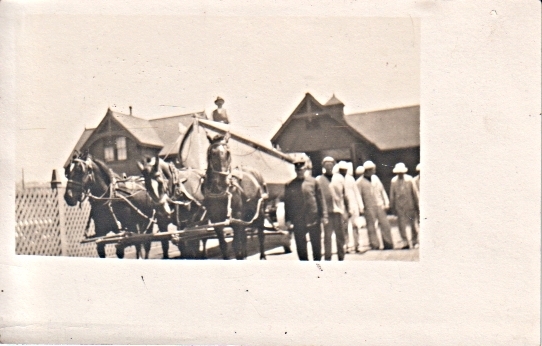
10510.
(photo) U. S. Life Saving Crew with three-horse hitch
c.1910. Fine clear image features the 7-member Life-Saving Service
crew posing in front of the surfboat with a rare 3-horse hitch. Clear, close b/w
photo. Nice view, great early detail, on postcard paper. (VG+). $32.
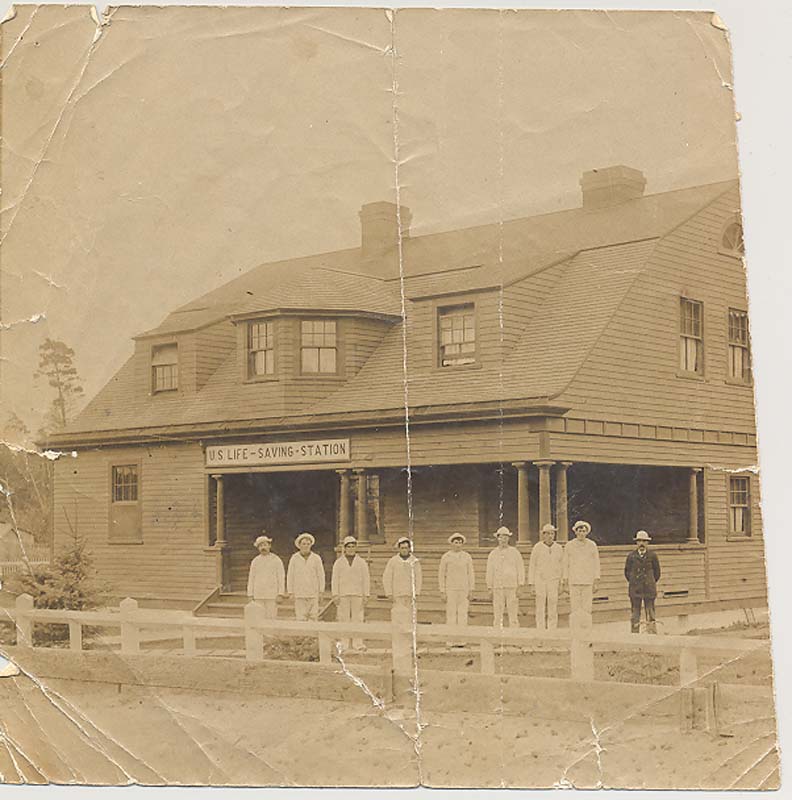
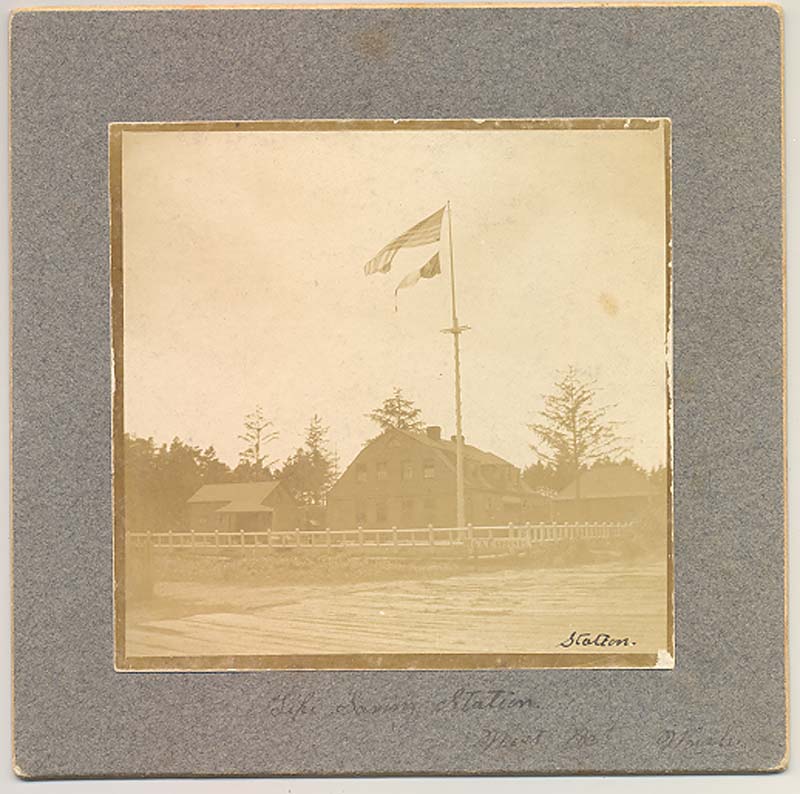
10457a.
(photo) Grays Harbor Life Saving Station,
Westport
,
Wash.
c.1900. Rare, early view shows the rare Peterson’s Point-type life
saving station as the 9-member crew poses in front. Located south of Gray’s
Harbor in
Westport
, the station was originally called the Peterson Point station. Included in this
rare view is the two-story station as seen from the porch side. Image is close,
clear, measuring about 6 ” x 6”. View is clean, clear, but has folds and
creases, moderate wear to edge. Still a very important early image. Station
identified in early ink on back. (G). $76.
10457b.
(mounted photo) Grays Harbor Life Saving Station,
Westport
,
Wash.
c.1903. Rare, early view shows the rare Peterson’s Point-type life
saving station in 1903 shortly after it was completed. Located south of Gray’s
Harbor in
Westport
, the station was originally called the Peterson Point station. Included in this
rare view is the two-story station, separate boathouse, as well as the
keeper’s house, flag pole with Life-Saving Service pennant flying, and more.
Dated August 10, 1903. Image is close, clear on mount. Image measures 3 ½”
x 3 ½”. Clean, clear, just a bit light, identified in early ink on back. A
very nice important early image. (VG). $76.
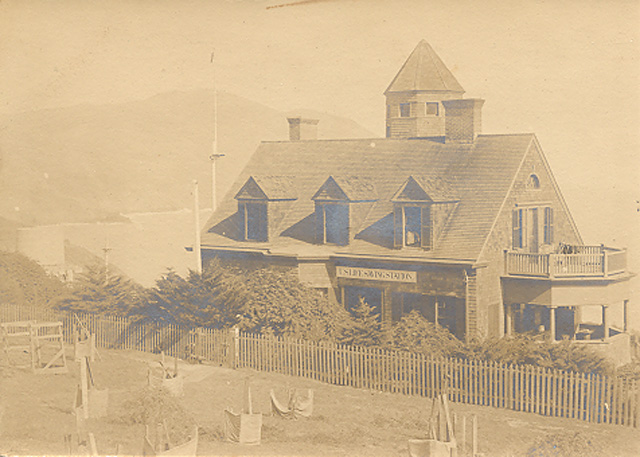
10390. (photo) Point
Bonita Life Saving Station, Sausalito, California c.1900. Clear,
close b/w photo shows the modified Port Huron-Type station built in 1899. The
station had an unusual octagonal lookout tower and guarded this area of high
headlands near the Golden Gate. Nice view, good detail, on postcard paper,
unused. (VG). $54.
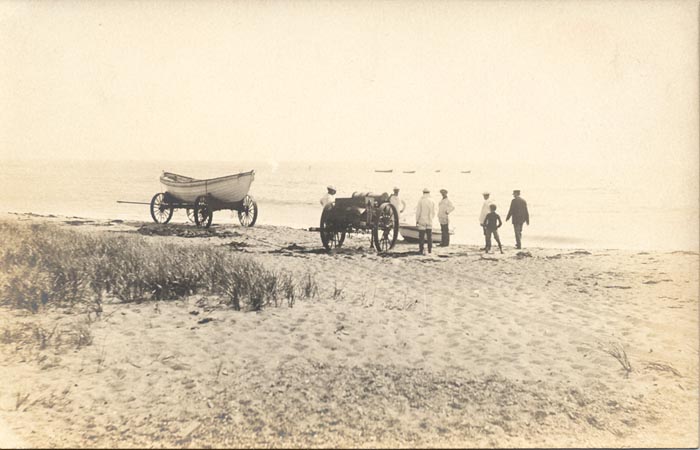
1068. (photo) U.S.
Life-Saving Service Surfboat and Beach Apparatus on the Beach c.1904. Wonderful
clear view of Keeper and crew on the beach with beach apparatus cart,
surfboat and Francis Metallic Life-Car as a young boy looks on. Though
just a bit distant, nice clear view, nicely composed. A rare lifesaving
views and would be quite nice matted and framed. Clear view measures 3 ½”
x 5 ½” on postcard paper, dating from 1904-1915 based on stamp box.
Clean, crisp, not postmarked. (VG+). $110.

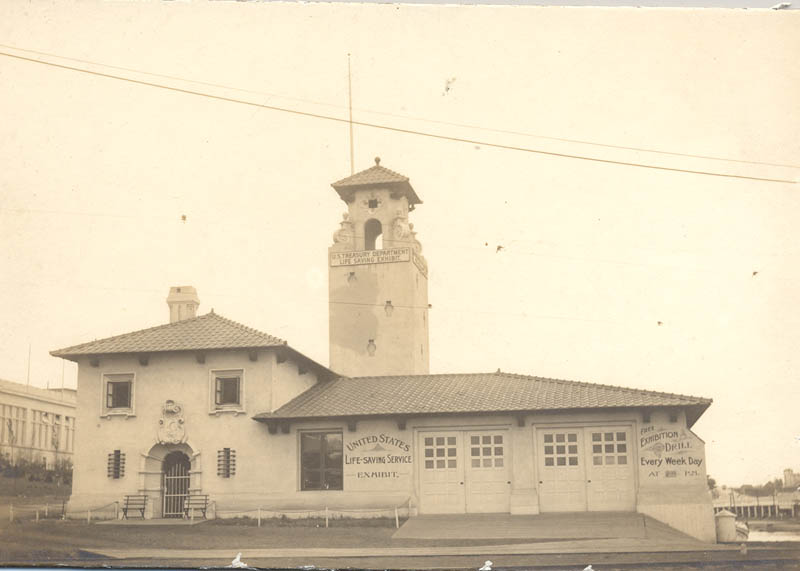
1043.
(cabinet photos) U.S. Treasury Department Exhibit U. S.
Life-Saving Service. c.1900. Unusual clear close views feature the
Life-Saving Service exhibit building [station], probably at a world’s
exposition at the time. The building is well detailed in these views from the
front and a second from a higher perspective. Views measure 4 ½” x 6 ½”
and are clear and crisp. Some edge wear from early trimming. These photos are
from the personal collection of Lieut. C. H. McLellan, Assistant Inspector of
United States Life-Saving Service Stations. (VG). $48 each
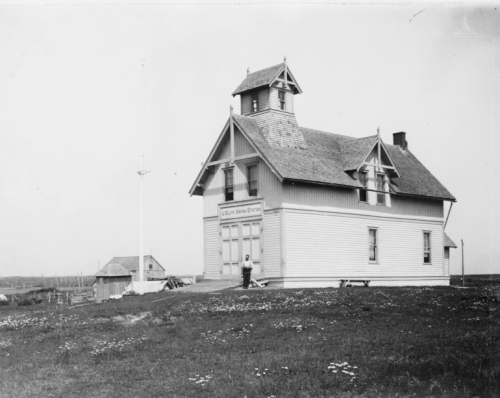
10237.
(copy photo) U.S. Life Saving Station, Ditch Plain,
Long Island, New York. 8 ½” x 11”. Great digital copy
photograph, clear image from original photo, shows the 1882-Type life saving
station SW of Montauk Lighthouse. $24.
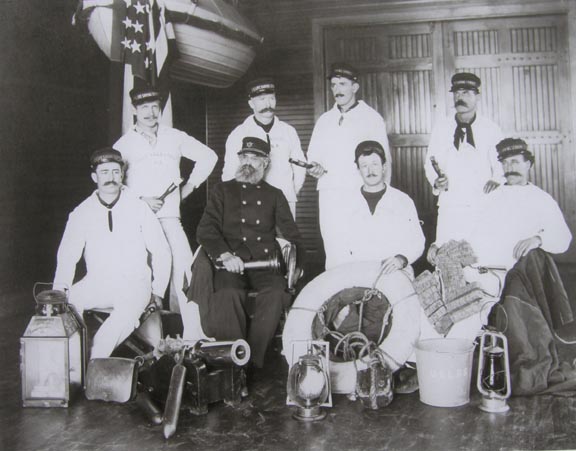
29380.
(copy photo) LIFE SAVER JOSHUA JAMES WITH CREW, Hull,
Massachusetts c.1890’s. 11” x 14”. Superb, crystal clear image
from original glass plate negative, probably by noted photographer Baldwin
Coolidge in the 1890’s, shows renown life-saver Joshua James posing with his
crew in the station boatroom. Image is from the archives of the Society for the
Preservation of New England Antiquities. Keeper Joshua James, from the Hull,
Massachusetts Life-Saving Station, was one of the most famous life-savers in
Coast Guard history. Joshua James was associated with the Massachusetts Humane
Society from his early youth until he was made keeper of the Hull station of the
Life-Saving Service. His sixty years of rescues and the medals that he and his
crews earned were never equaled by any other keeper or crew. Amazingly clear,
perfect for framing. Shipped flat. $110.
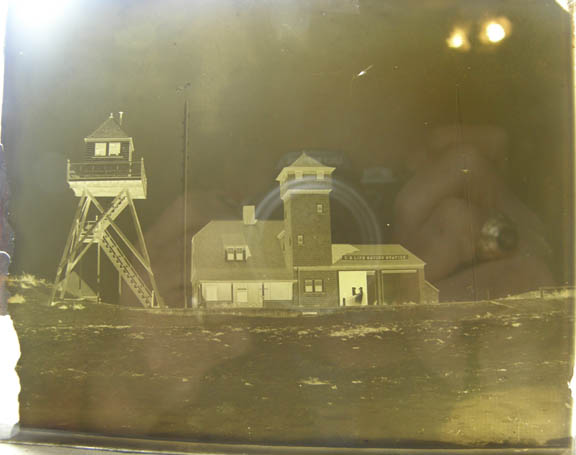
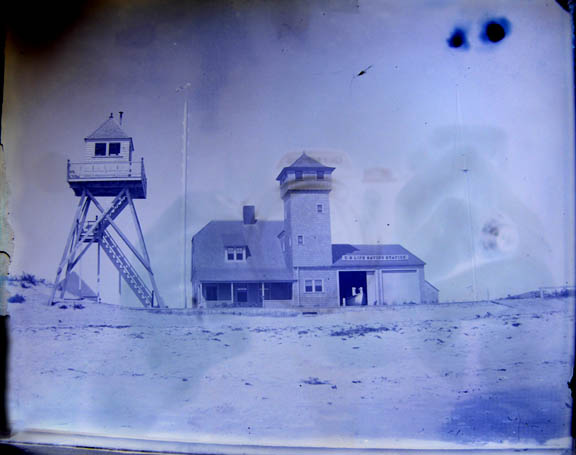
29308. (lot 4 glass negatives)
Salisbury Beach Life Saving Station, Mass. c.1900. Lot
of four clear glass plate negative captures nicely the Salisbury Beach Life
Saving station on the Massachusetts North Shore. This Duluth-type station was
built in 1897. Views include the station as well as the added beach lookout
tower. Large images measures 4” x 5” and are clear and close. There are some
marks and wear to edges but do not detract. Would provide great clear images.
(VG). $265.
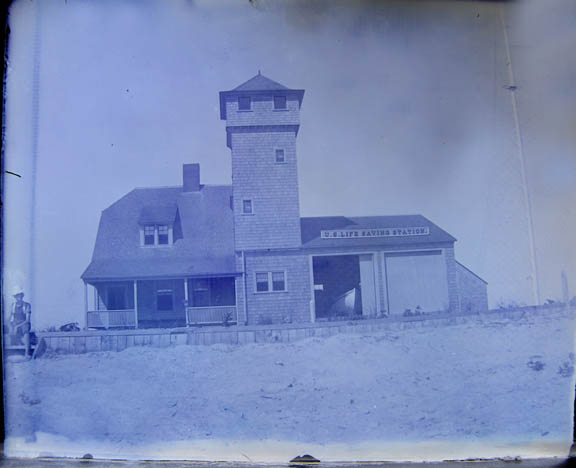
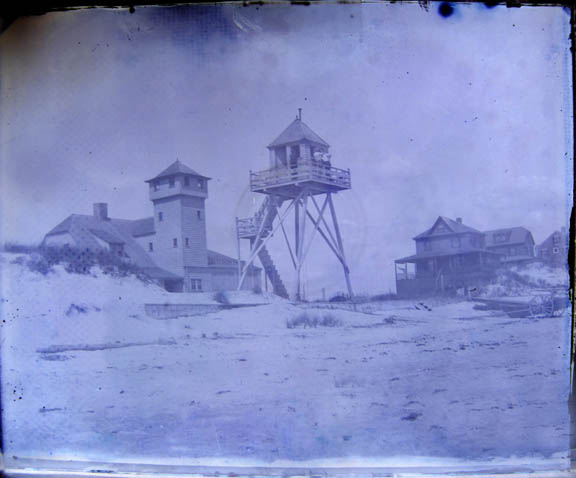 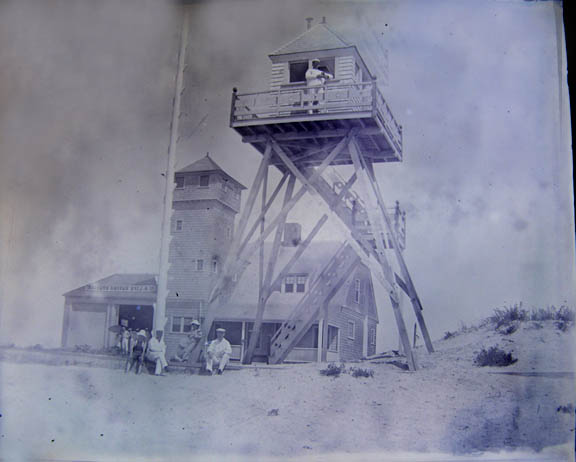
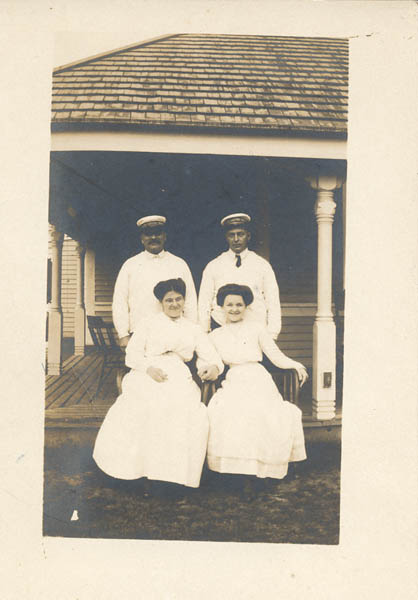
29318. (photo) U.
S. Life Saving Service Surfmen Posing with Wives c. 1910. Rare close
photo shows two surfmen posing behind their seated wives. Rare family view.
Close b/w images on postcard paper. 3 ½” x 5 ½”, clean, crisp. (VG+). $48.

29258. (lot 11 photos) Damiscove
Island Life-Saving station, Maine c.1900. This modified Port Huron
Type station was built in 1897 near Boothbay Harbor, Maine. Views measure 3 ½”
x 4 ½” and include views of the station, additional boathouse, breeches buoy
drill, and a number of views of the station motor surfboat and motor lifeboat.
Rare lot. These photos are from the personal collection of Lieut. C. H. McLellan, Assistant Inspector of United States Life-Saving Stations. Some
duplicates. VG). $118.
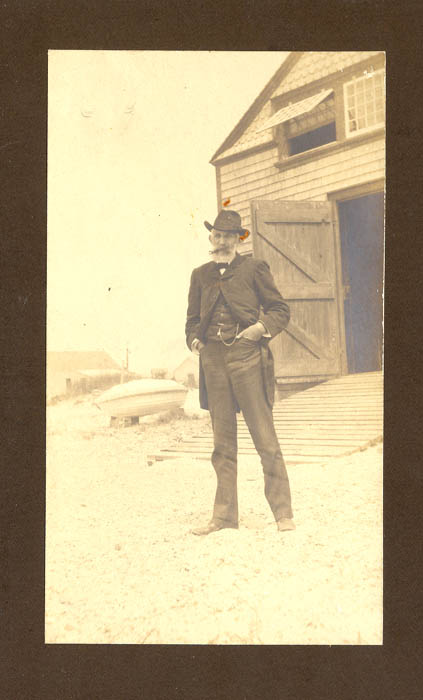
29287.
(mounted photo) U.S. Life Saving Service, District
Superintendent, 3rd Life-Saving District, Arthur Dominy c.1900. Great
image shows a close, clear view of who we believe to be Arthur Dominy, 3rd Life
Saving District Superintendent standing in front of an expanded Red House type
station on the Long Island coast. Note to his right is a Francis Metallic Life
Car sitting on blocks on the sand. Image measures 3” x 5 ¼” on original 4
½” x 6 ½” mount. Clean and clear, nice view. This photo is from the
personal collection of Lieut. C. H. McLellan, Assistant Inspector of United
States Life-Saving Stations. (VG+). $85.
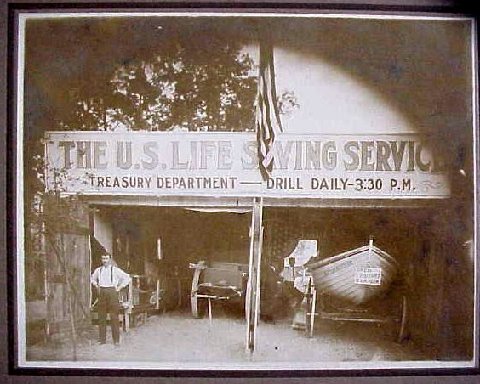 
29244. (photo Lot) U.S.
Life Saving Service c.1900. Superb lot of four large mounted
photographs provides a number of different views of the Life Saving Service
activities at a turn of the century exposition. Images measure about 6 ½” x 8
½” each on 10” x 12” mounts. Views include: Interior view of the
temporary Life-Saving station set up for the fair; Station crew posed by the
station door; Close view of the crew performing the roll-over drill for the
throngs of onlookers; Large group of life-savers (more than 28 surfmen and
keepers) poses with family (?). Photos are all clear and close, in good
condition, some wear to mounts. A rare lot. (VG). $485.
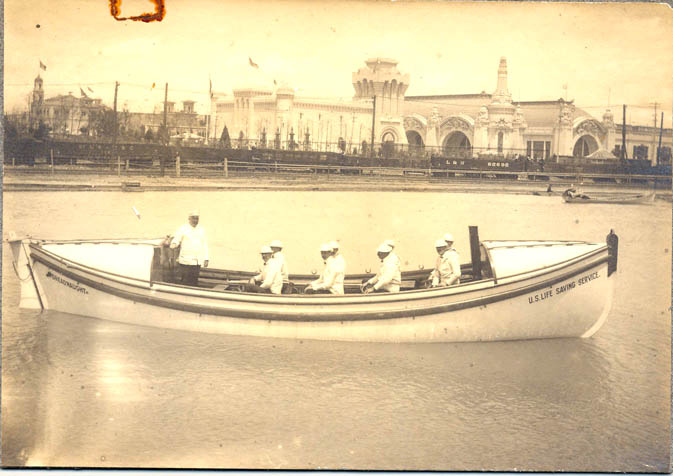
29252a.
(photo) U.S. Life Saving Service Type E Motor Lifeboat
Dreadnaught (Point Adams LSS, Washington). 4 ¾” x 6 ¾”. Crew in
white summer uniform. Clear, crisp, one rust mark. (VG-). $74.
29252b.
(photo) U.S. Life Saving Service Type E Motor Lifeboat
Dreadnaught (Point Adams LSS, Washington). 4 ¾” x 6 ¾”. Crew in
white summer uniform. Clear, fold through center, some wear. (G). $22.
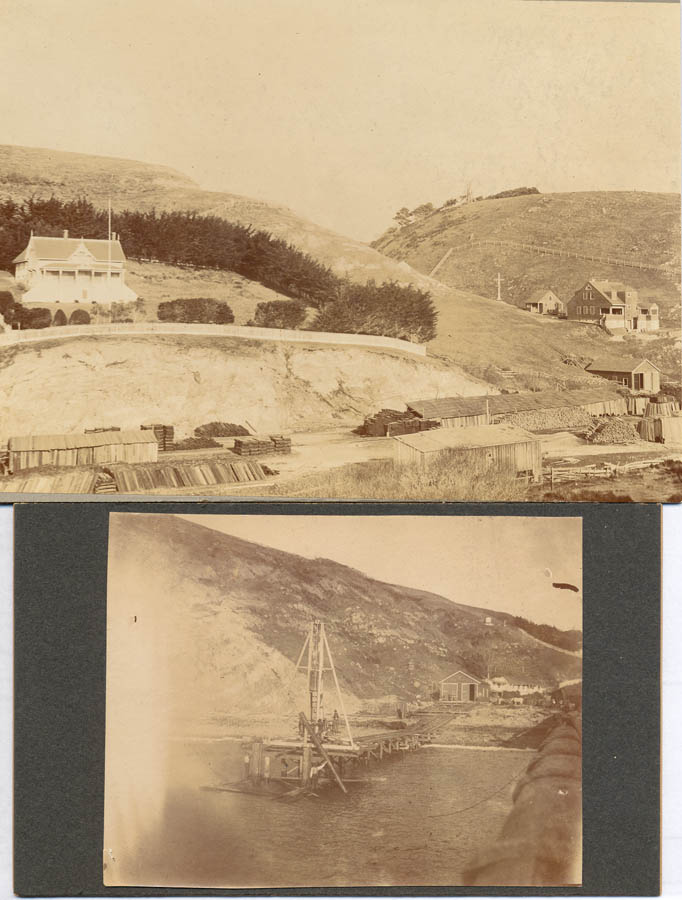
29285. (lot 3 mounted photos) Arena
Cove Life-Saving Station, Point Arena, California c.1900. Three large
mounted photos show the station located in the canyon, and two views of the
boathouse and launchway before and while under repair. The Arena Cove station
was a modified Port Huron-Type station built without the octagonal tower because
the high hills necessitated the look-out be placed on top of the cliff. Today
the station is a bed and breakfast inn. Station photo measures 5” x 7”, and
the two boathouse views measure 3 ½” x 5” each. Nice clear views. These
photos are from the personal collection of Lieut. C. H. McLellan, Assistant
Inspector of United States Life-Saving Stations. (VG). $118.
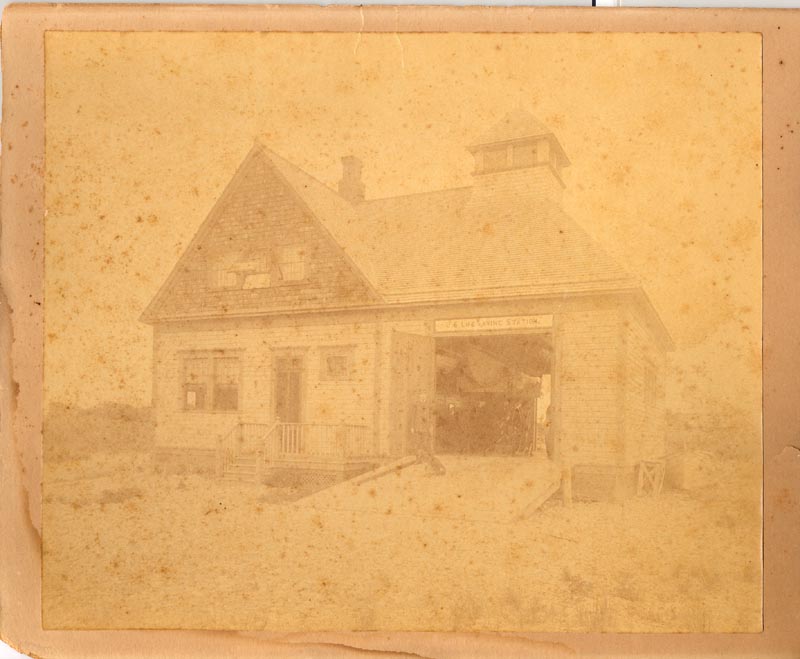
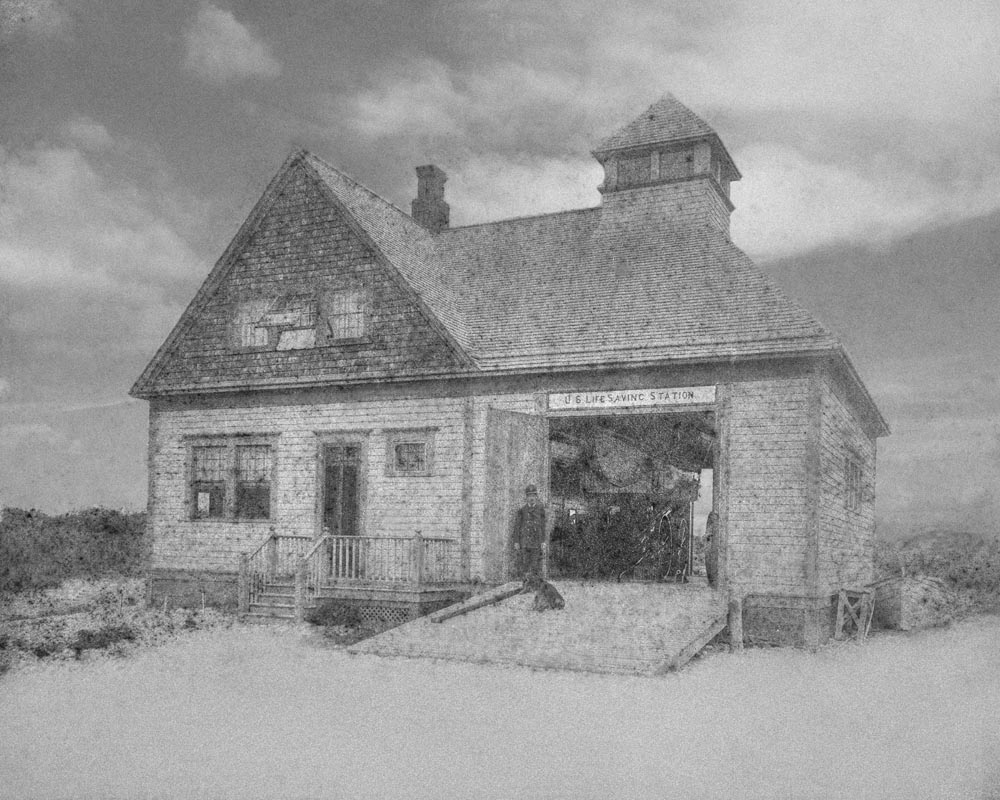
RA-414. (mounted photo) North
Scituate Life Saving Station c.1890. Wonderful rare early image of
the early 1887 Bibb #2 Type life saving station on the beach at North
Scituate, Massachusetts. Original albumen image measures 7 ¼” x 8 ¾” and
is on original 8” x 10” mount. Image is unusually close, showing the entire
station with boatroom doors open as the keeper stands on the boatramp. Inside
can be seen boats suspended from the rafters and the early beach apparatus card
on the floor. Though image is clear and close, it has faded from time and has
light – moderate foxing throughout. Still a great early image of this well
known station. Photo completely intact, some edge wear to mount. Included is a
scanned and retouched full size image with enhanced contrast, and both images on
CD. (G+). $225. Reduced $100.
LIFE
SAVER JOSHUA JAMES
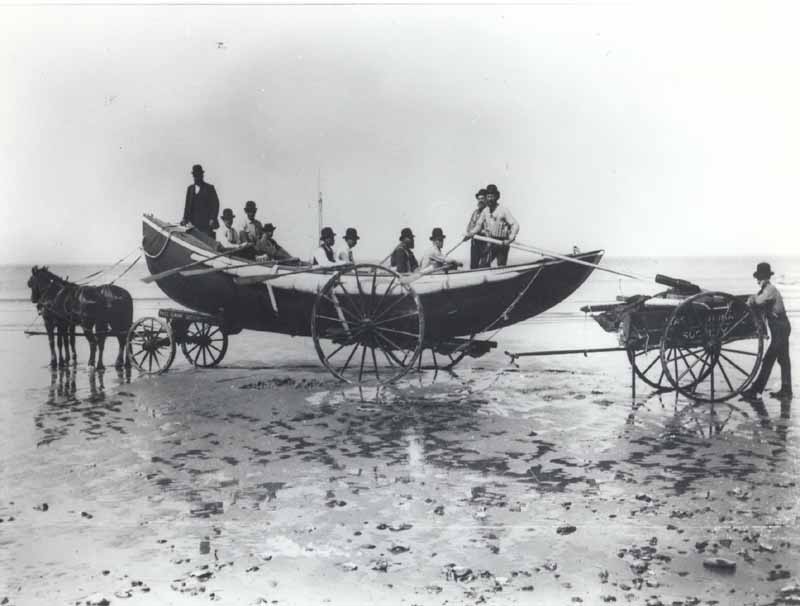
 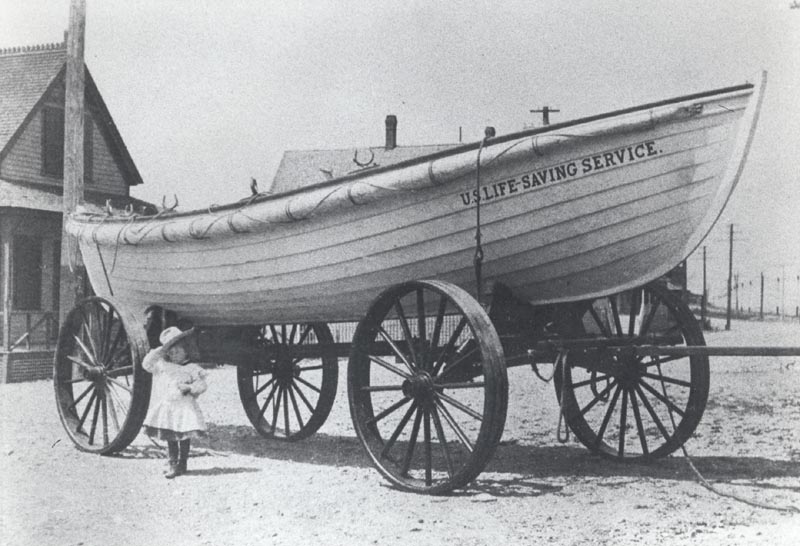
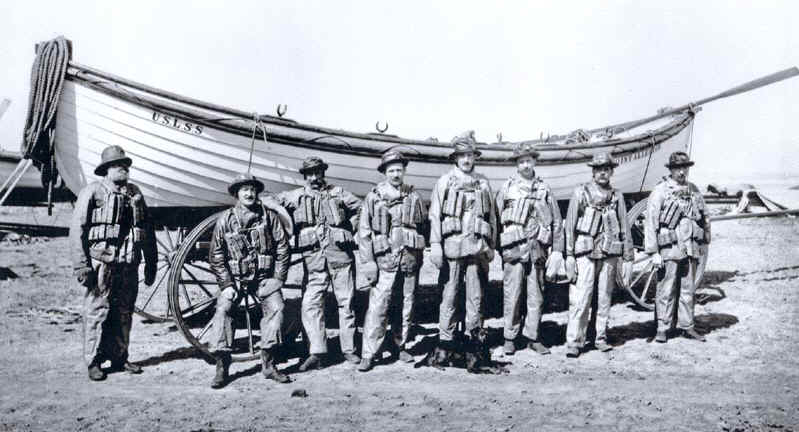
29403. (copy negatives) LIFE
SAVER JOSHUA JAMES WITH CREW,
Hull
,
Massachusetts
c.1890’s. 11” x 14”. Superb, crystal clear images made in
recent years from original prints from glass plate negatives by noted
photographer Baldwin Coolidge in the 1890’s, shows renown life-saver Joshua
James posing with his crew. Four negative views available include: a young
Joshua James with his crew in the Massachusetts Humane Society surfboat, with
Hunt gun and beach apparatus gun behind; Joshua James posing with his crew on
the beach in front of their surfboats and beach apparatus carts; Joshua James
posing with his crew on the beach in front of their surfboats. Clear and closer;
Life Saving Service surfboat on carriage. Keeper Joshua James, from the
Hull
,
Massachusetts
Life-Saving Station, was one of the most famous life-savers in Coast Guard
history. Joshua James was associated with the Massachusetts Humane Society from
his early youth until he was made keeper of the
Hull
station of the Life-Saving Service. His sixty years of rescues and the medals
that he and his crews earned were never equaled by any other keeper or crew.
Clear views, 3” x 4”, would make fine prints for framing. $68 each. Lot of
four $234.

29180a.
(cabinet photo) U.S. Life-Saving Service, Biddeford
Pool Station, Maine c.1890-1900. One of the rarer, more desirable
views that I have found. This charming piece measures 3 ¾” x 5” on original
gray 5 ½” x 6 ½” mount, and provides an extremely rare view of the life
saving crewman shaving another beside the early 1874-Type Biddeford Pool (later
called Fletchers Neck) station. Beautiful clear view shows great detail of the
two men, one with a cloth covering his uniform as he leans back under the
shaver’s razor. Such views of day-to-day life are extremely rare and
desirable. Image is clear and close, little if any soiling. This is an
exceptionally rare view and is truly a museum piece. Photo by Charles S. Butters
Photographer, Haverhill, Mass. Both stations still exist today, lovingly
preserved. (VG+). $245.

2943. (photo) U.S. Life
Saving Station, Little Cranberry Island, Maine c.1913. Clear
though a bit distant view shows lonely station in great detail as a man
poses on the boatramp. In back a surfman stationed there penned a note to a
friend, noting that “The man on the post is not yours truly”. Clear view
measures 3 ½” x 5 ½” on postcard paper. Light wear, postmarked July
29, 1913. (VG+). $44.
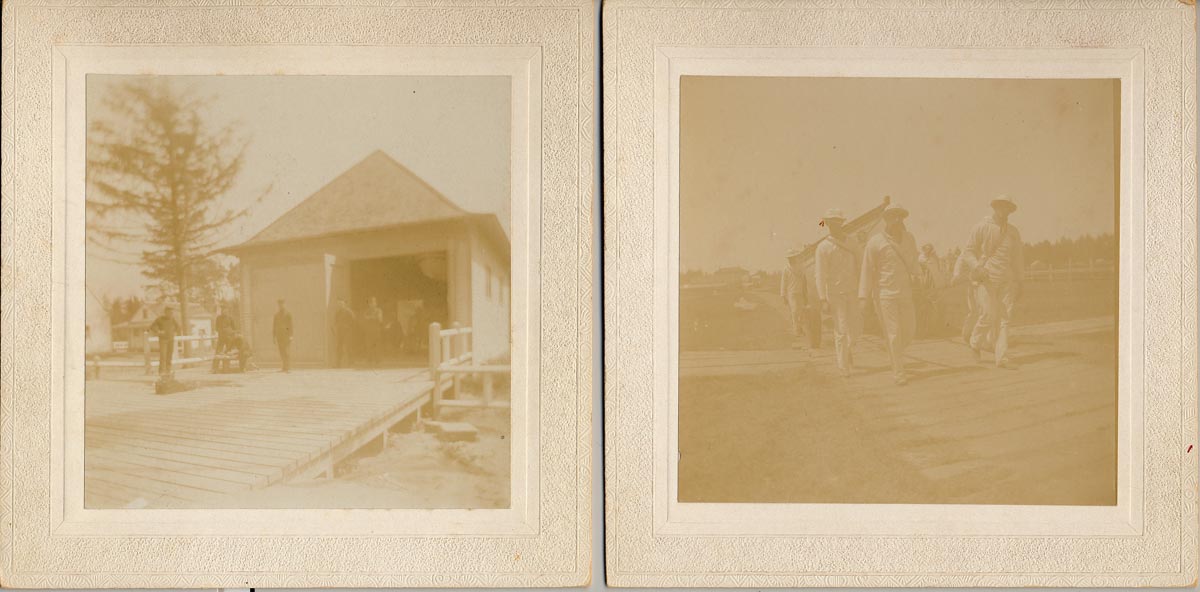
28396. (mounted photos) U.S.
Life Saving Station and Crew, Ilwaco, Washington c.1900. Great
set of two original mounted photos show the crew posing on the boat ramp
of the station boathouse, and the crew pulling the surfboat on its
carriage to the beach. Photos each measure 4” x 4” on 5 ½” x 5 ½”
fancy white mat. Photos are clear and close, but just a bit light.
Only very light if any wear to mounts. (VG). $112.
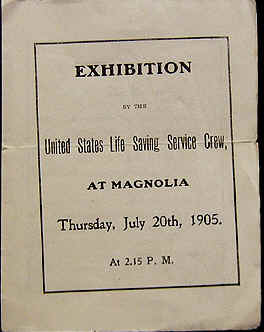
29204.
(program) Exhibition of the United States Life Saving
Service Crew, Magnolia, Mass. 1905. 4p.Rare folded program details
the drill events to be presented by the experienced crew of the Gloucester
Life-Saving Station including use of their Beebe McLellan Self-bailing
surf-boat. Also appearing in the demonstrations, acting as the sailor in
distress, was to be a sailor recently wrecked and actually rescued by the crew
of the Cahoon’s Hollow Life Saving Station on Cape Cod in 1896. Clean, light
wear, brittle at one early fold. Rare memento. (VG-). $46.
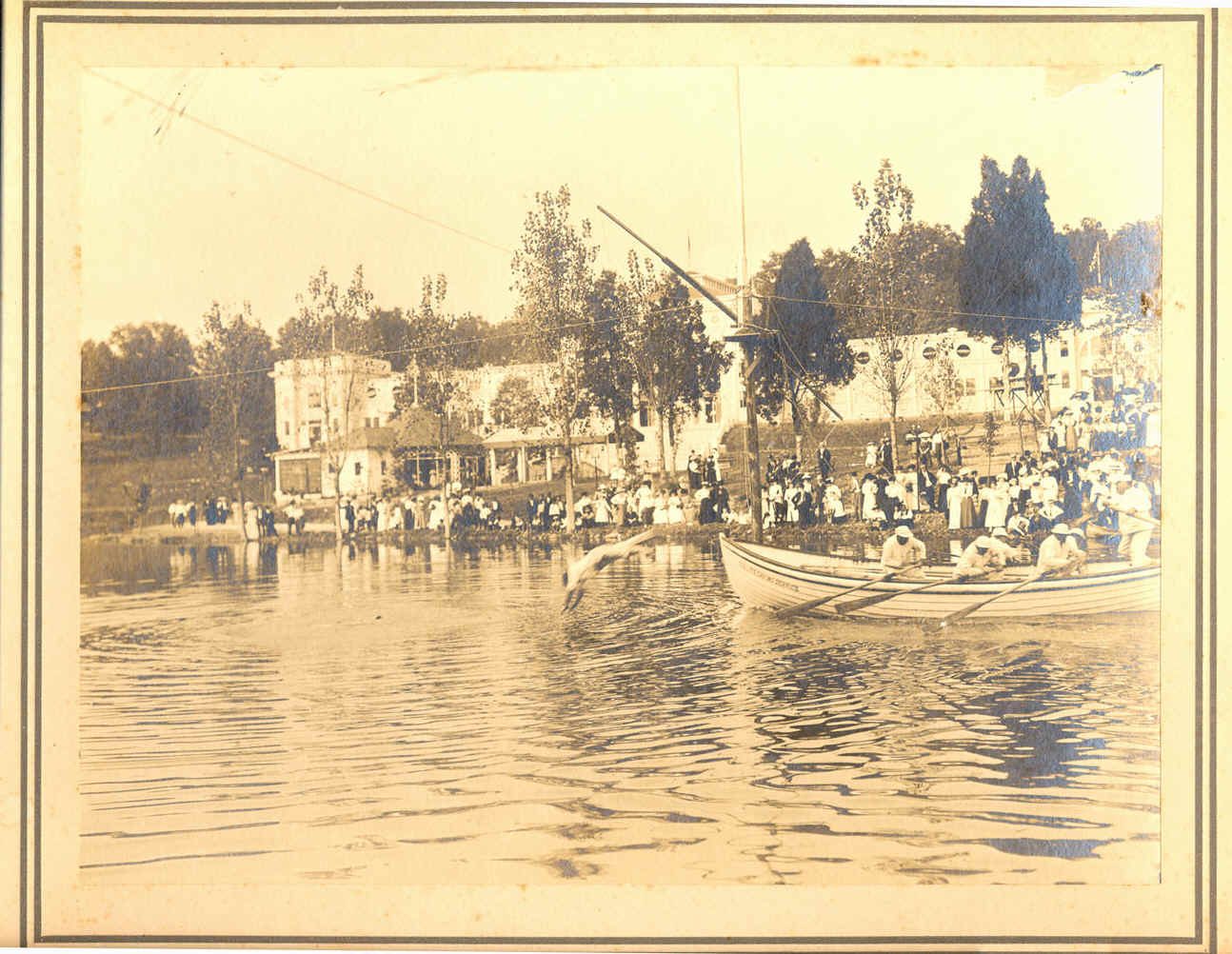
28280. (set 3 large mounted photos) U.S.
Life Saving Service Surfboat Drill, Appalachian Exposition in Knoxville,
Tennessee, 1910. Superb lot of three original large mounted
photographs of the life-saving crew with their Beebe-McLellan type
pulling/sailing surfboat performing the surfboat roll-over drill at the 1910
Appalachian Exposition in Knoxville, Tennessee. Photos measure 7 ¼” x 9 ½”
on 12” x 14” mounts. Mounts marked with photographer’s name “Thompson
Photographer Knoxville”. The views show clear, close views of the life savers
performing the roll-over drill including the boat upright with surfman jumping
into the water, surfboat on its side as the men pull her over, and final view of
the boat completely upside down with the men on the top, preparing to right her.
In the background can be seen the crew’s temporary boathouse and large drill
pole, as well as other exposition buildings. The Appalachian Exposition of 1910
was held in Knoxville from September 12 to October 12, 1910. Although large
expositions were commonplace at the turn of the century, and county, regional,
and state agricultural fairs predated this Knoxville convention, the Appalachian
Exposition of 1910 was the first one held in the southern Appalachian region.
The intention of the fair was to demonstrate progress in southern industry and
commerce. The midway of the exposition hosted attractions ranging from "Muhall's
Wild West Show" to "The Infant Incubator." Aeroplanes at the fair
were the first to be seen in East Tennessee. Former president Theodore Roosevelt
visited the fair and praised the promise of the fair and of the region. Moderate
staining to mounts but photos are in overall very good condition. A superior
set, perfect for display. (VG-). $565.
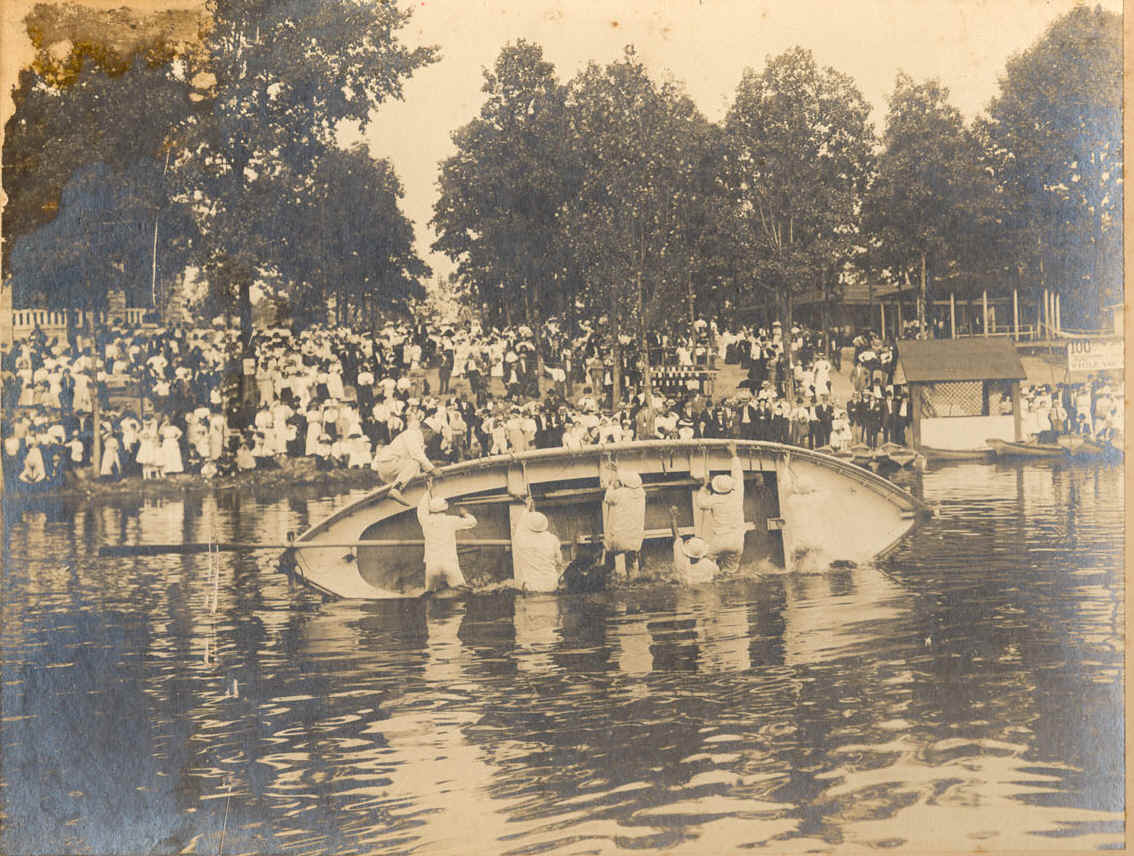
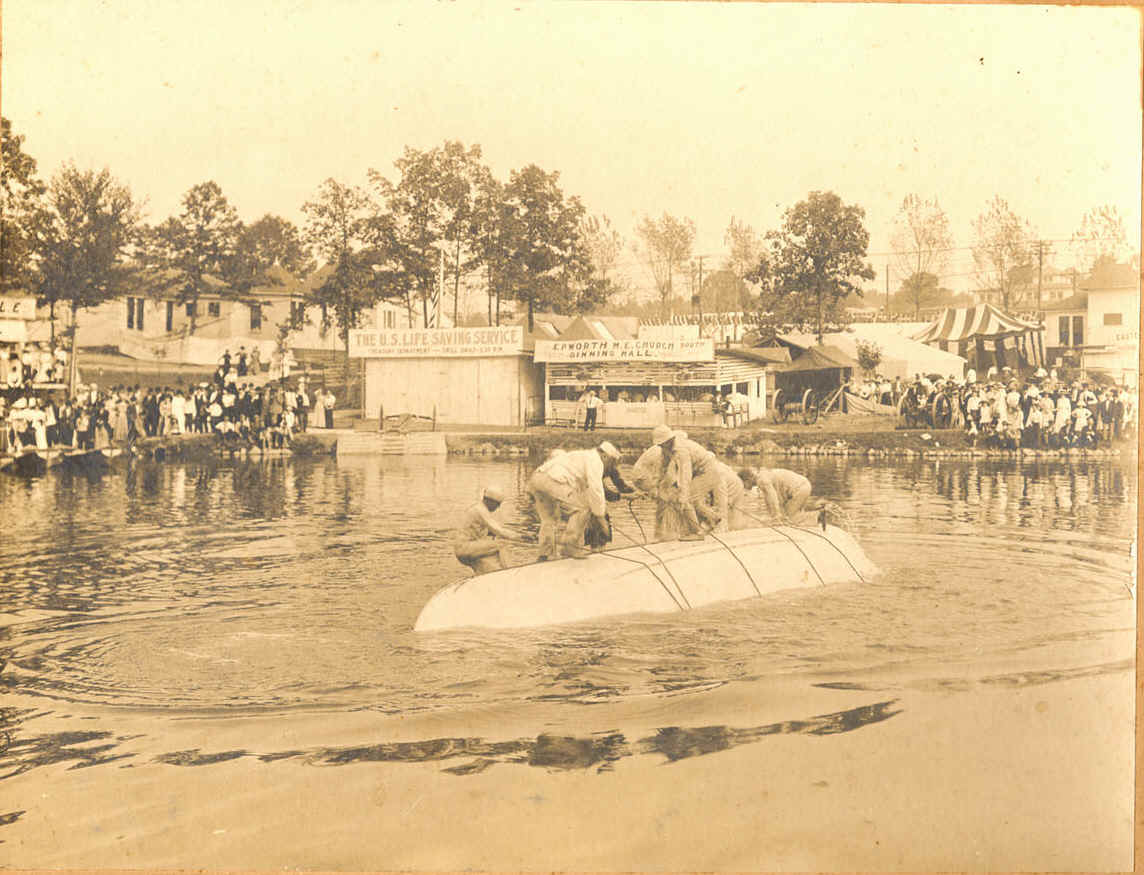
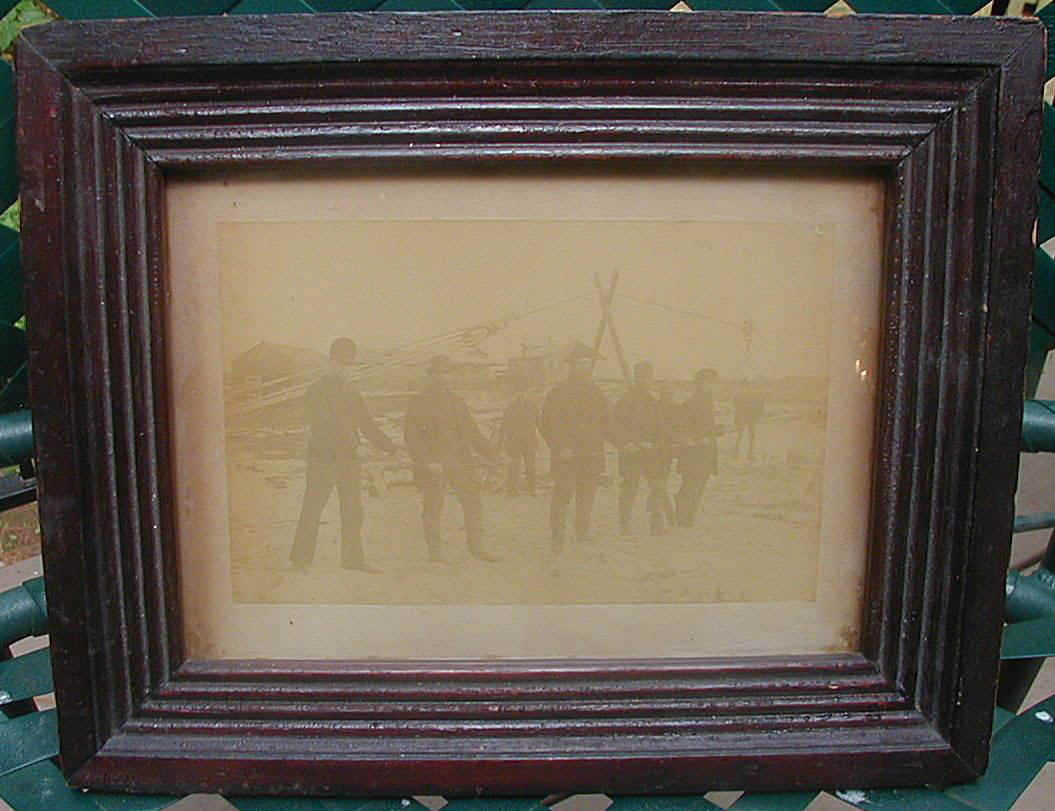
27356. (early framed photograph) U.
S. Life Saving Crew Breeches Buoy Drill c.1860-1870 (New Jersey?) .
Very early close albumen photograph image of life-savers posing at the breeches
buoy as they drill. This image is from the period before uniforms were required
and as such is extremely rare, giving us a look at their early dress and
equipment. Behind the men is clearly visible the A-frame and block-tackle, as a
man hangs from the hawser in the breeches buoy. Photo is from a New Jersey
estate and is likely from of an early New Jersey crew. The image measures 5 ½”
x 8 ½” in original 11” x 13 ½” wood frame with wood backing. Image is
unusually clean and clear, but has faded some over time. Frame has original
finish, needs to be cleaned up some. We find very few images from this time
period and rarely are they this large. (VG-). $335.
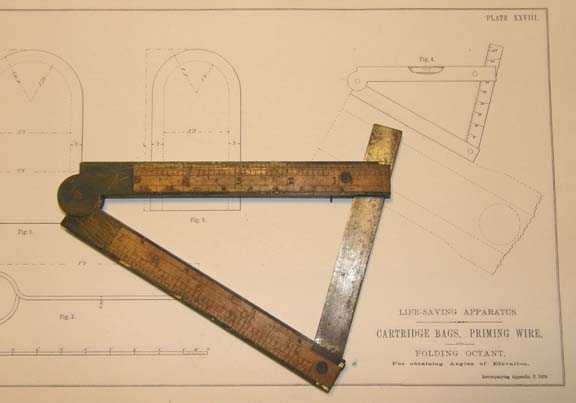
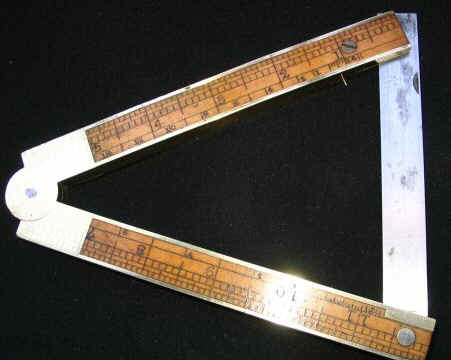
27361. U. S. Life Saving
Service Lyle Gun Folding Octant c.1878-1901. This octant, or
elevation level, was used by the Life Saving Service for setting the
elevation of the Lyle Gun. From 1878 until 1901 the Life Saving Service use
this octant, made by the Chapin Stephens & Co in Riverton, Conn. In 1901
when this company ceased operation, the government began to make their own
elevation levels. However these were entirely of metal, lighter and of a
lesser quality. Octant is made of boxwood, brass bound and includes a metal
fold-out scale for setting the angle, with a bubble level set into the upper
arm. The octant was carried by the keeper in his haversack. Marked “The
Chapin Stephens Co” Scarce, early piece. (VG+). $325.
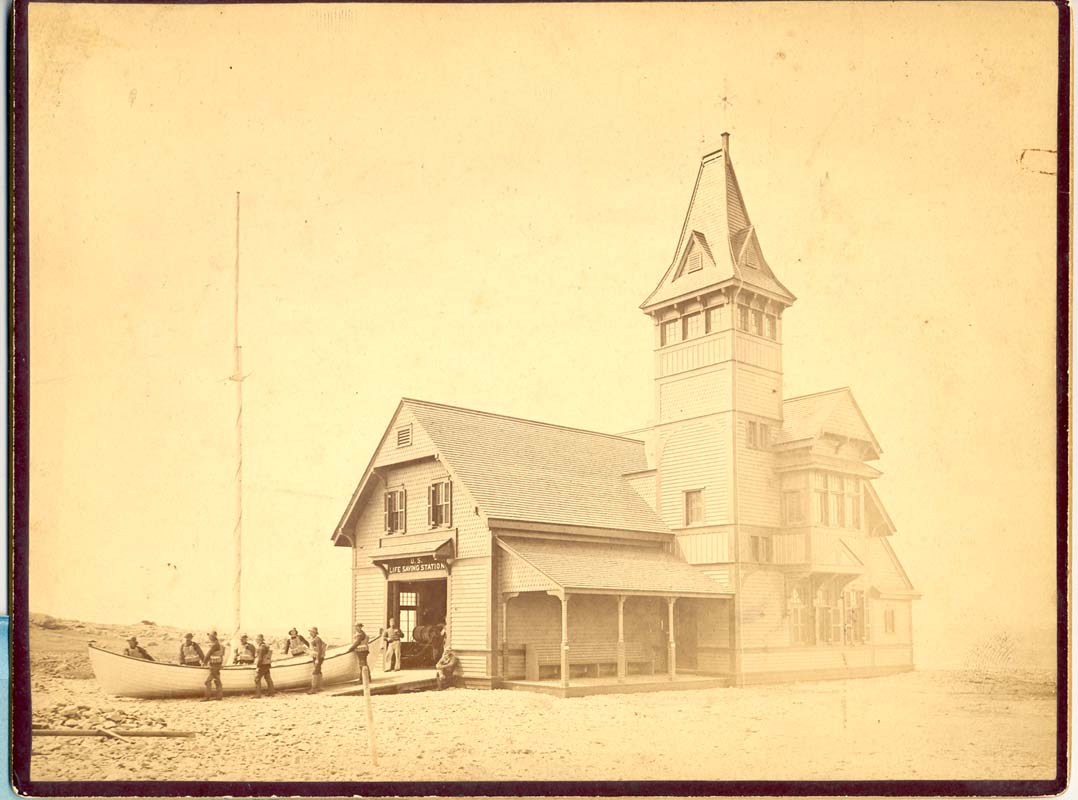
27338.
(cabinet photo) Brenton Point Life Saving Station and
Crew c.1890 by Child & Co., Newport, Rhode Island. Superb large,
close view of the 1884 Deal-type life-saving station located on Prices neck in
Newport. The station was designed by Paul J. Pelz and was a bit fancier than
most stations, to fit in with the architecture of the area. The photo measures 6
½” x 8 ½” and includes the crew in their life-jackets posing in their
positions around the surfboat. Photographer’s label "Child & Co,
Artists in Photography, New York And Newport.
Newport
Studio:
242 Thames Street
, Duplicates can be had at any time." on obverse. Superb clear view, just a
hint of soiling and a bit light toward one side. (VG). $425.
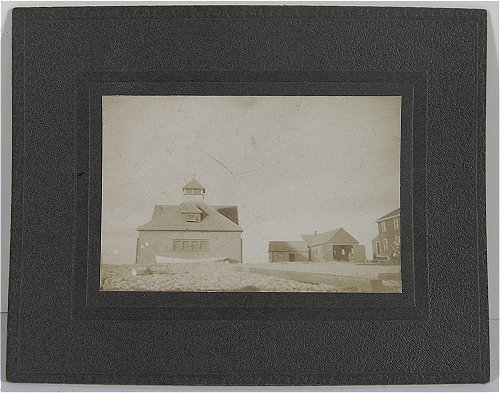
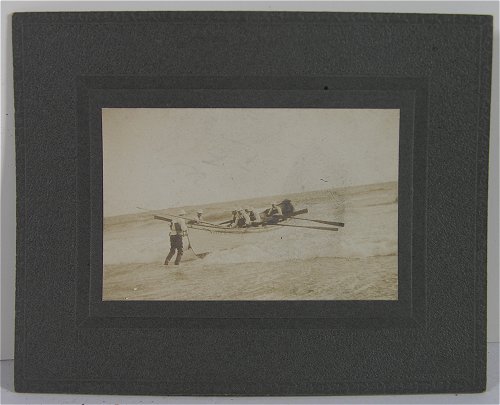
27183.
(lot 5 mounted photos) North Scituate, United
States Life Savings Service Station and Crew c.1905. Lot of five,
very rare, original c.1905 mounted photographs of the North Scituate,
Massachusetts United States Life Savings Service Station and members of the crew
as they drill. Each of these wonderful, outdoor photograph measure approx. 3
1/8” x 2” and are mounted on their original, matching card mounts (overall
size is of each card mount measures 5" x 4"). The images are
unidentified but the words "North Scituate" can be read on the
surfboat seen in four of the photos. Views include a wonderful image of
the seven crewmen transporting their boat across the beach to the water, two
images of the boat being launched into the surf, one image of the boat in open
water just off shore. Fifth image is of the Bibb Type #2 station and adjacent
boathouse. These rare photograph are in excellent condition overall,
possibly just a bit light, a hint of soiling on one or two mounts. A very rare
and very attractive coordinated set of members of the United States Life Saving
Service "in action" and a great addition to any US Life Saving Service
Collection. (VG+). $425.

2764. [cabinet photograph] c.1900.
Original portrait photograph, Life-Saving Service Crew,
Quoddy Head, Maine. c.1890-1910. This rare posed portrait photograph
shows the handsome crew of young surfman proudly posing with the keeper and a
woman on the station boat ramp. The woman is holding a rolling pin in the photo
may be the keeper’s wife, or the station cook. The photo itself measures
6.5" by 4.5" and has been matted to a completed size of 8 X 10 inches.
A plate of glass has been placed over the mat and it has been bound to the
backing with binding tape. There is an original notation "Quoddy Head
Crew" in the lower right corner of the photo. A rare view both for the
location and the presence of a possible family member, and that it is labeled so
we know the location. This station was built "near West Quoddy Head
Light" in 1873 and until 1 June 1883, it was carried in the records as West
Quoddy Head station. This is unusually close and clear, one of the better
images we have had in some time. Little or no wear, a perfect piece for framing.
(VG+). $365. Reduced to $340.
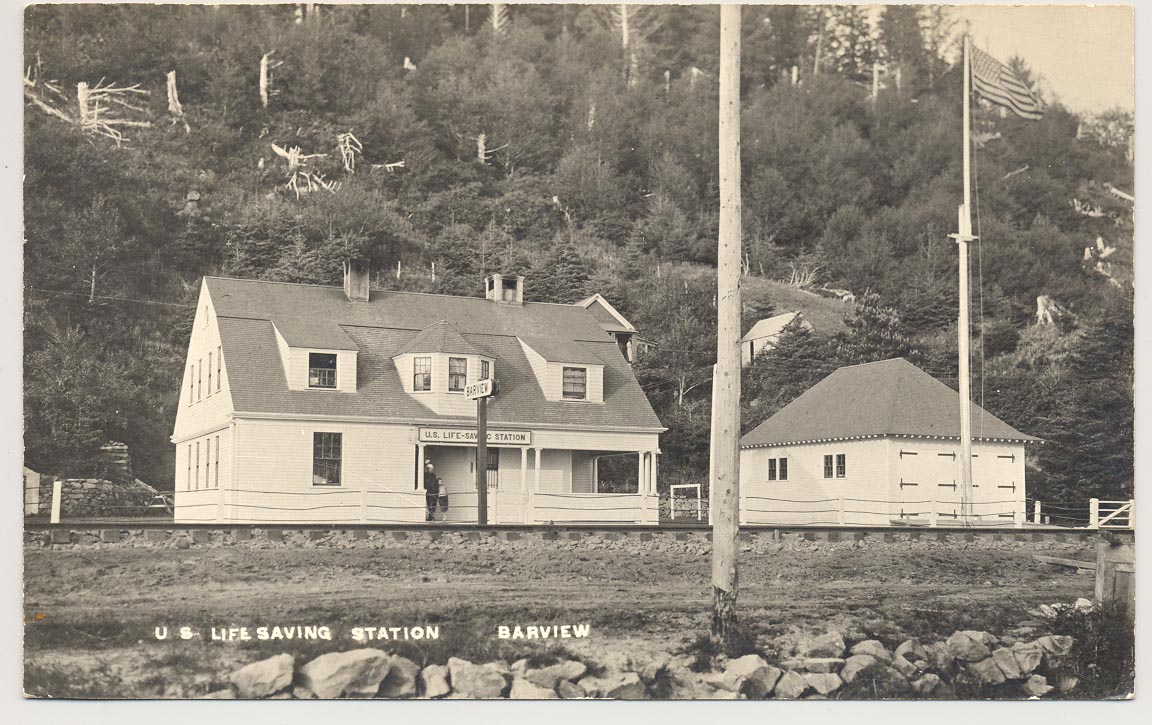
2769. (photo) Close, clear photo of U.
S. Life Saving Station, Tillamook Bay, Barview, Oregon c.1916. Close
clear real photo image shows the rare Petersons Point-style station, the only
surviving example of this style station. Close view of the front of the station
house and detached boathouse. Clear, close b/w images on postcard paper. 3 ½”
x 5 ½”, postmarked 1916. (VG+). $44.
27352.
(copy photo) Deal Life Saving Station, New Jersey.
c.1885 Clear close copy photo shows the life saving station in its
early years. 8 ½” x 11” digital copy photo provides an unusually
close view. (F-). $24.
27353.
(copy photo) Stone Harbor Life Saving Station, New
Jersey. c.1912 Clear close copy photo shows the lifs saving station
with the crew assembled. 8 ½” x 11” digital copy photo provides an
unusually close view. (F-). $24.
Merrimack River Life-Saving
Station, Plum Island, Massachusetts

28395. (mounted photo) Capt.
Thomas J. Maddock and the Crew of the U. S. Merrimack River Life-Saving
Station, Plum Island, Massachusetts c.1900. Superb clear, close
image we believe to be of Capt. Thomas J. Maddock with two of his crew,
posing with their wives on the boa tramp of the Bibb #2 Type station
located at the north end of Plum Island in Newburyport. The keeper’s
wife is seated beside him, beautifully dressed. The gentleman on the right
with his wife may be the District Superintendent, we are not certain. The
surfmen too are posing with their wives nearby. This was probably taken on
a Sunday after church, as the men are dressed in their finest clothes,
the surfmen with white bow ties included. The image measures 6” x
8” and is on original 10” x 12” gray mat. Mat has one corner
chipped, bumping to others. Image is clear and crisp, just a few small
marks, about as nice as they come. (drawer 4)(VG+). $325.

2199. [photo on mat] Merrimack River
Life-Saving Station, Plum Island, Newburyport, Massachusetts by
Gardner Wood Photographer, Groveland, Mass. c.1900-1910. Photograph
measures 4 ½" h x 7" w on 7 ½" by 9 ½" mat. You may
remember that Gardner Wood’s grandson Vincent L. Wood published a
chronicle of life at the Merrimack River Life-Saving Station entitles Plum
Island Recollections [available in soft cover for $16.95]. This
interesting work provides a wonderful account of life as the Keeper of the
Merrimack River Life-Saving Station, bringing together over 80 never
before published vintage photographs made from the family’s archives of
glass plate negatives. This is an original of one of those photos, taken
by Mr. Wood’s Grandfather, providing an unusually clear, crisp views of
the station, and of the crew showing the surfboat to throngs of summer
visitors. Photo itself is exceptionally clear and crisp, near fine. The
mat on which it was originally mounted has come moisture staining and
foxing which affects only the extreme edges of the photograph. In original
wood frame with wood backing. This is an exceptionally clear, clean view
and will be superb re-matted and framed. $155 net.
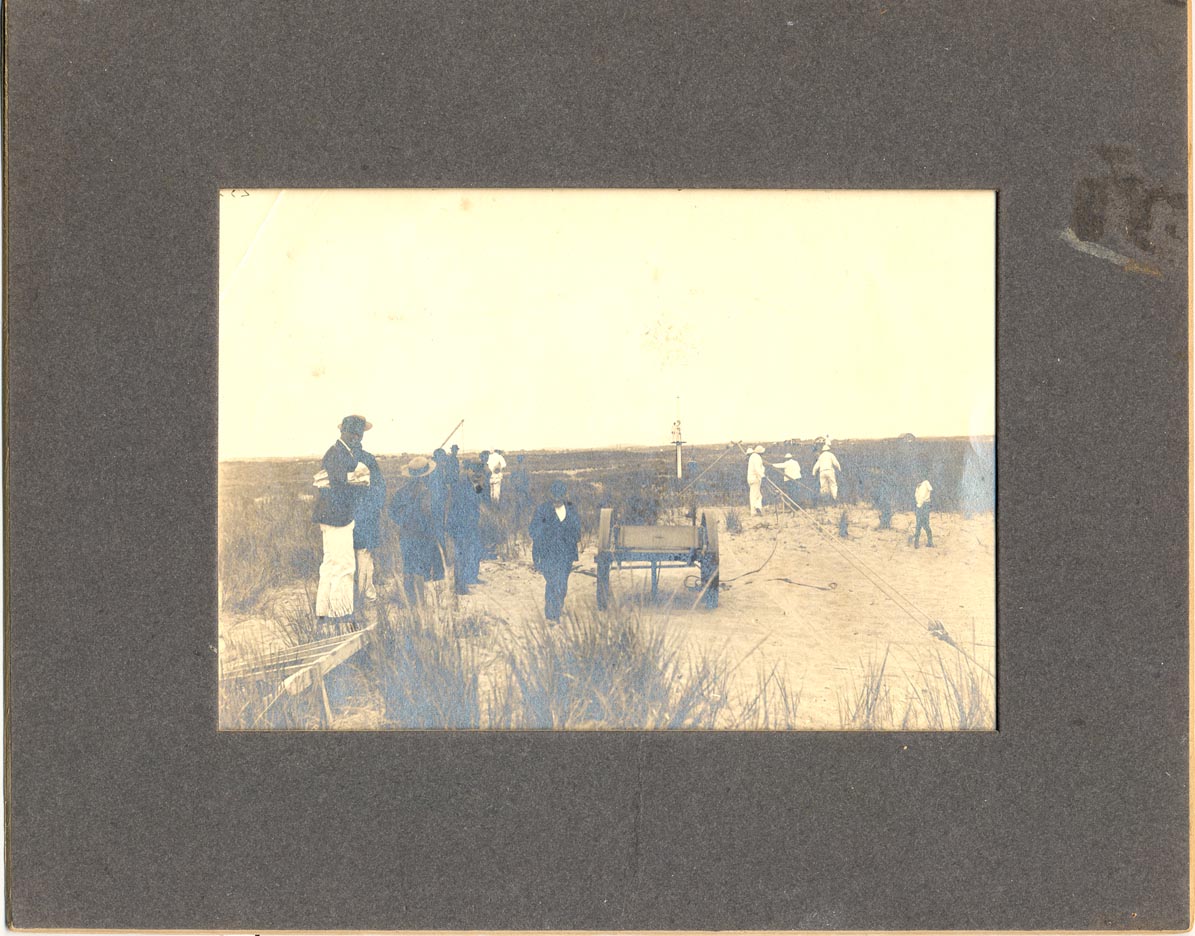
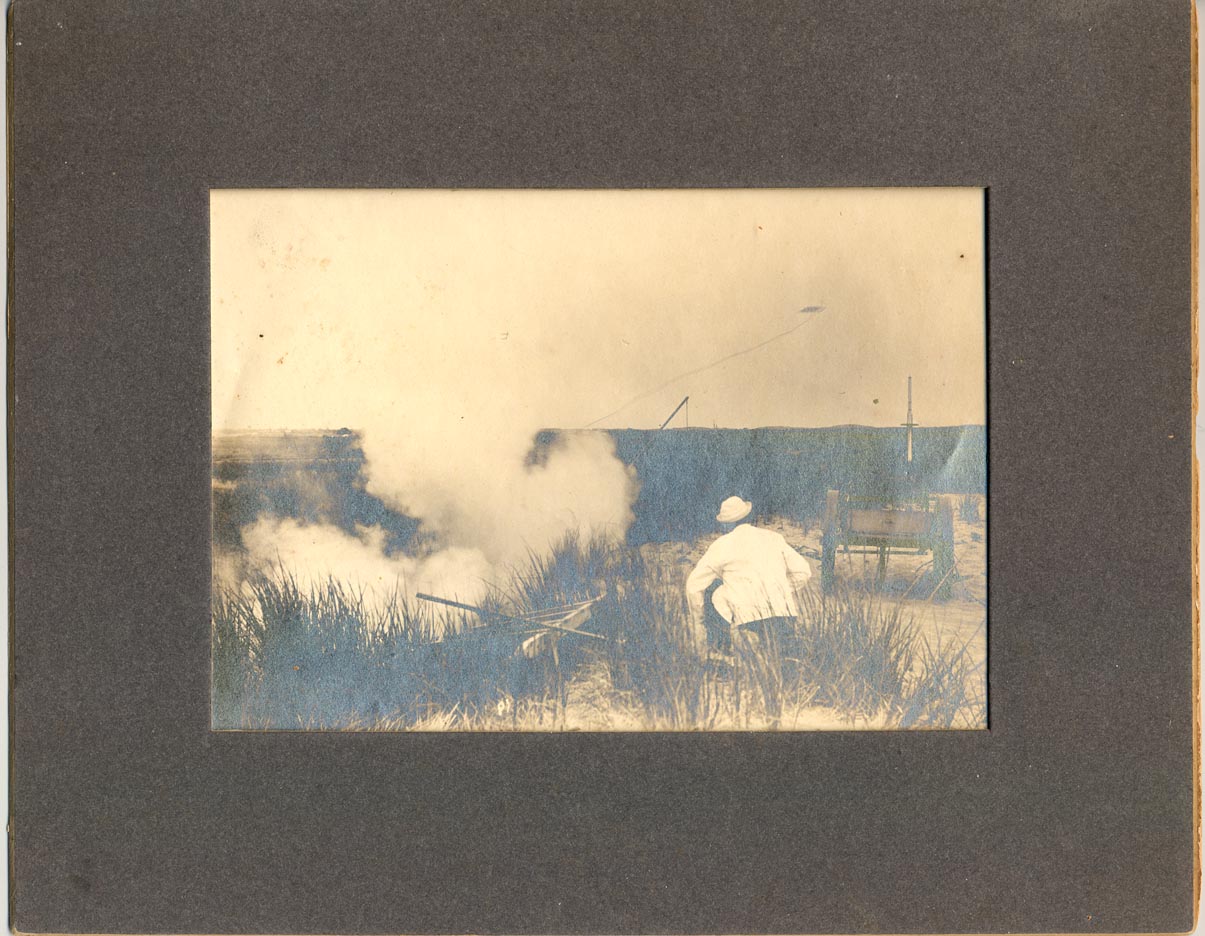
378a,b. (set two mounted
photos) Life-Saving Service Breeches Buoy Drill,
Plum Island, Mass c.1884. Large, early mounted style
photographs measure 5" x 7" and provides an extremely rare view
of the Keeper and crew of the Plum Island Life-Saving station performing
the breeches buoy drill. Quite visible is the beach apparatus cart and
rigging as the projectile is fired toward the drill pole in the distance.
These are striking early views and shows good detail of the equipment laid
out for the drill. The photos are large and quite clear and crisp, with
only a bit of foxing, one corner fold. In one view can be seen Captain
(Keeper) “Jim” Elliott. Noted on the back is also the date taken,
September 3, 1894. These are exceptionally rare lifesaving views and would
be superb matted and framed. (VG). $276 set.
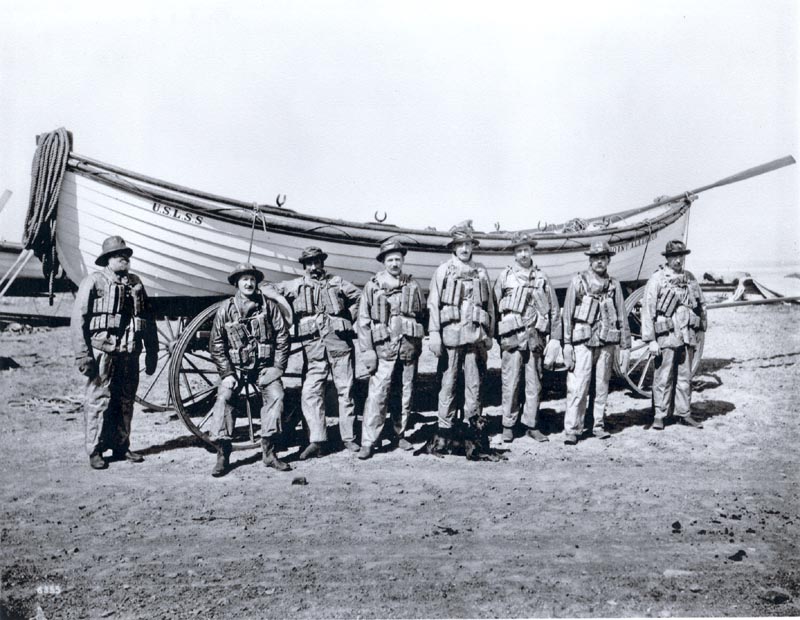
29370.
(copy photo) LIFE SAVER JOSHUA JAMES WITH CREW, Hull,
Massachusetts c.1915. 8” x 10”. Superb, crystal clear image shows
renown life-saver Joshua James posing with his crew in front of their surfboat.
Keeper Joshua James, from the
Hull
,
Mass.
Life-Saving Station, was one of the most famous life-savers in Coast Guard
history. Joshua James was associated with the Massachusetts Humane Society from
his early youth until he was made keeper of the
Hull
station of the Life-Saving Service. His sixty years of rescues and the medals
that he and his crews earned were never equaled by any other keeper or crew.
Amazingly clear, perfect for framing. $24.95 each.
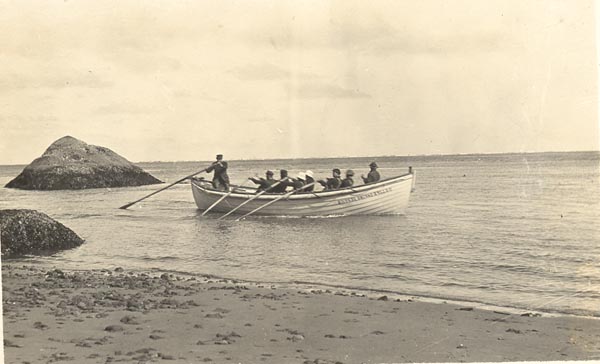
2738b.
(photo) Surfboat Underway, Coos Bay, Oregon c.1910. Clear
view measures 3 ½” x 5 ½” on postcard paper, dating from 1904-1918 based
on stamp box. Light soiling to back, few small stains, not postmarked. (VG).
$26.

8426b,c,d.
[glass slide] Some Operations of the Life-Saving Corps,
Jamestown
Exposition. #14219. c.1907 by Keystone View Company. Beautiful b/w
glass projection slide featuring the Life-Saving Service performing breeches
buoy drill at the Jamestown Exposition. The crew of six are in the foreground
pulling a seventh member from an offshore vessel. The pinstriped wheels of the
beach apparatus cart are just visible in the foreground. Slide measures 3 ¼”
x 4” and presents a superb, clear image. Includes original printed
description. (F). $32.
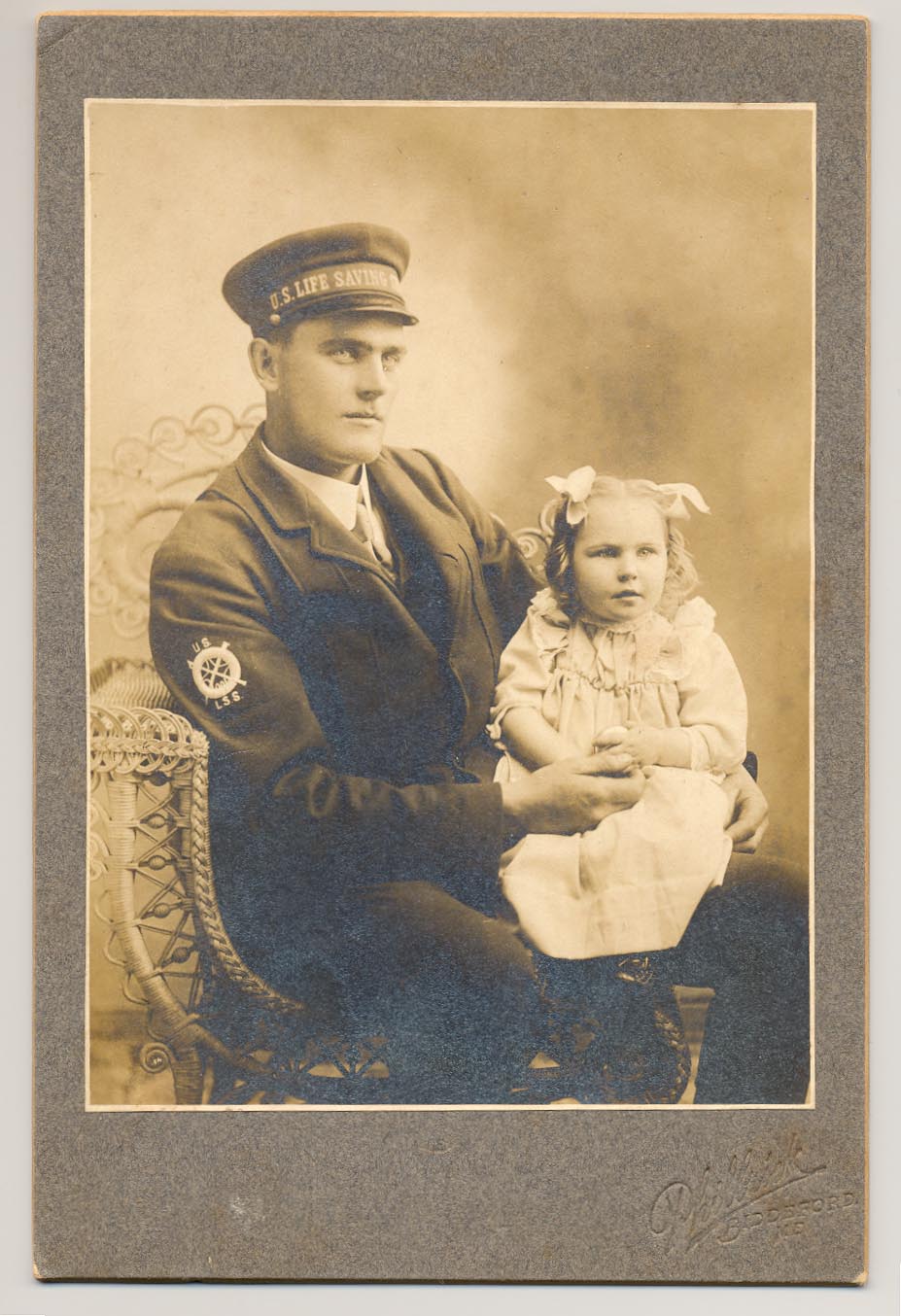
2751. [cabinet photograph] c.1900.
Original portrait photograph, of Life-Saving Service
Surfman, Biddeford Pool, Maine by Philbrick Photography, Biddeford, Maine.
c.1890-1910. This rare posed portrait photograph shows the handsome
young surfman proudly posing in his 4-button single-breasted uniform coat,
holding his young daughter Thelma on his lap. View is labeled on the obverse as
Everet Shurling with Thelma. Clearly visible on his right sleeve is the life
ring with crossed oar and pike and the letters “US” “LSS”, and his
uniform cap with “U. S. Life Saving Service” clearly visible on the band.
The image measures 3 ¾” x 5 ” on a 4 ¼” x 6 ½” original
mat. Mat stamped “Philbrick Photography, Biddeford, Maine”. Rare both for
the presence of a family member, and that it is labeled so we know the identity
of this young surfman, this is unusually close and clear, one of the
better images we have had in some time. Little or no wear, a perfect piece for
framing. (F-). $295.


29290.
(photo) Breeches Buoy and Crotch c.1900.
Nice view of breeches buoy and crotch, with wreck probably off the edge of the
view. 3 ½” x 4 ½”. (VG). $18.
29291a,b.
(photo) U.S. Life Saving Service Station, Treasury
Department Exhibit, World Exposition c.1900. Nice view of the
temporary station set up for an exposition, includes boatramp, motor lifeboat on
railway, with signal flags flying overhead. 3 ½” x 3 ½”. (VG). $16.
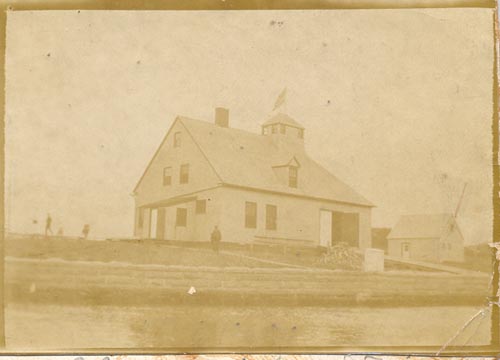
29216a,b. (photo) U.
S. Life Saving Station. Unknown location, may be a Bibb #2 or a
Quonochontaug-Type station. 2 ½” x 3 ½”. Pasted on album remnant,
some wear, soiling. (G+). $8.

2569. (photo) U.
S. Life Saving Station. Unknown location, may be a variation of a
Duluth-Type station. 2 ½” x 3 ½”. Clean, crisp. (VG). $10.
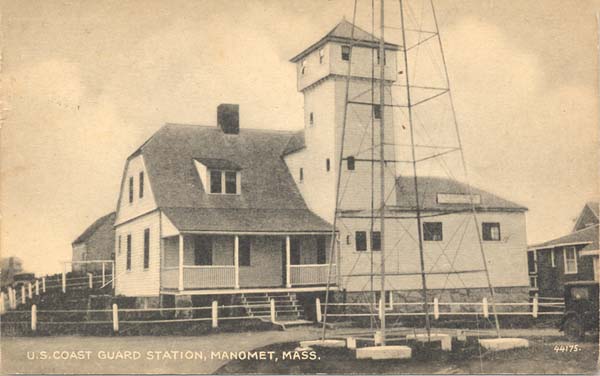
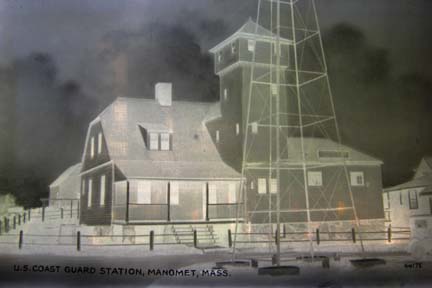
29187. (negative) U.S.
Coast Guard Station, Manomet Point, Mass. c.1940. Clear close
negative captures nicely the 1901 Duluth-Type life-saving station. In 1928, the
station surfboat was tossed end over end with the loss of Keeper William Cashman
and surfmen Griswols and Stark while attempting to rescue the crew from the
“Robert E. Lee”. This negative was used by the E.D. West Company of South
Yarmouth to produce their postcard #44175 during that era. Large image measures
3 ¾” x 5 ½” and is clear and close. Would provide a great clear image.
Includes original postcard view as well. (VG+). $24.
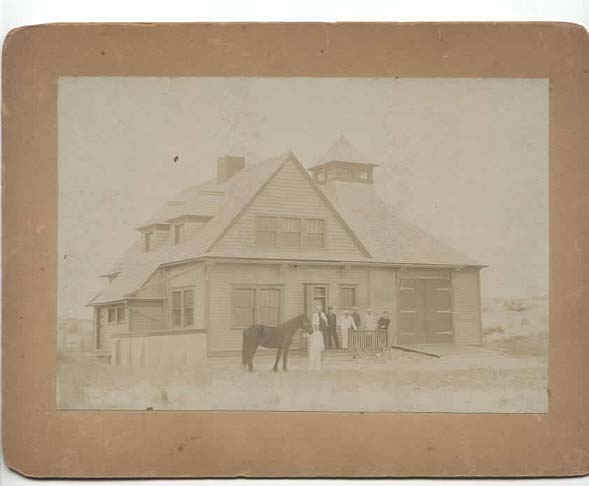
24157c. (photo) Point
Allerton Life Saving Station c.1890. Early view, clear, close.
4 ¾” x 7” on 6 ½” x 8 ½” original mat. Superb view includes
station crew and keeper posing on the front stoop with their station
horse. Point Allerton Lifesaving Station was opened on October 15th, 1889
at Hull, southeast of Boston and "west one mile of Point Allerton"
with with renown lifesaver Captain Joshua James being appointed as its
first keeper at age 62. Keeper James served until his death "in
the line of duty" on March 19th, 1902. Just a bit light, little if
any soiling or foxing. (VG). $225.

26127a.
(photo) Landing U.S. Life Saving Service Motor
Lifeboat, West Coast c.1907-1914. Clear view though a bit distant
shows crew landing motor surfboat. On the bow can be seen the bronze life ring
with crossed oars insignia. Clear view measures 3 ½” x 5 ½” on postcard
paper dated to 1907-1914. Light wear. (VG). $22.
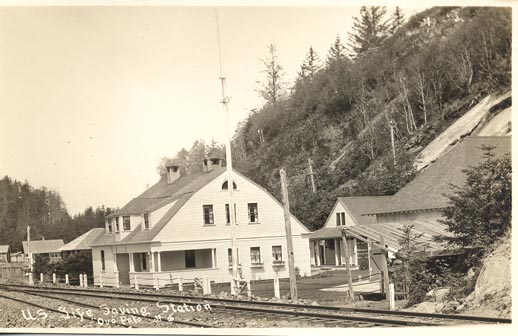
2654b.
(photo) U.S. Life Saving Station, Tillamook Bay
(Barview), Oregon c.1910. Clear view shows the rare Peterson Point
Type station, unique to the west coast. Today this station is a private
residence, the only example of this type of station left in existence. View
measure 3 ½” x 5 ½” on postcard paper. Clean, crisp. (VG+). $24

27396.
[stereoview] Drill of the U. S. Life-Saving
Service, Louisiana Purchase Exposition c. 1904. by Universal Photo
Art Co., C. H. Graves,
Philadelphia
. Clear image shows life-saving crew at exhibit righting their capsized lifeboat
for the watching crowd. Visible are the crew and their boat “Intrepid”, and
the throngs watching from shore. Clean, clear, nice view. (VG+). $44.
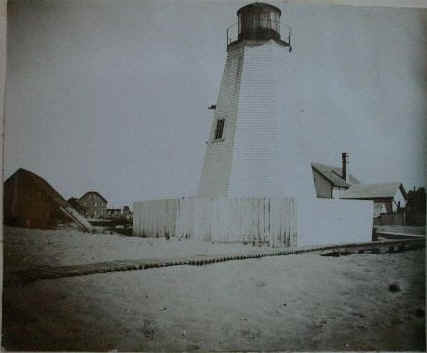 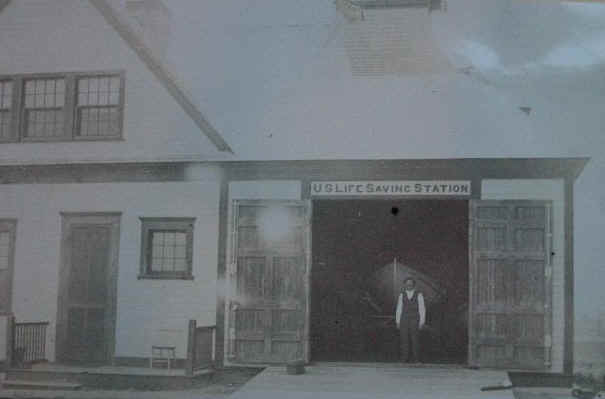
27454.
(photo album)
Plum
Island
and
Newburyport
,
Massachusetts
c.1890’s. Vintage Newburyport
,
Massachusetts
photograph album. This great little album measures 7 ½” by 5 ½” inches
and contains 44 photos, many well done. Included is a lovely close photo of the
white octagonal
Plum
Island
Lighthouse. In 1838 the original twin octagonal lighthouses on this spot were
replaced by a new pair of octagonal towers built on moveable foundations. In
1856 one of the lighthouses was destroyed by fire and it was decided not to
rebuild. The surviving lighthouse received a fourth order Fresnel lens and
remains today. In addition, a second photo provides a close view of the Bibb #2
Type station on
Plum
Island
at the
Merrimack
Ri
ver
. Other images include beach scenes, a nice view of salt marsh hay stacks, a
beach cottage labeled "Hardy's, river scene with early ship (may be in the
Merrimack River),
New
England
church, colonial homes, family scenes, etc. Sizes vary, the average being about
4 x 3 ½” inches. About a dozen or so photos show fading or lightness from
exposure problems, others are clear and sharp. (VG-). $168.
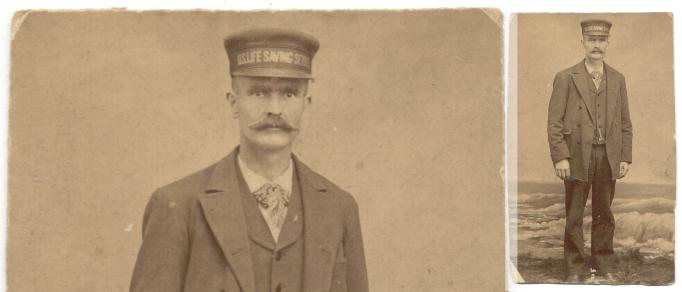
25111. [photograph] c.1890. Original
studio portrait style photograph of a Life-Saving
Service Surfman. This rare posed portrait photograph shows the
surfman proudly posing in his double-breasted uniform coat. Clearly visible on
his cap is the lettering “U.S. Life Saving Service”. The photo measures 3”
x 5” and has been crudely trimmed. There is no photographer’s marking or
label. Photo is fairly clean and clear, provided good detail. It is quite rare
to see such photos. (VG-). $152 net.
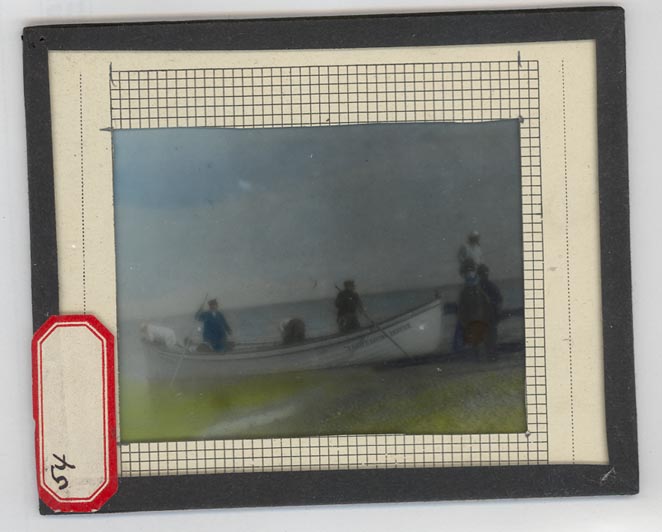
26137.
[original glass plate negative] Life Saving Service
Landing the Surfboat. c. 1900-1915. Wonderful glass plate slide bears
a full color photo image of the keeper and surfmen ashore with their surfboat as
a finely dressed Victorian woman looks on. Clearly visible on the surfboat is
the “U. S. Life Saving Service” marking. Nice view of the keeper and men.
(VG). $68 net.
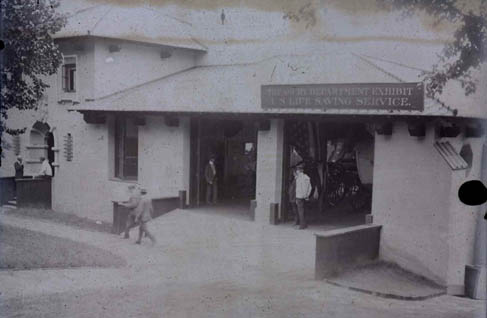
22386.
[glass negative] Treasury Department Exhibit U. S.
Life-Saving Service. c.1900. Unusual b/w glass negative featuring the
Life-Saving Service exhibit building [station], probably at a world’s
exposition at the time. The building is well detailed as is the surfboat and
additional equipment inside the boatroom doors. Negative is large 4” x 5”
and would provide a large clear print. A superb, clear image. (VG). $74 net.
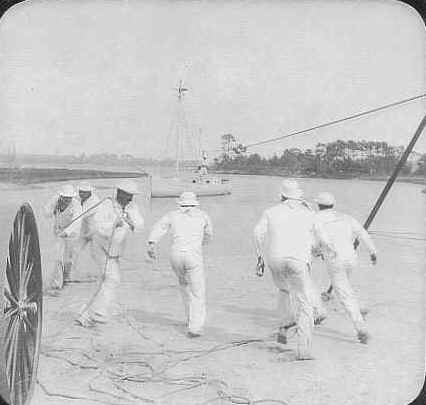
2384a,b. [stereoview] Some
Operations of the Life-Saving Corps, Jamestown Exposition. #14219.
c.1907 by Keystone View Company. Beautiful b/w glass projection slide featuring
the Life-Saving Service performing breeches buoy drill at the Jamestown
Exposition. The crew of six are in the foreground pulling a seventh member from
an offshore vessel. The pinstriped wheels of the beach apparatus cart are just
visible in the foreground. Slide measures 3 ¼" x 4" and presents a
superb, clear image. (F). $48.
2018. [stereo view] United
States Life-Saving Exhibit, Louisiana Purchase Exposition. c.1904 by
Keystone View Company. A detailed, close view showing the life-savers righting
their capsized 34-foot motor lifeboat in drill, in front of a large crowd at the
Louisiana Purchase Exposition. This is a wonderful, clear early view and shows
good detail of the men, their uniforms and the lifeboat. Clean, some wear to
image and mount. (G+). $32.
6283. [stereo view] Some
Operations of the Life-Saving Corps [Service], Jamestown Exposition.
#14219. c.1907 by Keystone View Company. Same beautiful clear b/w image as
above, featuring the Life-Saving Service performing breeches buoy drill at the
Jamestown Exposition. On the back is a lengthy description of the work of the
Life-Saving Service. Clean, crisp clear view. (VG). $26.
[same] Creased through one image. (F). $10.
920. [stereo view] Life-Saving
Station near Cliff House, San Francisco, California. c.1900 by
Underwood & Underwood. A clean, clear view showing bridge and cable
arrangements to offshore rocks. In the foreground is a heavy winch and jib
arrangement, making us somewhat unsure as to exactly what portion of the station
this might be. Is this view of construction equipment, or was the rocky area
used to launch their boats? Your guess? Nevertheless, it is a clear, clean view
and quite interesting. (VG). $58.
Narragansett Pier Life Saving Station
Crew c.1880 - 1900.
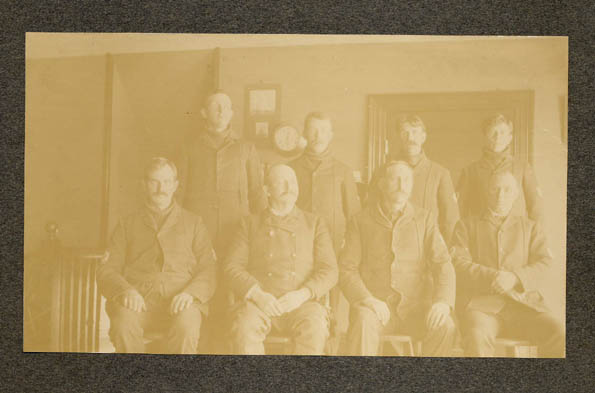
27381.
(mounted photo) Narragansett Pier Life Saving Crew
posing in the station eating area. c.1904. Clear close photo dated
April 1904 shows Captain Albert Church posing with his crew seated inside the
station. Keeper Church is man in center with the double breasted uniform jacket.
Behind the crew can be seen the early Life Saving Service clock on the wall.
Image measures 3 ¼” x 5 ½” on 5” x 7 ½” black mat. Extremely rare to
find such interior views. Clean, crisp, near fine view. (VG+). $325
Original Uniform
Buttons
Rare, original uniform coat buttons
are available in different styles as described below. Pricing from $26-36. Sizes
and backmarks vary. All guaranteed original, in VG or better condition.
United States
Life-Saving Service

#6514.
Life-Saving Service. Life ring with
smaller oar and hook, with "U.S." over "L.S.S.", plain
border. (FD 18*)
Life-Saving Service. Life ring with smaller oar and hook, with "U.S."
over "L.S.S.", rope edging. (FD 19*) Prices range from $26 - $38
depending on size and condition.
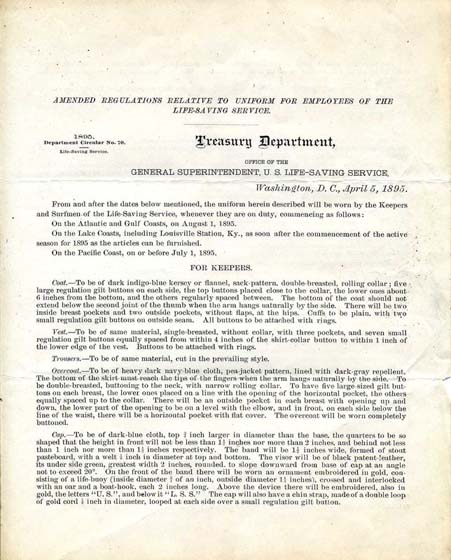
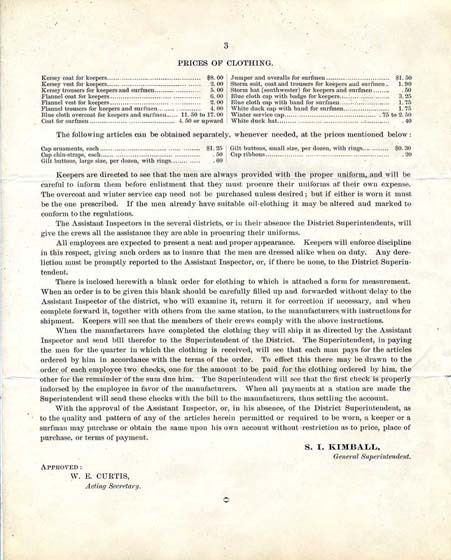
1244. (copy) Treasury Department. U.S.
Life-Saving Service. Amended Regulations Relative to Uniform for Employees of
the Life-Saving Service. April 5, 1895. 3p. Extremely rare document
prescribes complete uniforms to be worn by Keepers and Surfmen whenever they are
on duty. Includes coats, vest, trousers, overcoat, caps, jumpers, buttons,
suits, storm suits, overalls and more. Also prescribes prices, ordering
practices, inspections by Assistant Inspectors, etc. Extremely rare information.
(photocopy $4).
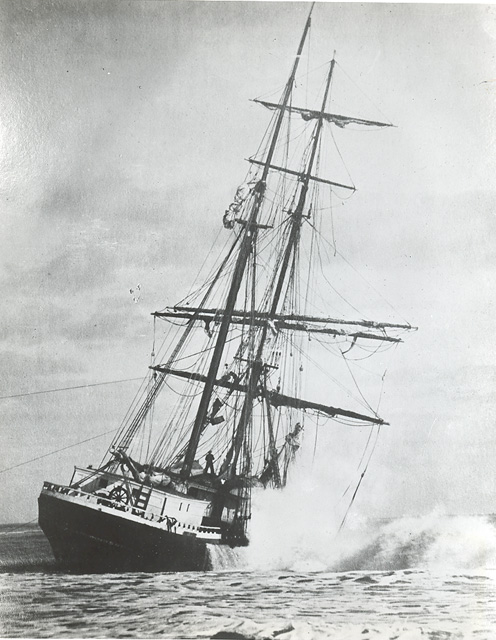
11292. (copy photo) “Schooner
wrecked on reefs being swamped and dashed to pieces by pounding surf.
Several crew men up in the rigging.” Date of wreck January 5, 1927. Official
Coast Guard copy photo from Office of Historian. Nice view, b/w, 8” x
10”. $8.
Reproduction
of the Original United States Life Saving Service Pennant.
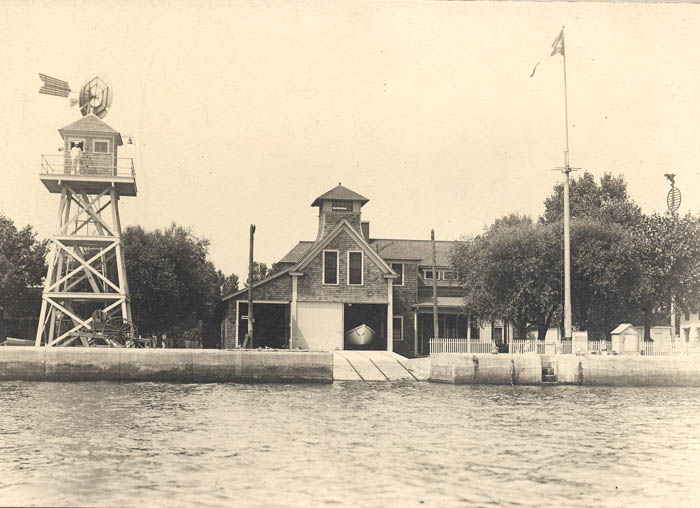 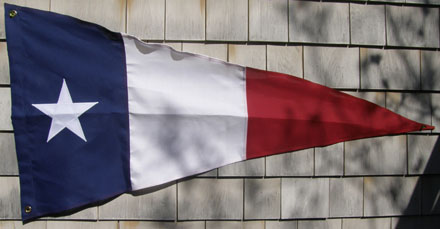
Treat
your family to this replica of the official sewn U. S. Life Saving Service
flag. Flag is professionally made of high quality flag material, with sewn hem
and brass grommets for attaching to halyard. Professionally made and will last
longer than most others that you may find. Our pennants are flown at stations
across the country as well on vessels of the U. S. Coast Guard and have received
the highest praise.
27463.
[reproduction] U. S. Life Saving Service Station
Flag. This triangular station flag measures 48” long by 25”
and is typical of the flags once flown at Life Saving Service stations to
identify them as such to vessels at sea. The flag is of the standard
design instituted by General Superintendent Sumner I Kimball, with blue,
white and red fields and one white star. Heavy duty for moderate weather conditions. Made in
America. (M). $89.95.
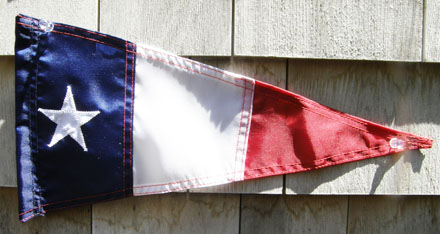
27463M. (miniature reproduction) U.
S. Life Saving Service Station Flag for Presentation or Framing. 8” x 16” This
triangular station flag measures 8” long by 16” and is of the design once
flown at Life Saving Service stations to identify them as such to vessels at
sea. The flag is of the standard design instituted by General Superintendent
Sumner I Kimball, with blue, white and red fields and one white star. Our flag
weight nylon miniature is one sided, appliquéd, no grommets, perfect for
framing or as a presentation piece. Made in USA.
(M). $49.95.
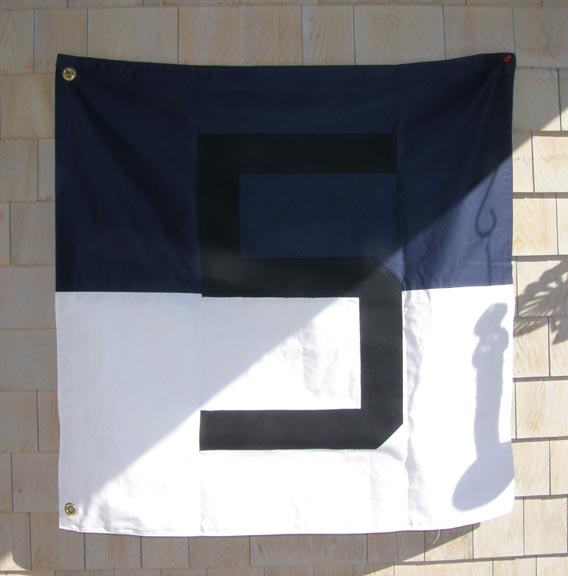
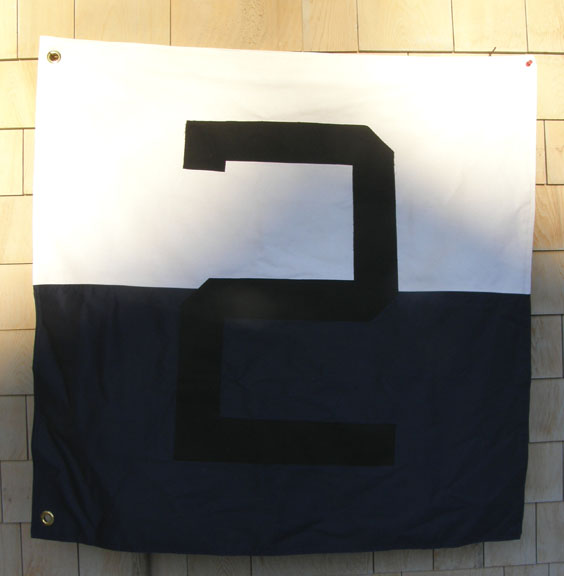
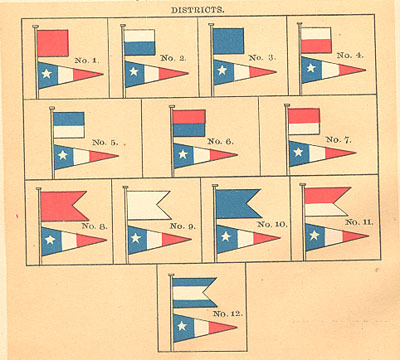
12239. [reproduction] U.
S. Life Saving Service District Number Flag. This square district
flag measures 38” by 38” and is typical of the flags once flown at Life
Saving Service stations to identify the Life-Saving District as such to vessels
at sea. The flag is of the standard design instituted by General Superintendent
Sumner I Kimball. Each district had a distinct design and colors, with the
district number in black. Heavy duty for moderate weather conditions. Made in
America. (design for District #5 as shown above) $98.95.
Page updated June 29, 2022
Procedure
to order items:
1. I suggest that you call us or
email to check on availability of any item that you would like other than
recent books. As items go quite quickly, please call and leave a message to
reserve items that you would like. I will return your call, hold the items and
await your letter or credit card information. We will also weigh the items and
advise postage.
2. You may then call or email credit
card information, or forward a check in the mail.
Most items are mailed US Priority Mail
or UPS. Additional information on our "Ordering Page".
Massachusetts residents must add 6.25% sales tax.
Can't find what you are looking for?
We can help you find that needed book or item.
mailto:[email protected]
How to reach us:
Kenrick A. Claflin & Son Nautical Antiques
1227 Pleasant Street, Worcester, MA 01602
Phone (508) 792-6627
All
text and illustrations on web site Ó
James W. Claflin . 06/29/2022
All rights
reserved. Use prohibited without written permission.

|










 (photo not included)
(photo not included)












































































































































































 (postcard
view not included)
(postcard
view not included)



 (photo not included)
(photo not included)









 (later view Mecox LSS)
(later view Mecox LSS) 













 (postcard
view not included)
(postcard
view not included) (image
courtesy Bangor Public Library)
(image
courtesy Bangor Public Library)






































































































